September 29, 2022 - Cleveland
|
|
In late September, Lynnette and I spent a few days with some long-time friends touring the city of Cleveland, Ohio. Lynnette and I have never been to Cleveland. We would have flown the RV to Burke Lakefront Airport (KBKL) which was within walking distance of our AirBnB and the Rock & Roll Hall of Fame. Our friends were driving some Indiana so they had a car. But the weather was absolutely atrocious on both our travel days. I mean, not only did it rain hard, but the clouds were lower than the mountain tops as we drove through the mountains. So we ended up driving to Cleveland. Wasn't a bad drive, really. Six or seven hours. Still, it would have been more fun to fly than drive.
Of course, the first thing we did, was visit Cleveland's number one attraction: the Rock & Roll Hall of Fame.
|
| |
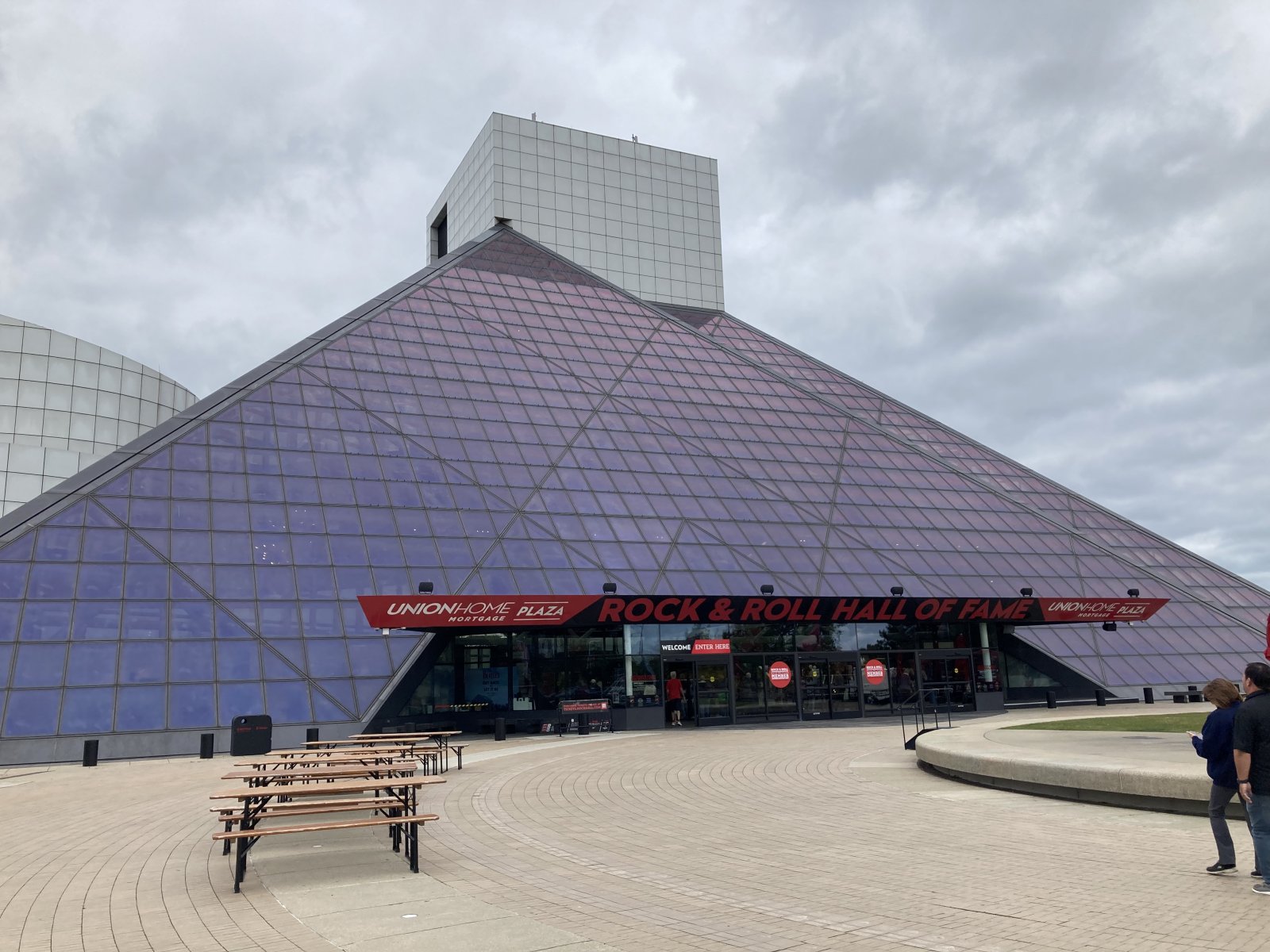 |
|
|
You may be wondering why the Rock & Roll Hall of Fame is in Cleveland, of all places. A good question. Well, it turns out that Cleveland has a good claim as the birthplace of Rock 'N' Roll. See below. Who knew?
|
| |
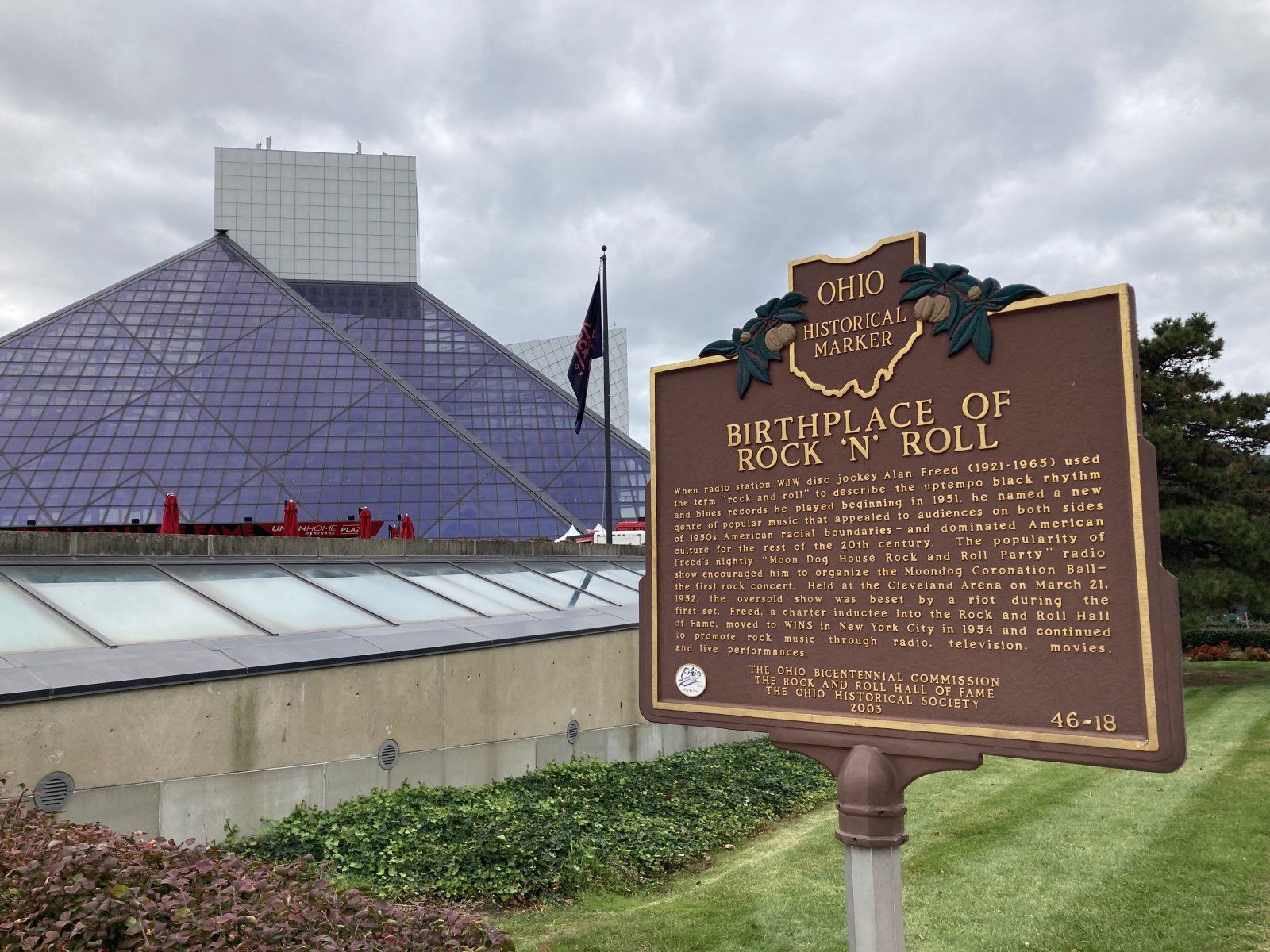 |
|
|
The RNR HOF is in a pyramid-shaped building. You start out in the basement, which is the largest area, and has the history of Rock and Roll. There are a lot of guitars, costumes, album covers and scripts. Plus stuff to read.
On the right is a black dress worn by one of my favorite singers: Stevie Nicks.
|
| |
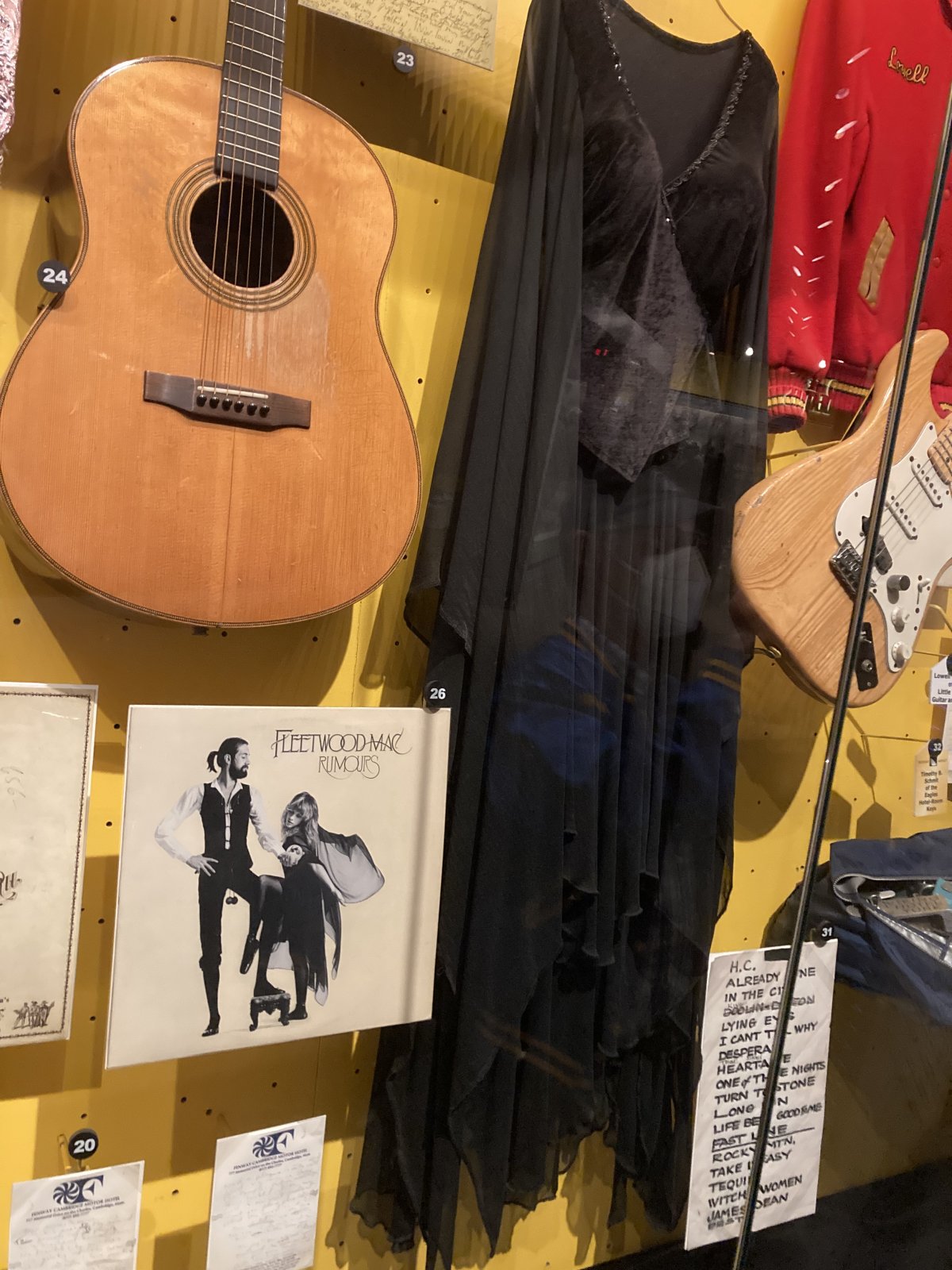 |
|
| There was a ton of stuff on the Beatles, and to a slighly lesser extent the Rolling Stones. This piano that was in the basement of a house in central London where Paul McCartney lived for three years. Paul McCartney and John Lennon composed some of their iconic songs using this piano. |
| |
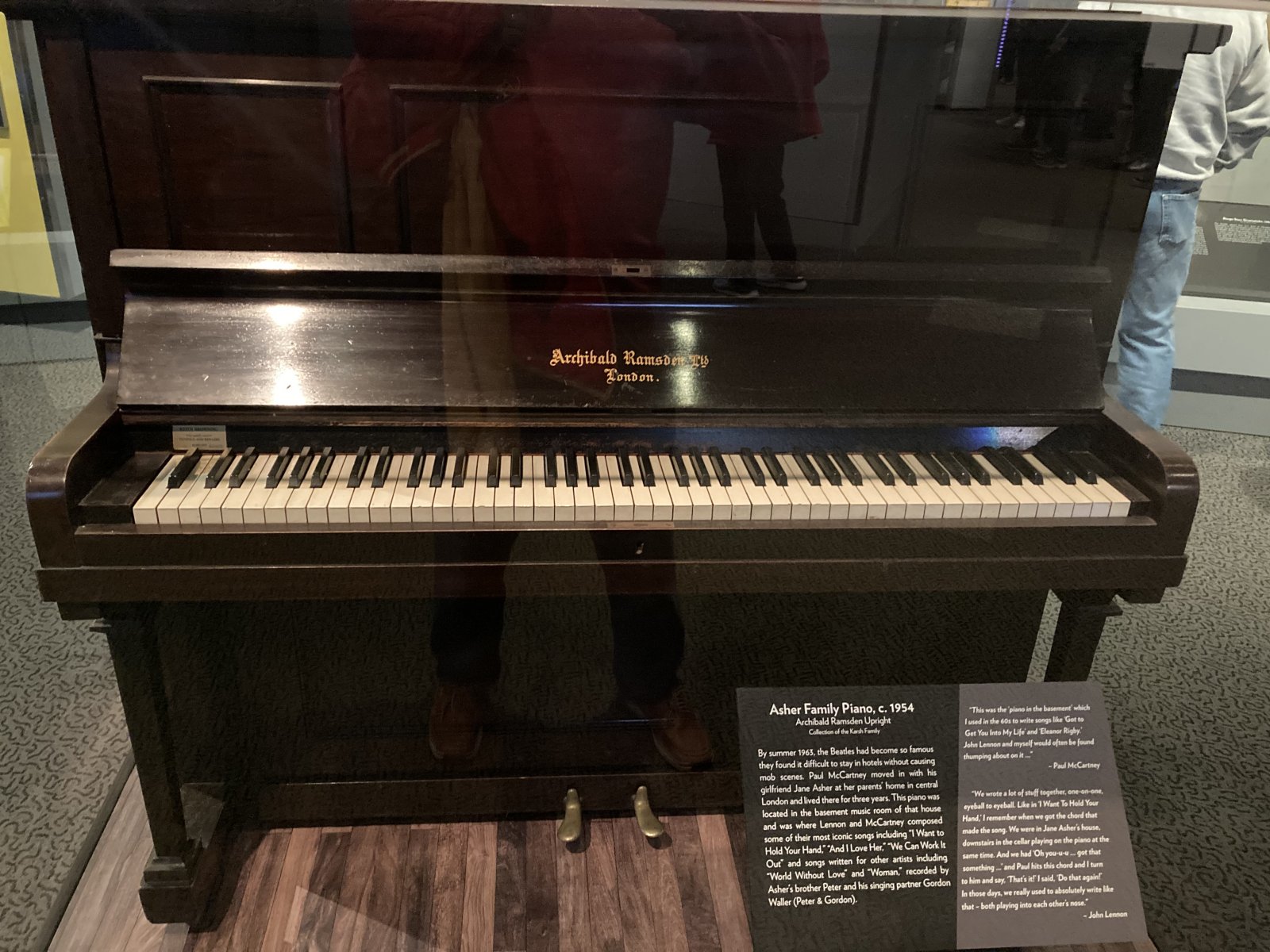 |
|
|
After the history, there was a section featuring various Hall of Fame artists/bands. Like this one, featuring one of my singers -- Crissie Hynde -- and also the entire band The Pretenders.
One thing noticibly missing in the HOF was the darker side of Rock 'N Roll: the drugs, sex, etc.
|
| |
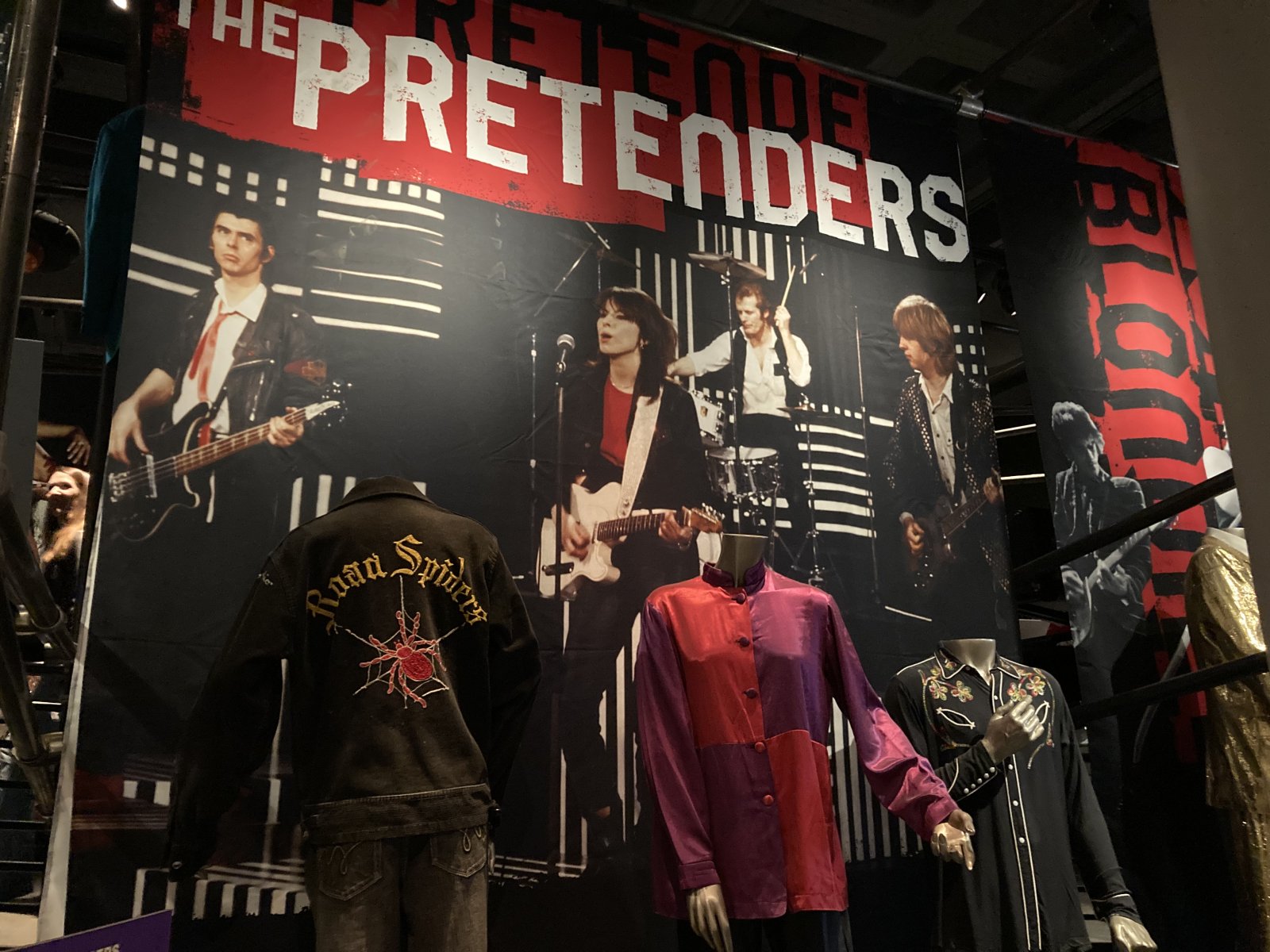 |
|
| The Beatles in their prime. |
| |
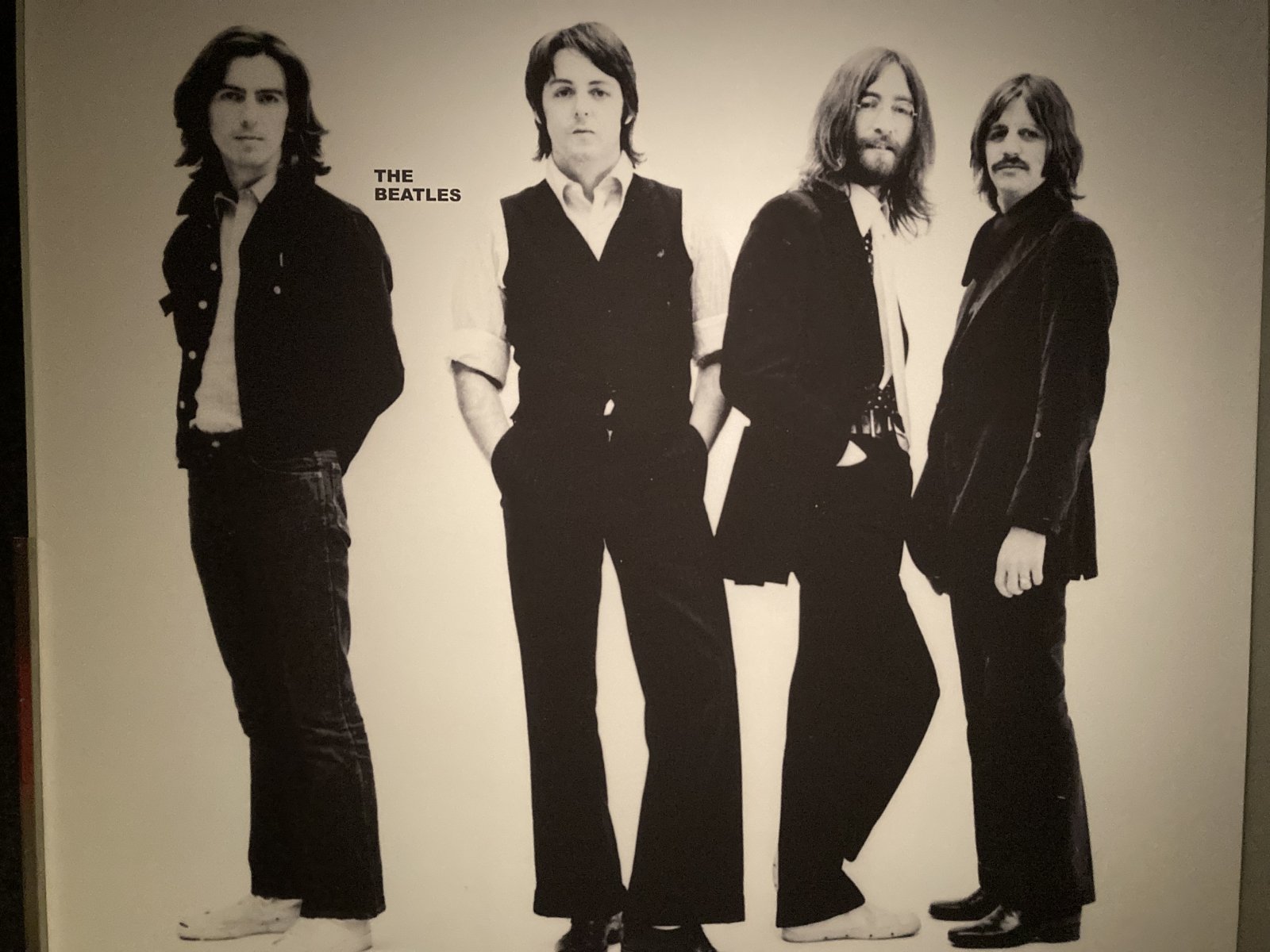 |
|
| There was also a lot on Elvis. |
| |
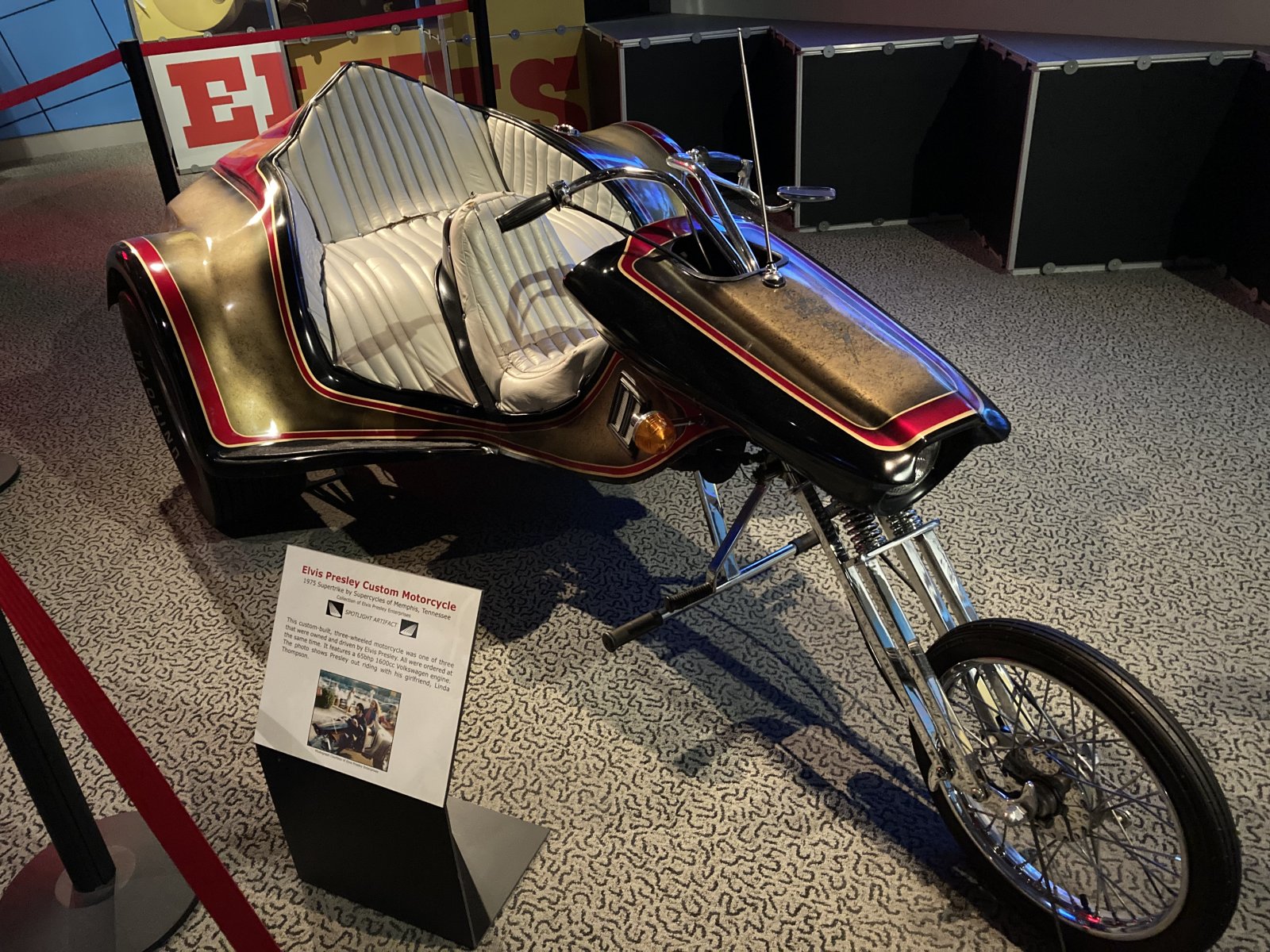 |
|
| Coming up from the basement area into the main lobby where you can get lunch. |
| |
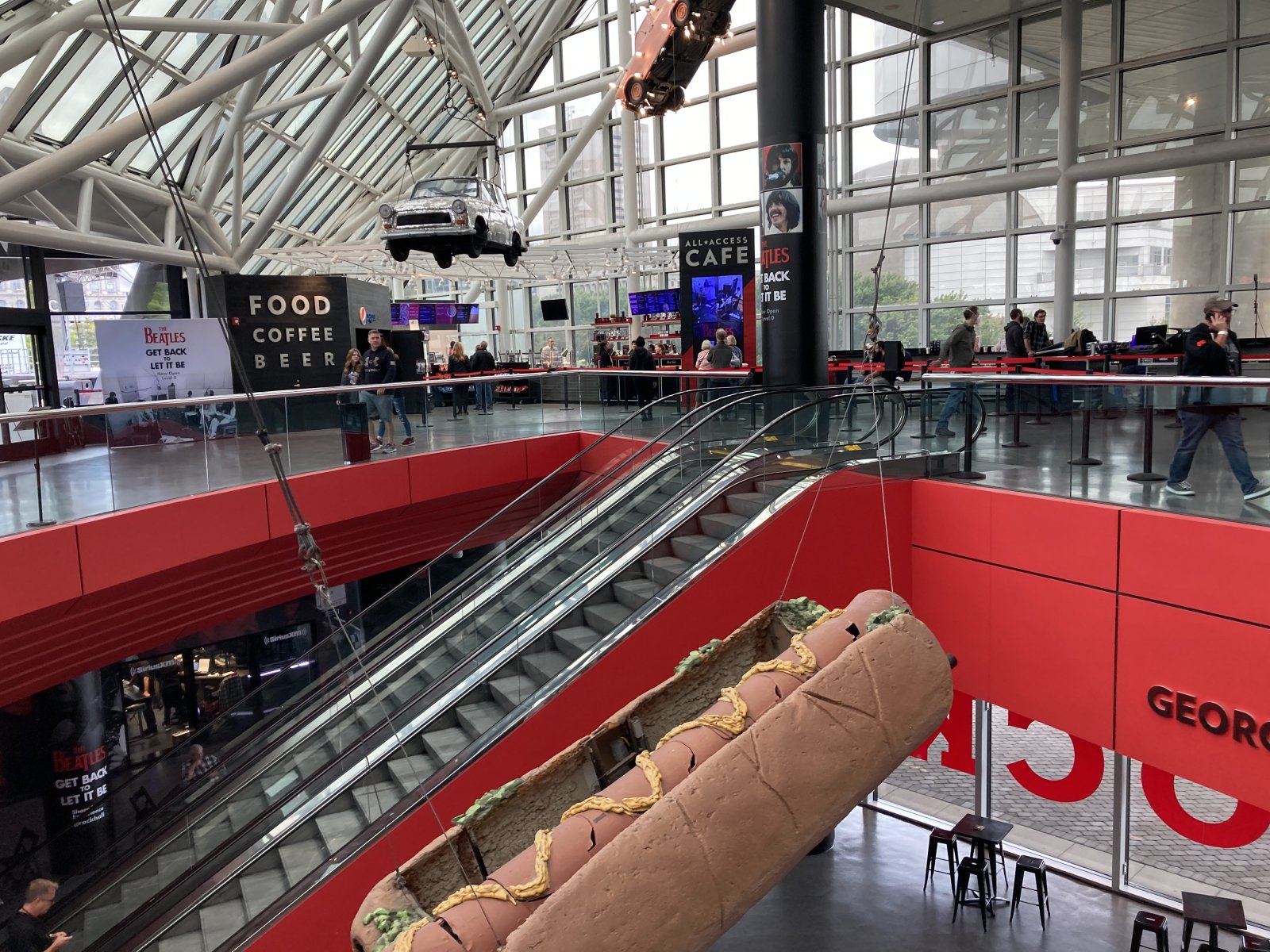 |
|
|
Also in the main lobby area was a stage. The famous John Mellencamp would be here in the late afternoon to sing a few songs live. People were already lining up for that.
|
| |
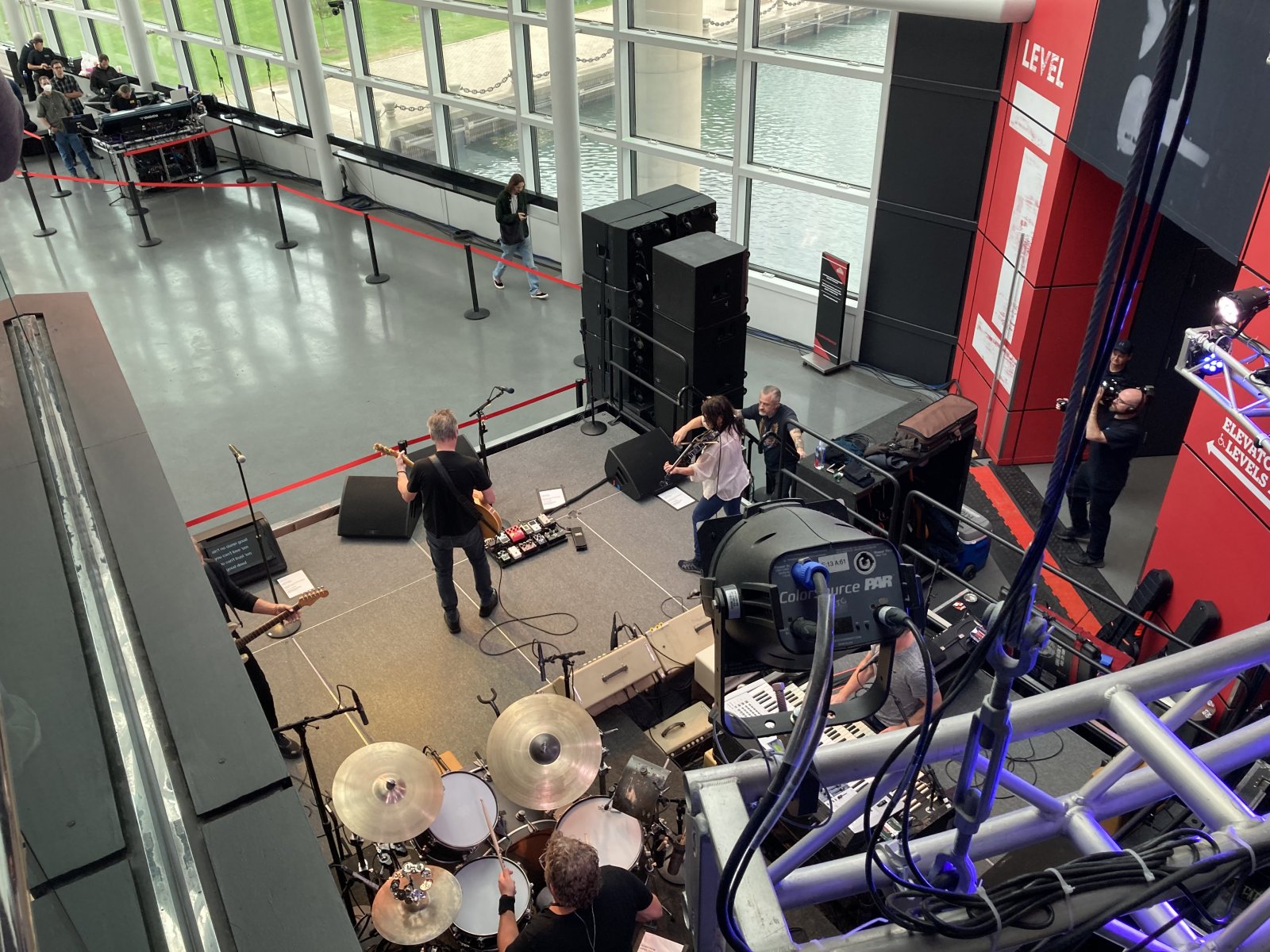 |
|
| |
| |
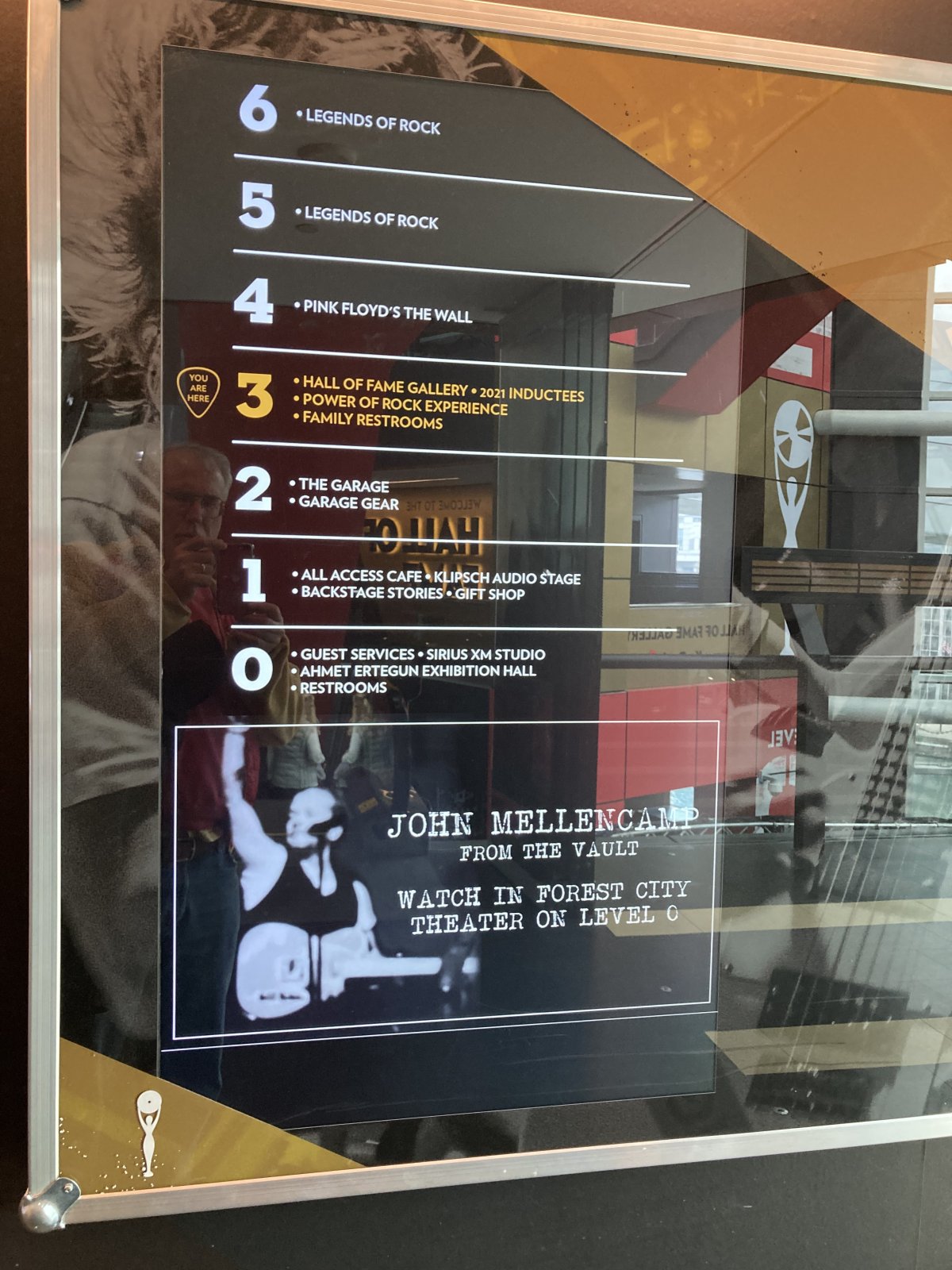 |
|
|
Level 2 was called "The Garage" and was kinda cool. You could play an electric guitar, tickle the keyboards or bang on the drums. Here, Lynnette is playing "Sweet Child Of Mine".
|
| |
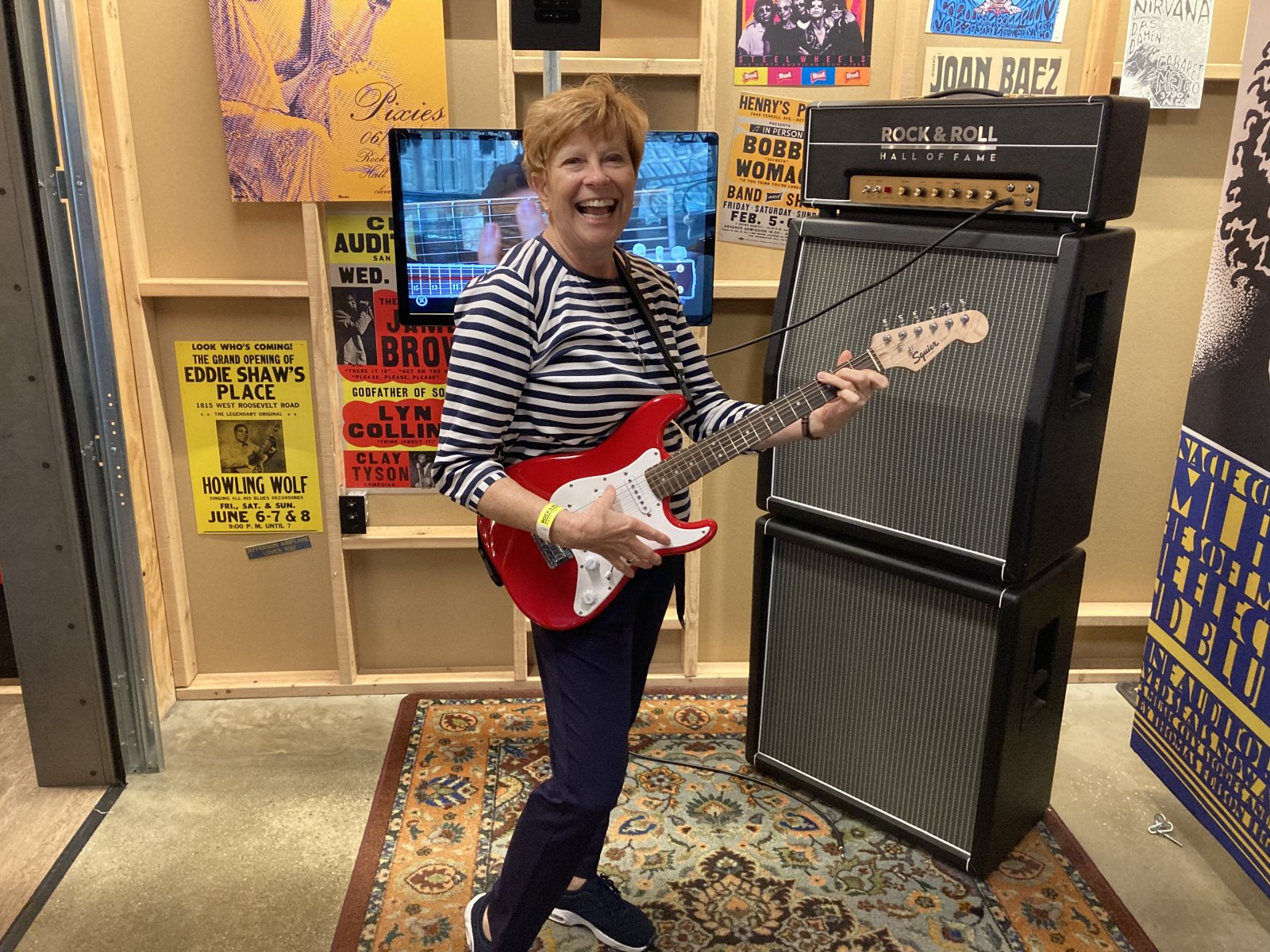 |
|
| Lynnette knows how to play the piano. Here she is playing "Come On Baby, Light My Fire". |
| |
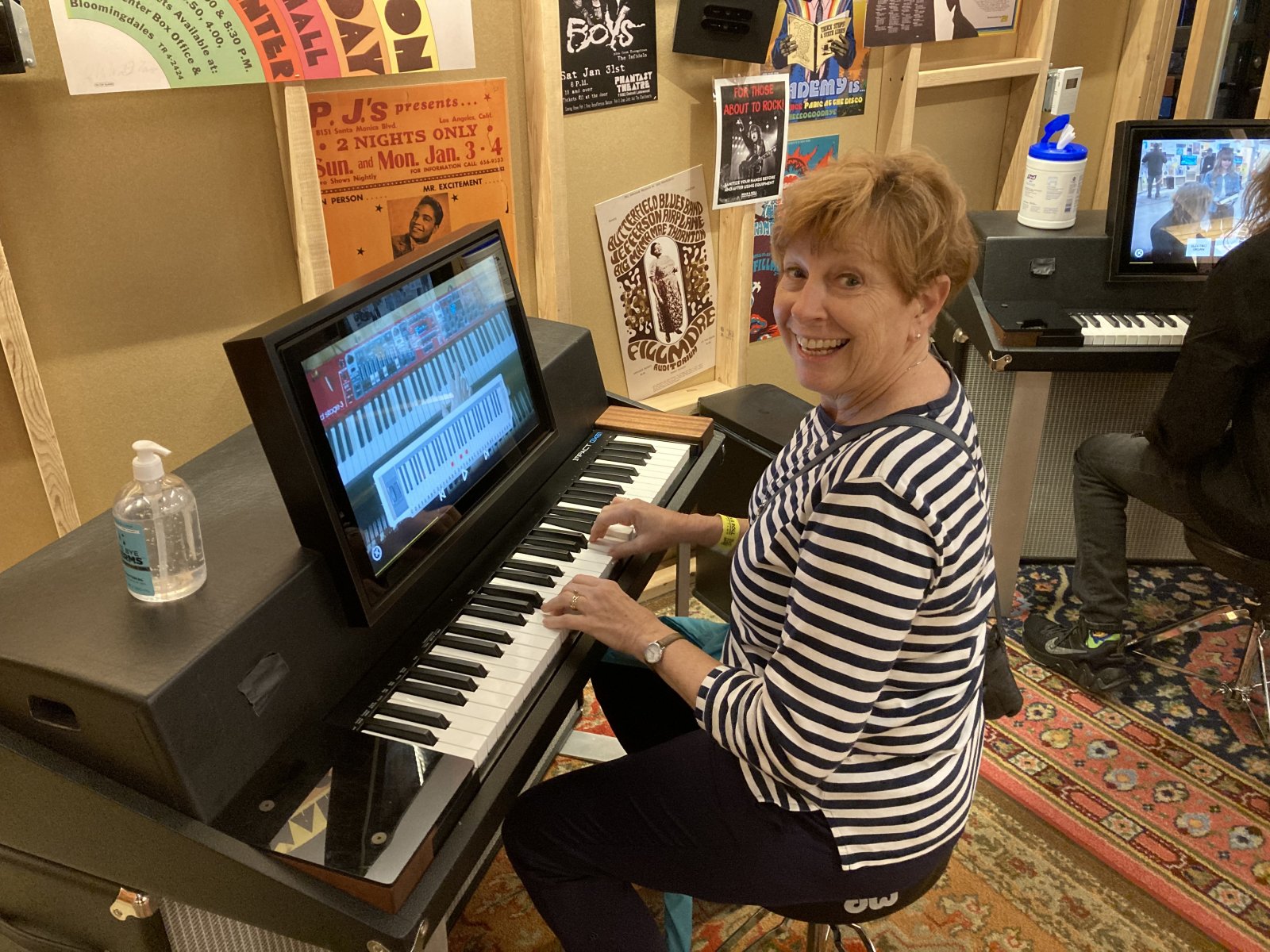 |
|
| There was even a couple of sound rooms where an entire band could come in and jam. |
| |
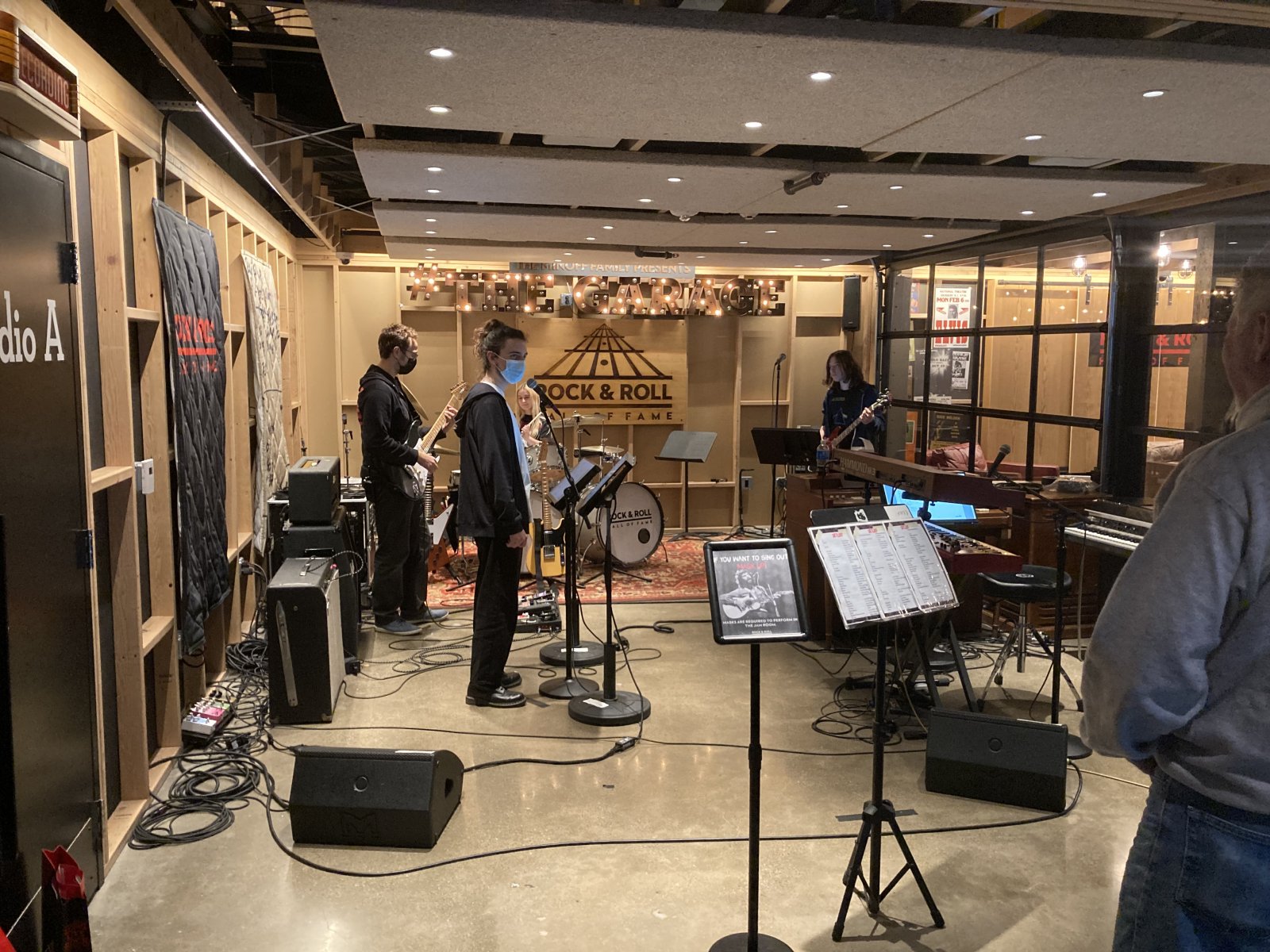 |
|
| Also on this floor was the "Power of Rock" experience which was sort of like an IMAX thing featuring many different artists. |
| |
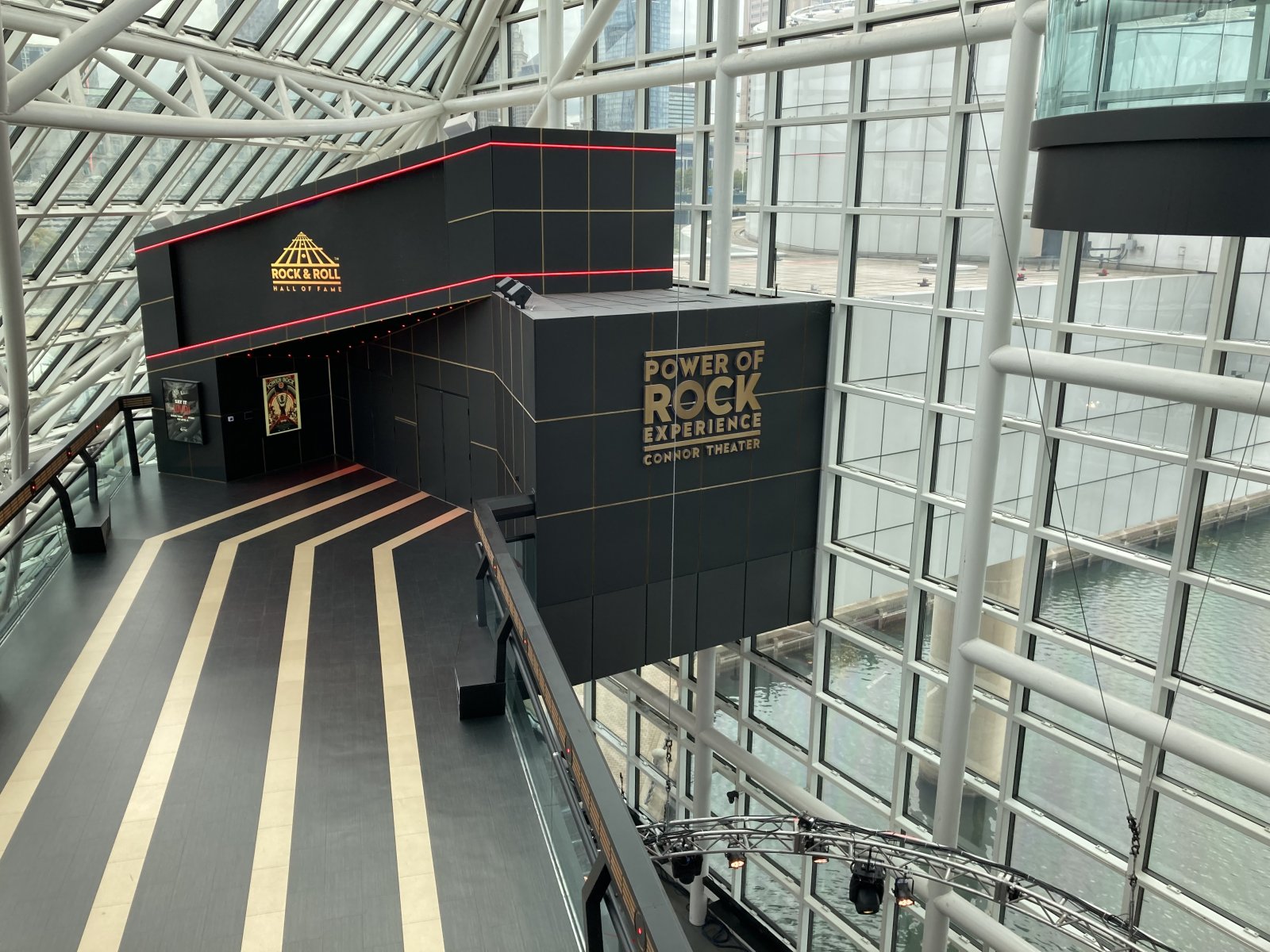 |
|
|
Level 3 was the actual Hall of Fame gallery. Regretfully, I didn't take a single picture, for some reason. The gallery was organized by year, displaying a plaque for each artist or band elected to the Hall of Fame in that year. They also had a computer thing that you could listen to the acceptance speech of the artist/band. I thought it a little underwhelming. I think it would be nice if they could also have a picture of the band or artist, along with something about them.
What I did take a picture of were computer displays showing the top 100 artists who people think "should be" inducted into the Hall of Fame. I was shocked by how many great artists who are NOT in the Hall of Fame. I couldn't believe such artists as Boston, Jimmy Buffett, Jethro Tull, George Michael, Huey Lewis and the News, Billy Idol, Kansas, Peter Frampton, Supertramp, Ted Nugent, The B-52s, and Blue Oyster Cult were not in the Hall of Fame. Many of the guys in the Hall of Fame I've never heard of.
|
| |
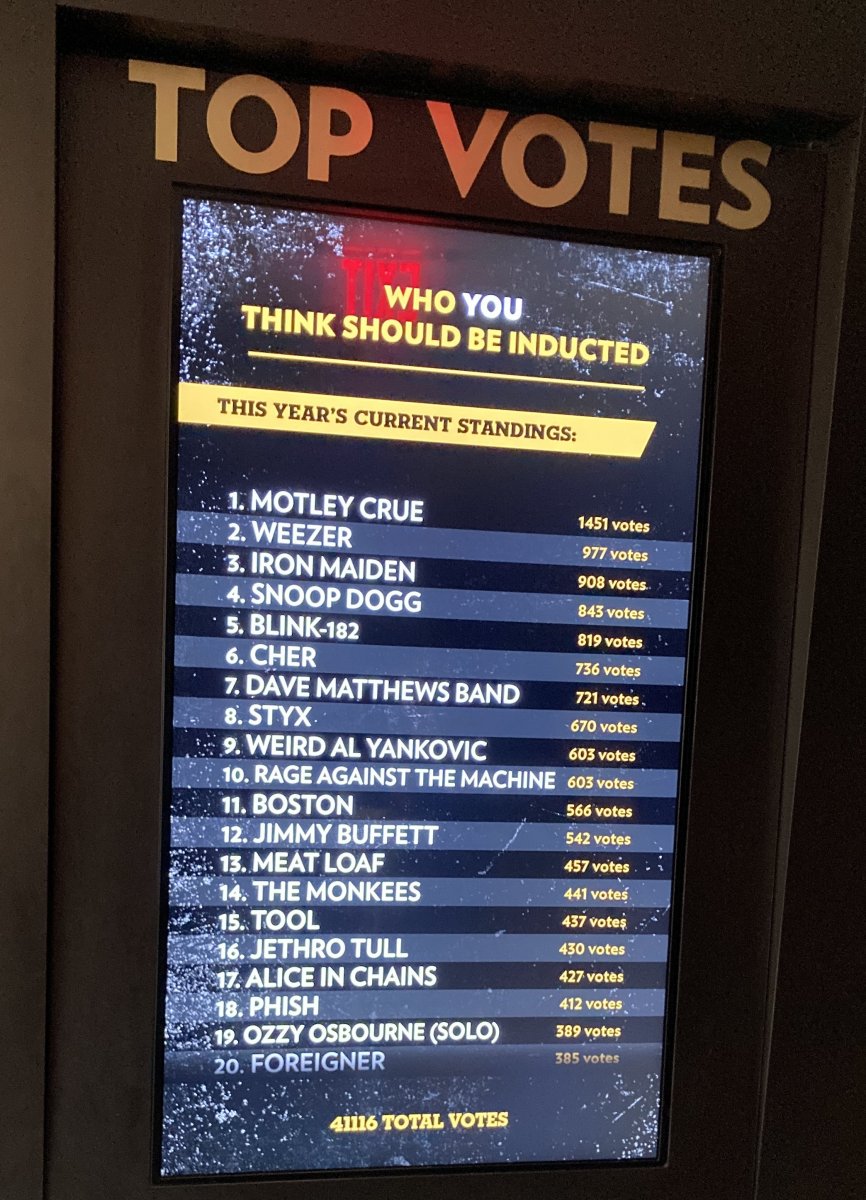 |
|
|
Level 4 was "The Wall" based on the Pink Floyd album of the same name.
|
| |
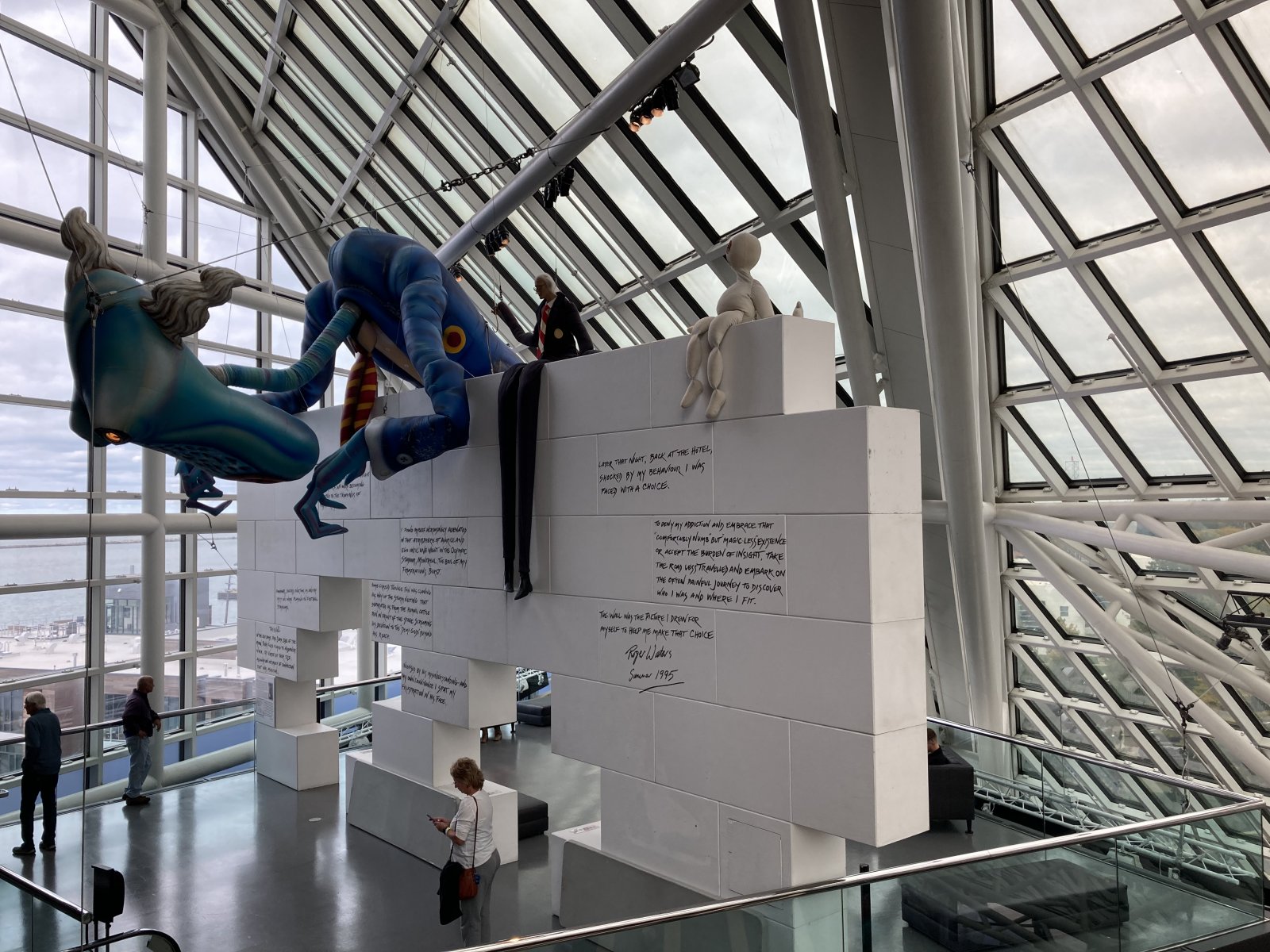 |
|
|
Jayne and Lynnette outside the Rock and Roll Hall of Fame with the Cleveland skyline behind them.
All in all, I enjoyed the Hall of Fame and can see why it is Cleveland's Number One attraction.
|
| |
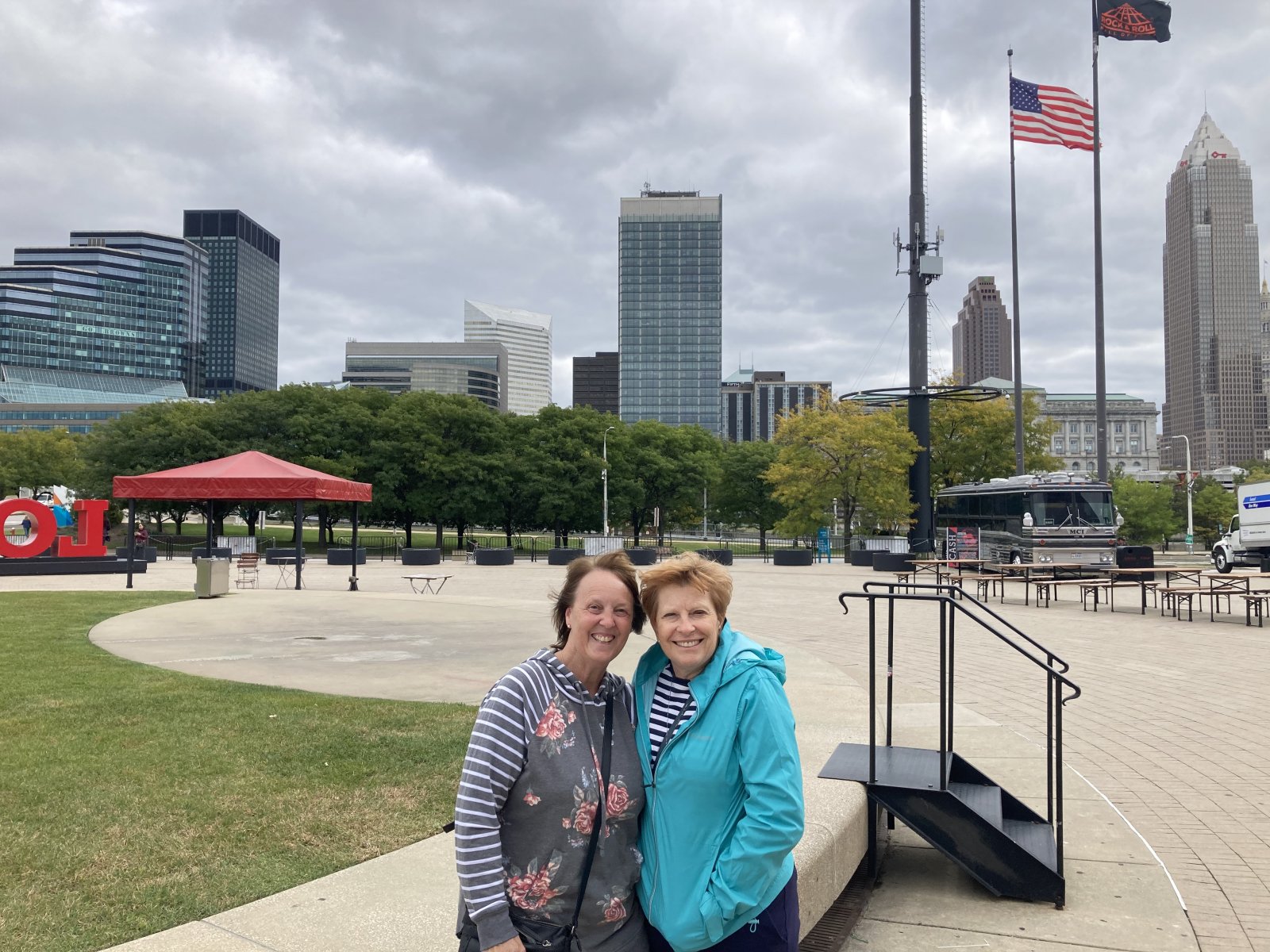 |
|
| We rented a two bedroom apartment AirBnB and it worked out great. Here's a shot of the outside of the building. |
| |
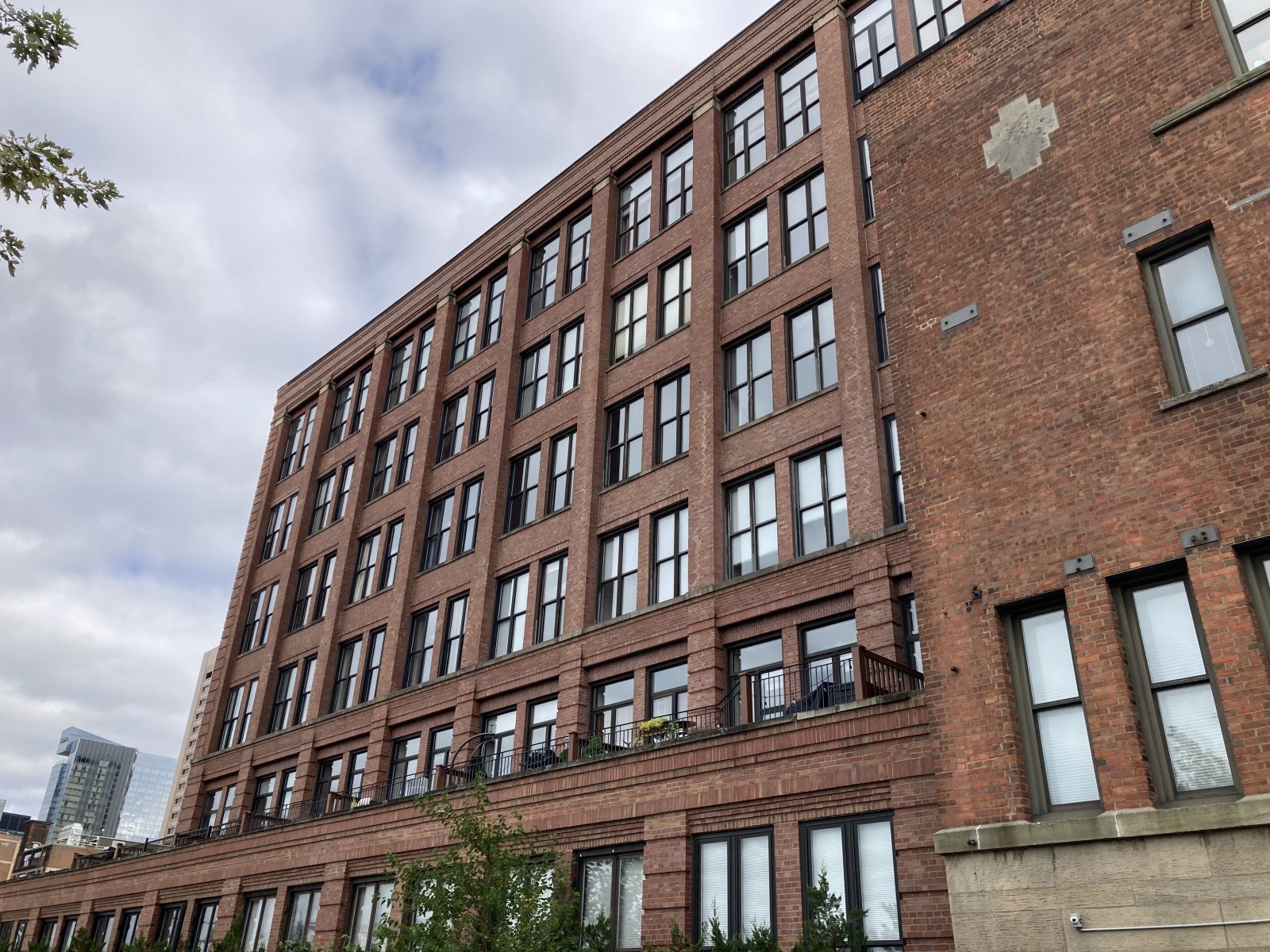 |
|
| This is the view from our AirBnB window. Yes, it's the football stadium where the Cleveland Browns play and Baker Mayfield lives. Oh wait, he is now with the Carolina Panthers. Oh wait, the Panthers just waived him and the LA Rams picked him up. I wonder if he will be doing commercials from SoFi Stadium? |
| |
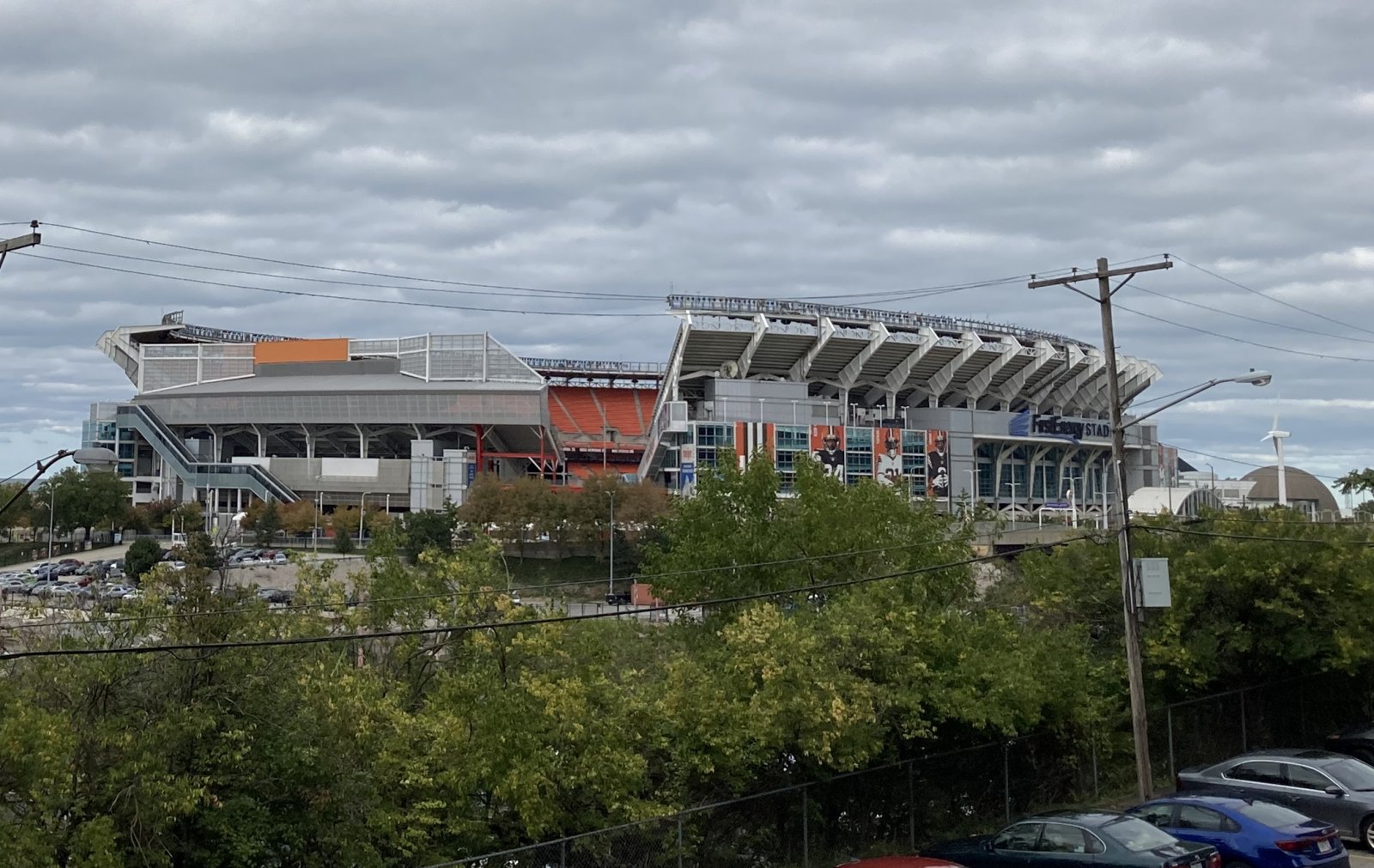 |
|
|
That night we to see a Cleveland Indians, I mean Guardians, baseball game. The stadium seemed modern and new to me, but it opened in 1994.
|
| |
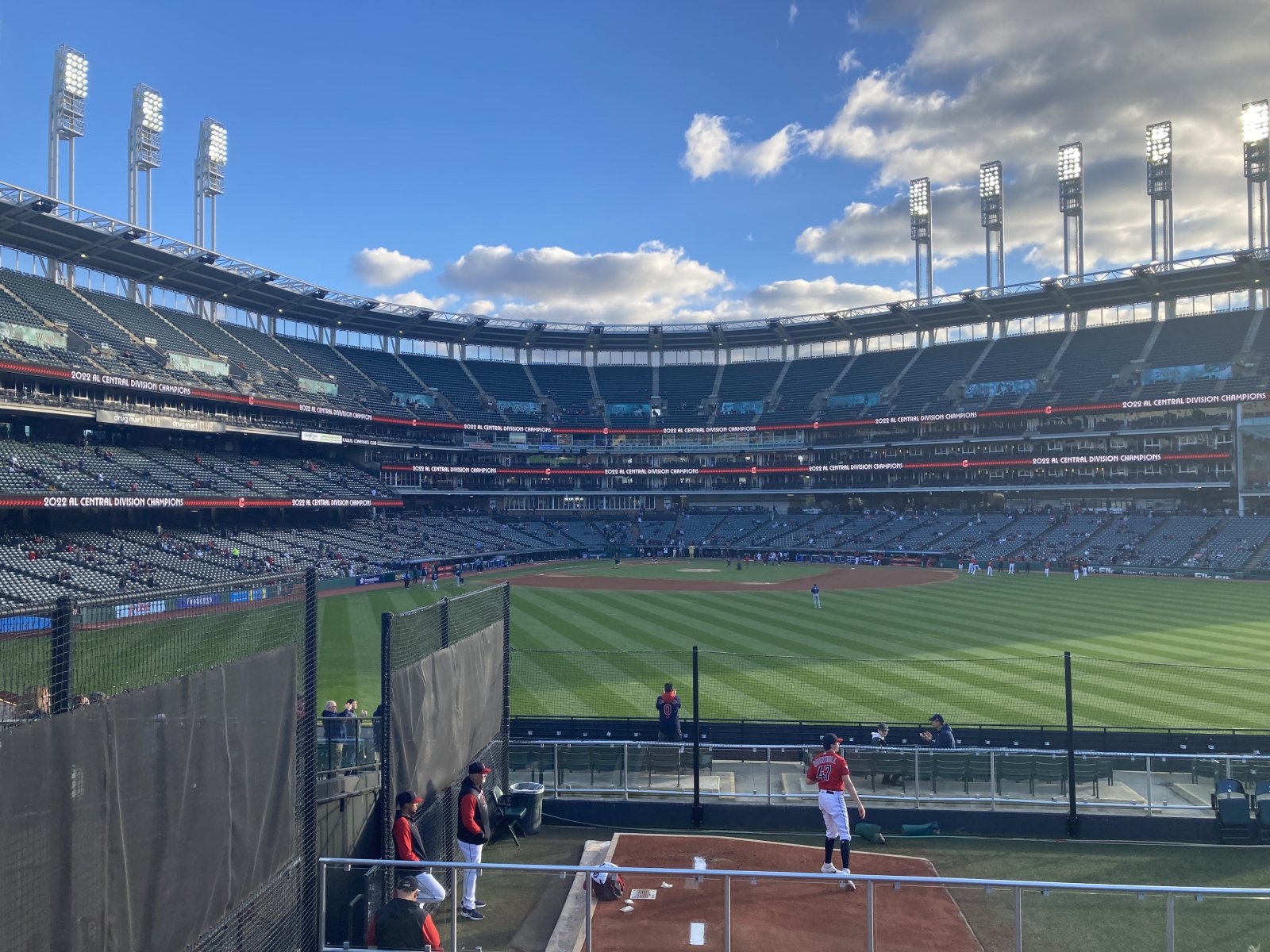 |
|
|
Cleveland has a good team this year and was leading their division. Tonight they were playing the Tampa Rays who are also in contention.
|
| |
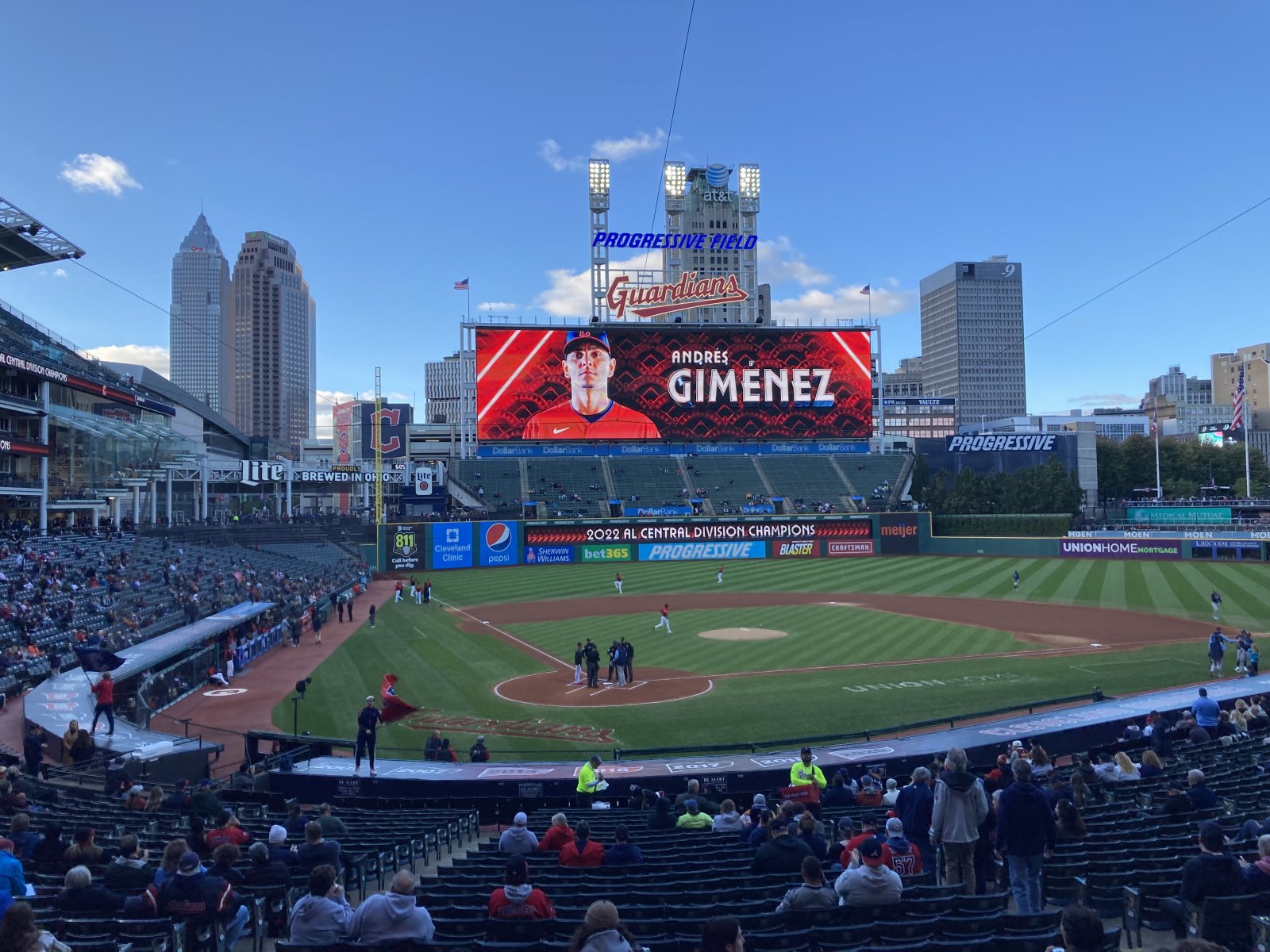 |
|
| As you can see, we ahd good seats. The game was actually fairly boring until the end. Tampa Bay jumped out to a quick 1-0 lead, and it stayed that way until the 8th inning. |
| |
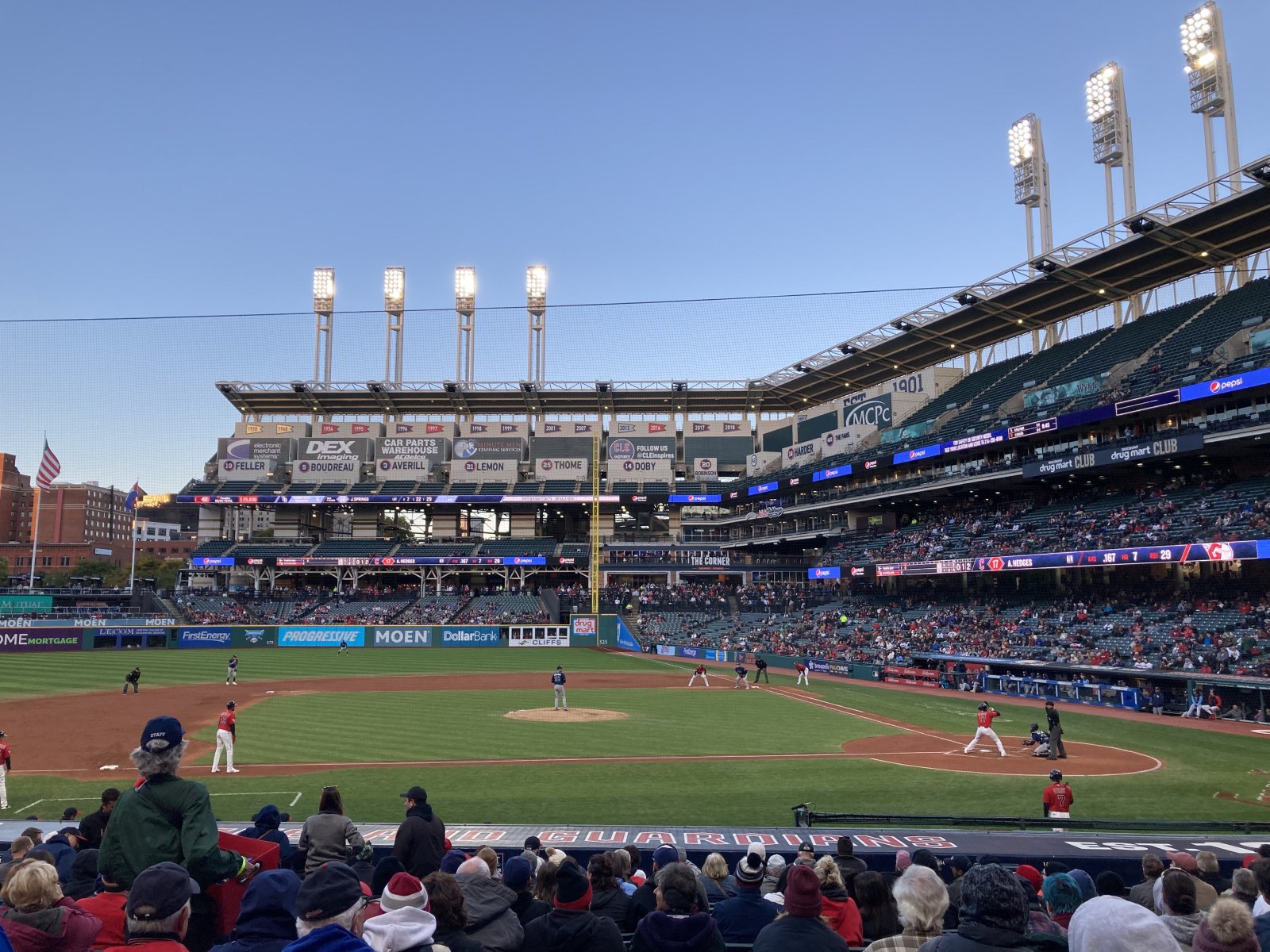 |
|
|
But in the bottom of the 8th, Cleveland scored two runs in an exciting rally, then shut out the Rays in the top of the nineth and won the game.
Cleveland would end up playing Tampa Bay in the playoffs and winning a best of three game series. However, Cleveland lost to the Yankees in the next round. The Yankees lost Houston who went on to win the World Series against Philadelphia.
|
| |
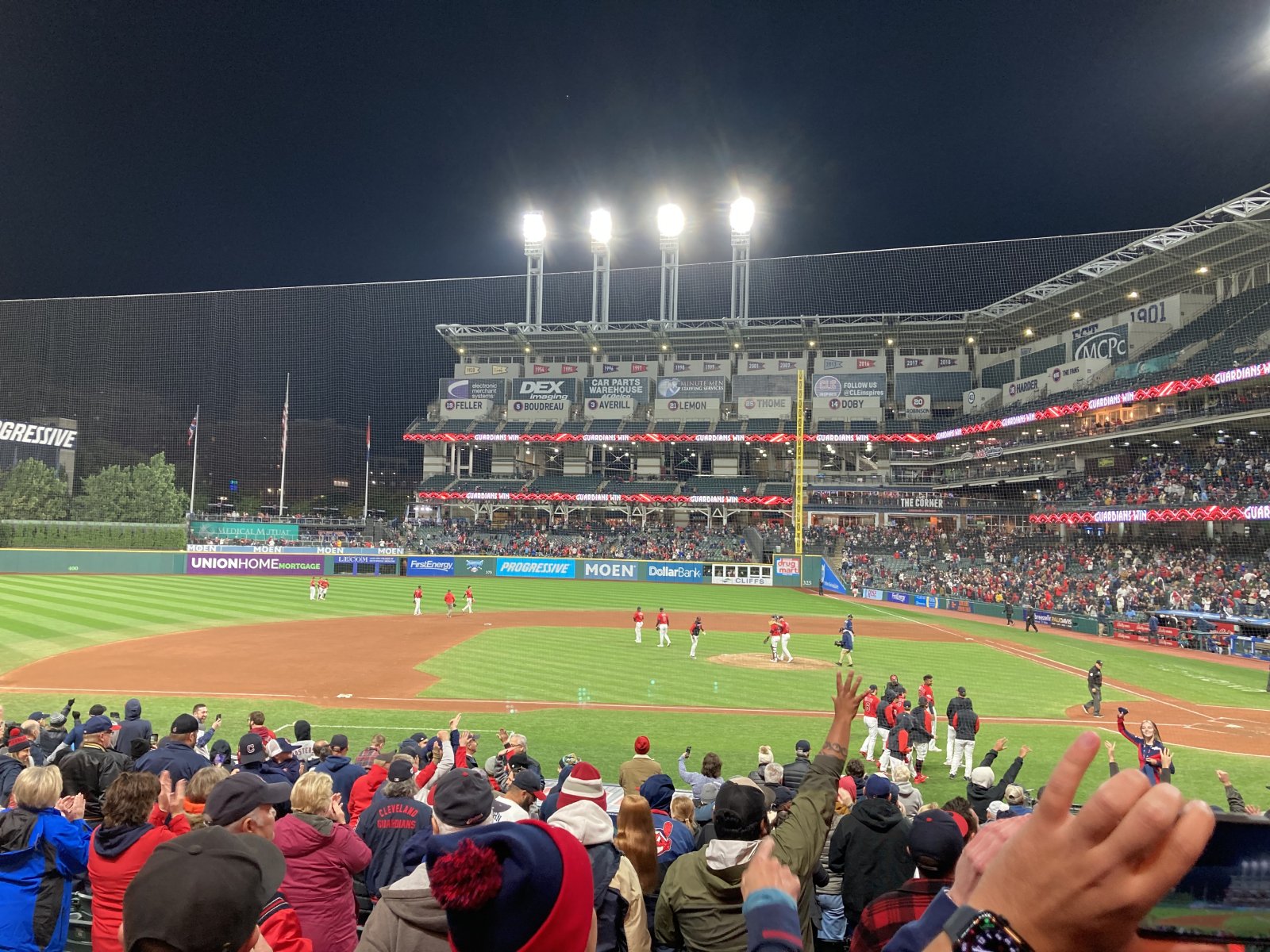 |
|
| The next morning our first stop was to visit the Christmas Story house. You know, the beloved movie with the leg lamps and BB gun? But it turns out this wasn't the house. |
| |
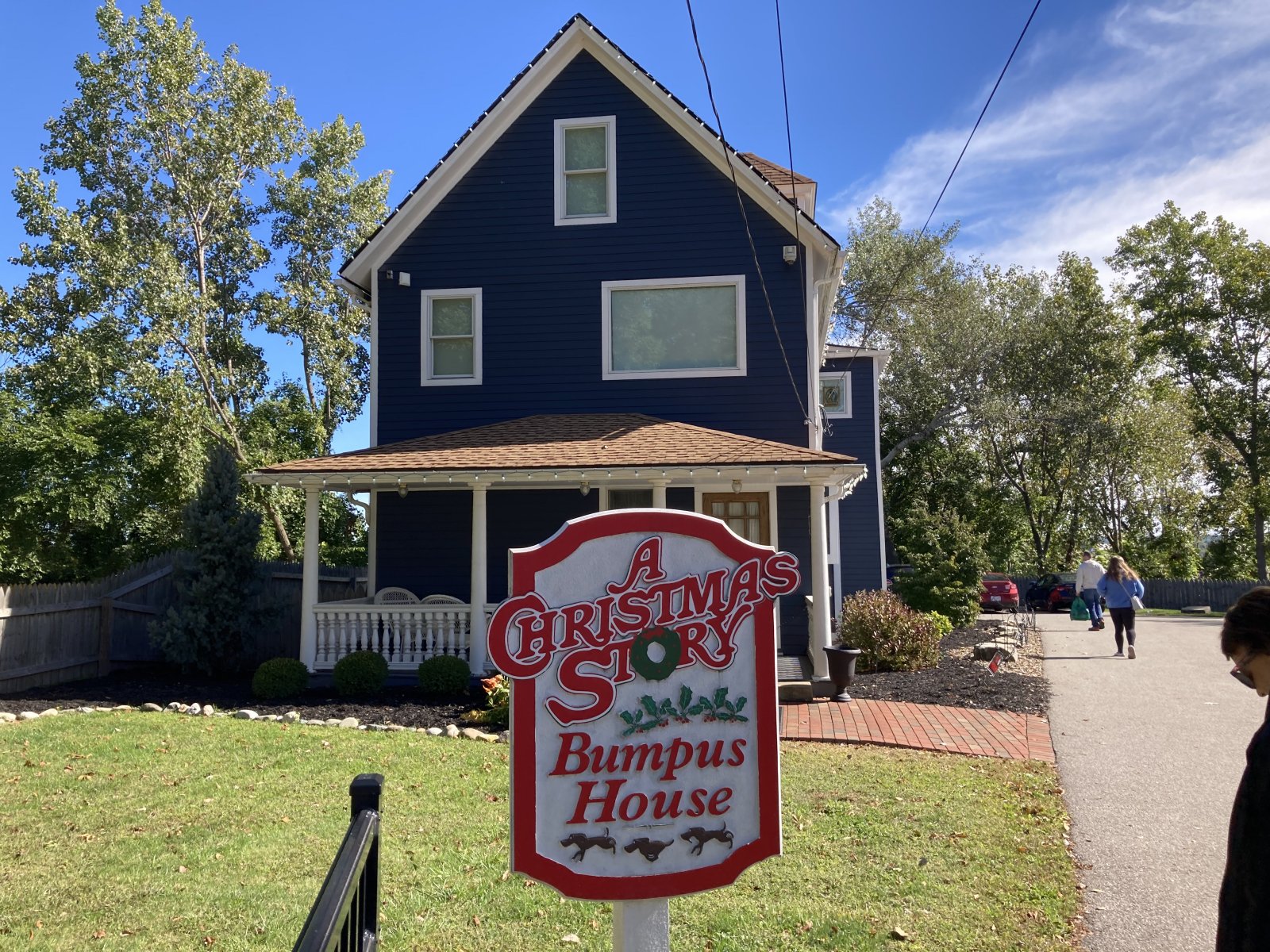 |
|
|
The actual house where the movie was filmed was next door. Here it is. You can see the leg lamp in the window.
|
| |
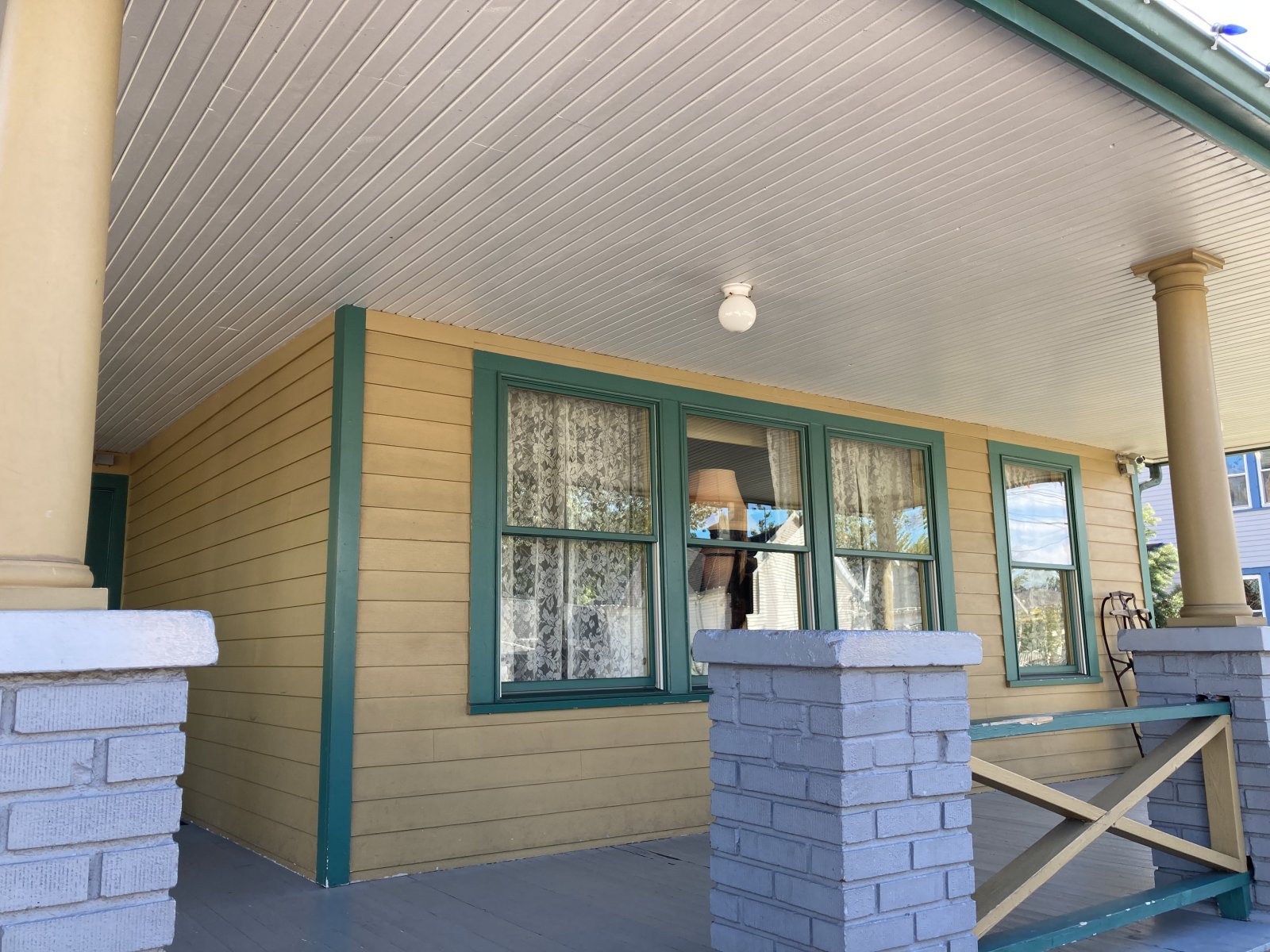 |
|
| Another shot of the actual house. |
| |
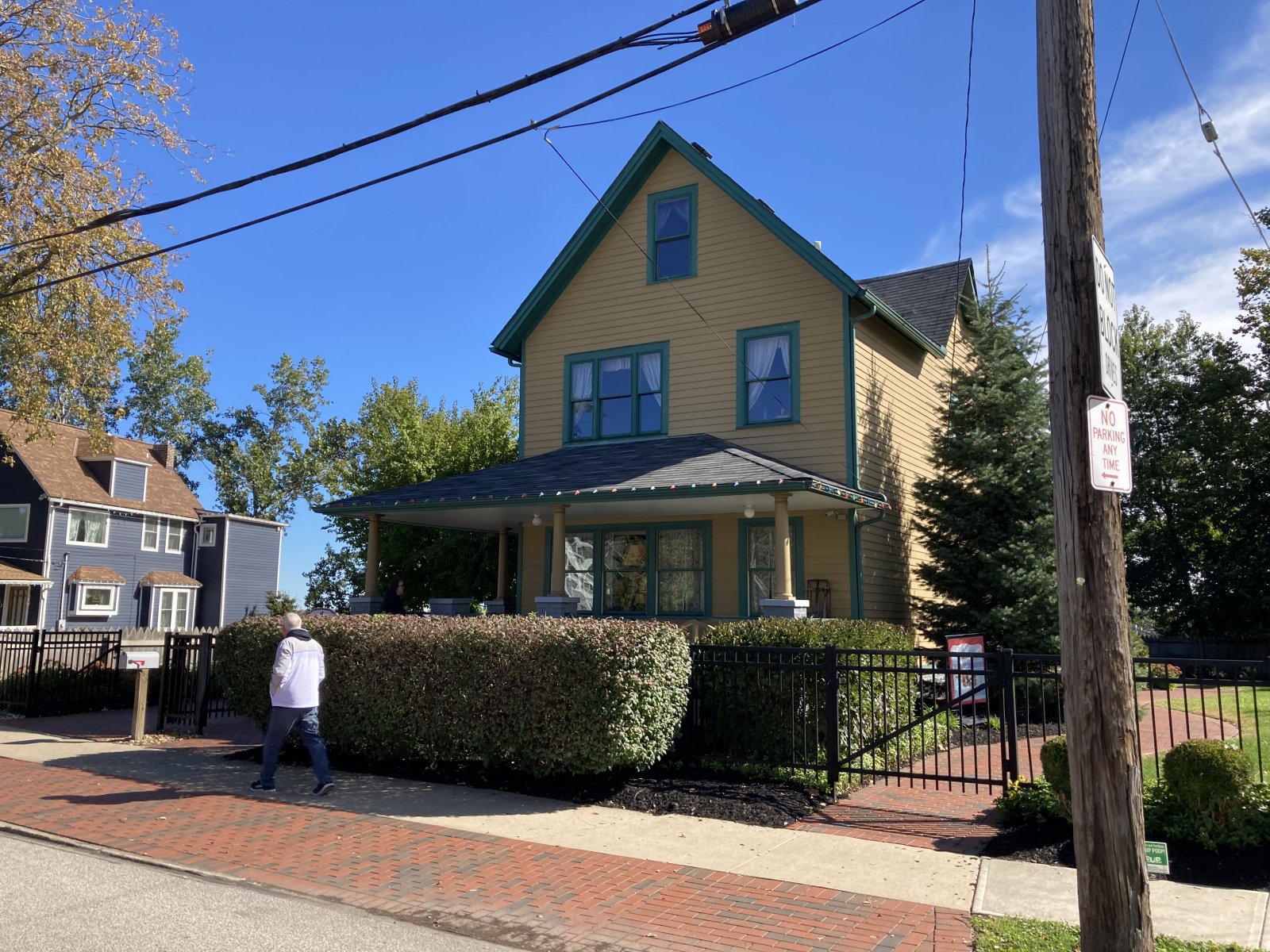 |
|
|
Bob and I split off from the girls and went to see the SS William G. Mather, a 533-foot long Great Lakes bulk freighter, built in 1925. She transported cargo such as ore, coal, stone, and grain to ports throughout the Great Lakes, and was nicknamed "The Ship That Built Cleveland" because Cleveland's steel mills were a frequent destination.
Unfortunately the museum ship is only open on Saturdays this time of year so we did not get to tour it.
|
| |
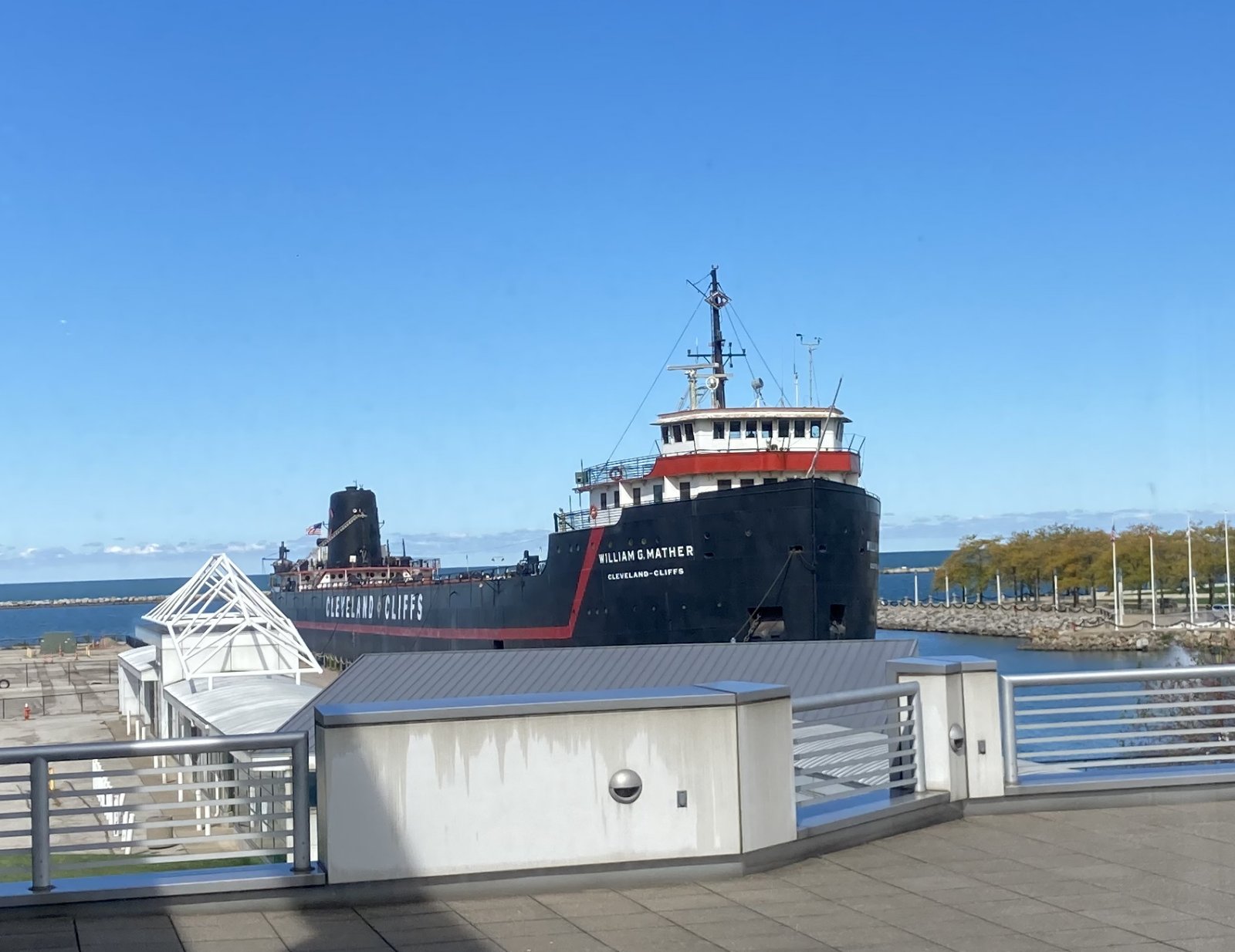 |
|
| So we toured the Great Lakes Science Center of which the museum ship is a part. The most intereting thing was this Apollo Command Module used in the 1973 Skylab 3 mission. |
| |
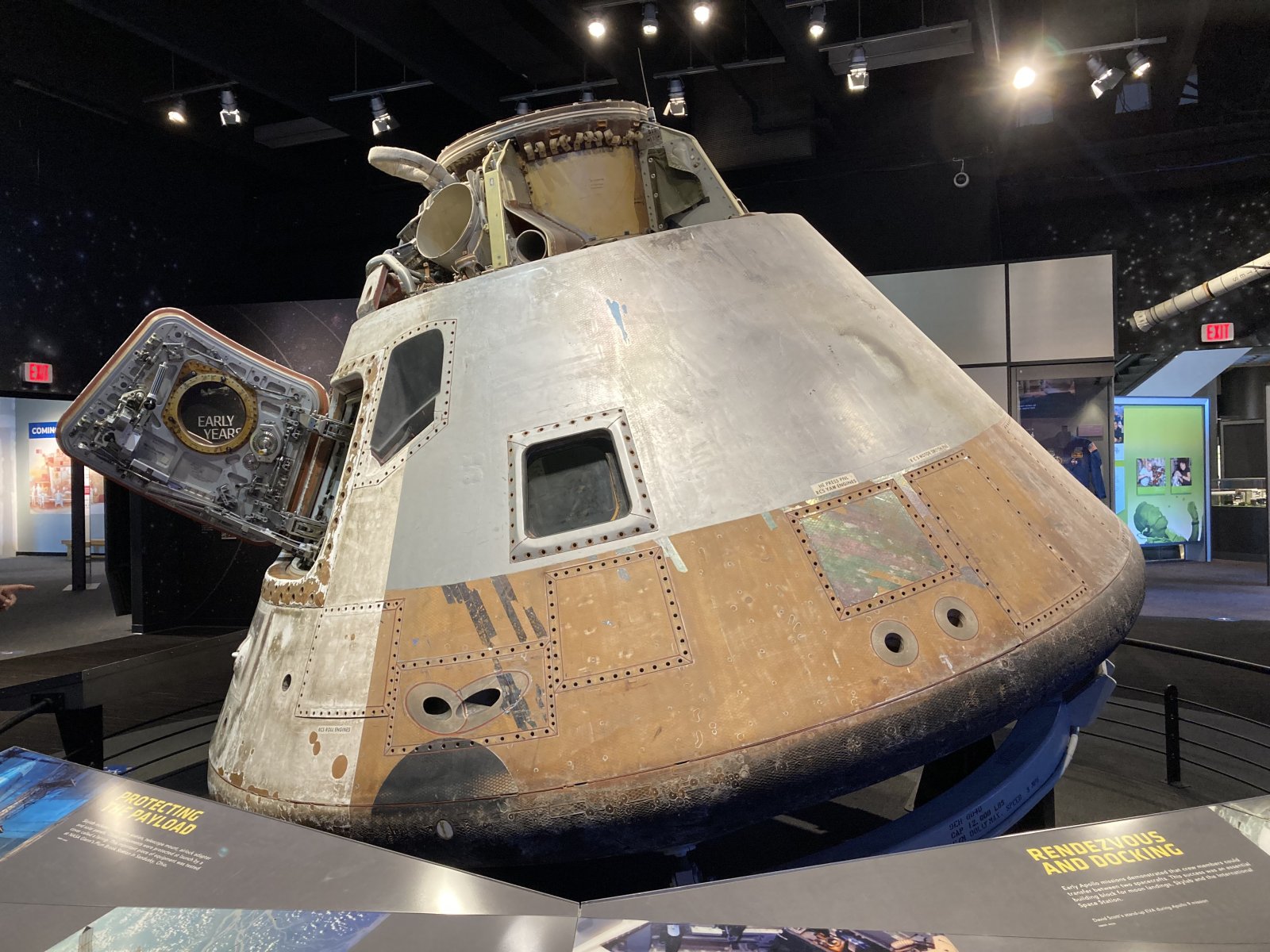 |
|
|
They had the ship's door open so you could really see inside the spacecraft. Check out that complicated door! The Science Center had a really good hands-on section that I'm sure was popular with the kids.
|
| |
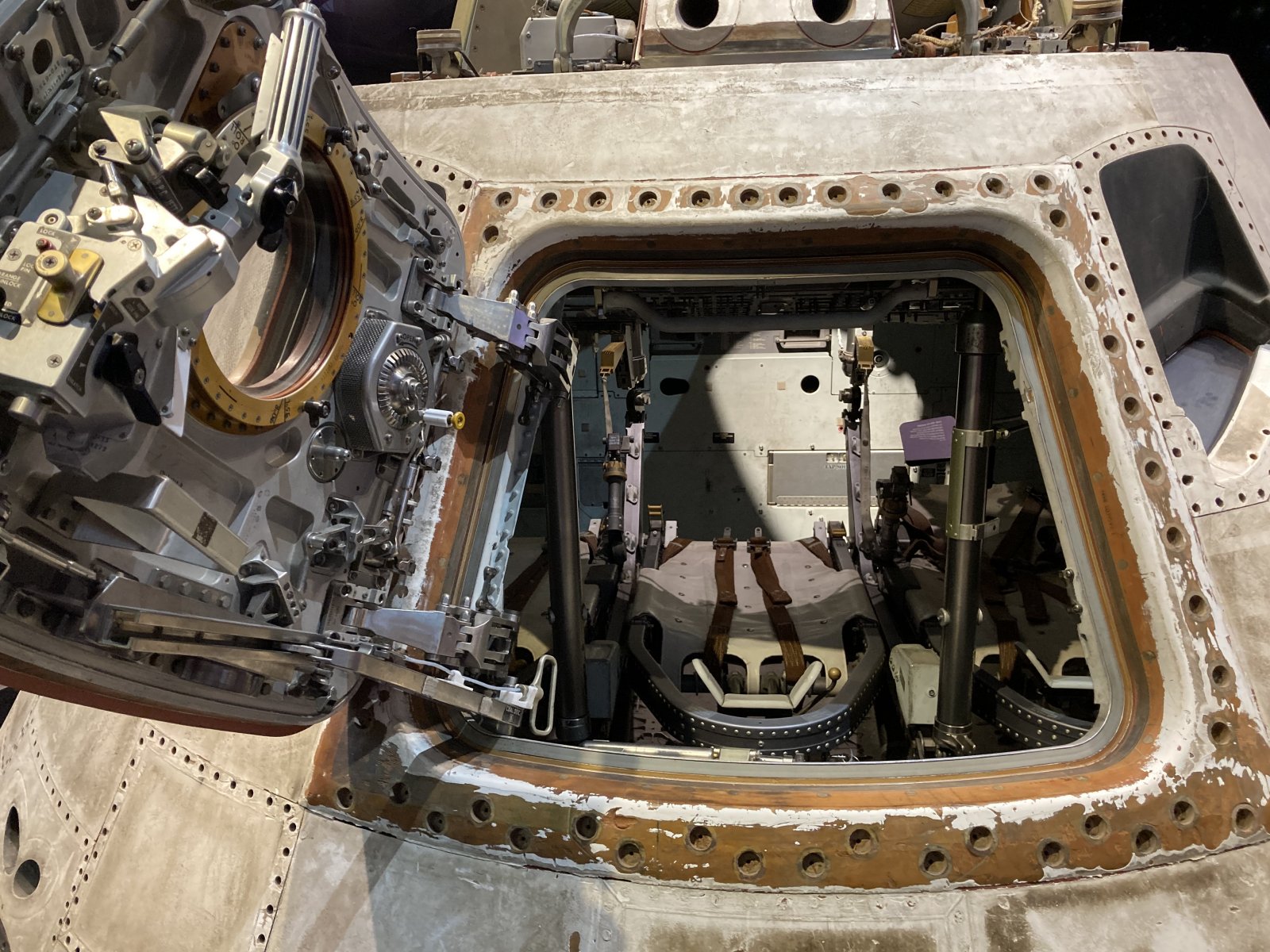 |
|
|
We joined up with the girls for a Cleveland walking tour. Scott, our guide, led us around, gave us Cleveland's history, pointed out countless buildings, monuments, squares, plazas, etc. that were a fascinating story we would never have known about had we not gone on this tour. Scott was a beyond outstanding guide; he was able to answer every question. If you are new to Cleveland, go on this tour before you do anything else!
We started the walking tour in the Cleveland Town Square, at the Tom L. Johnson statue. Tom Loftin Johnson was an American industrialist and important figure of the Progressive Era. He was a U.S. Representative from 1891 to 1895 and Mayor of Cleveland from 1901 to 1909. During that time he completely transformed the city into the industrial kingpin it was during the early 20th century. Lauded as a consummate "municipal technician" , Johnson paved hundreds of miles of new streets, installed new parks, built numerous public facilities, sporting centers, playgrounds, etc. He also began work on the West Side Market that still operates today as a landmark food market in the US. Johnson was instrumental in incorporating electricity, public transit, steel, and a number of other infrastructure items into the city's economy. Without Tom Johnson, it is safe to say that the Cleveland of today would be a much smaller, very different city.
Behind the statue is the Old Stone Presbyterian Church, founded in 1820.
Cleveland was founded in 1796 near the mouth of the Cuyahoga River by General Moses Cleaveland, after whom the city was named. Its location on both the river and the lake shore allowed it to grow into a major commercial and industrial center, attracting large numbers of immigrants and migrants. A port city, Cleveland is connected to the Atlantic Ocean via the Saint Lawrence Seaway.
|
| |
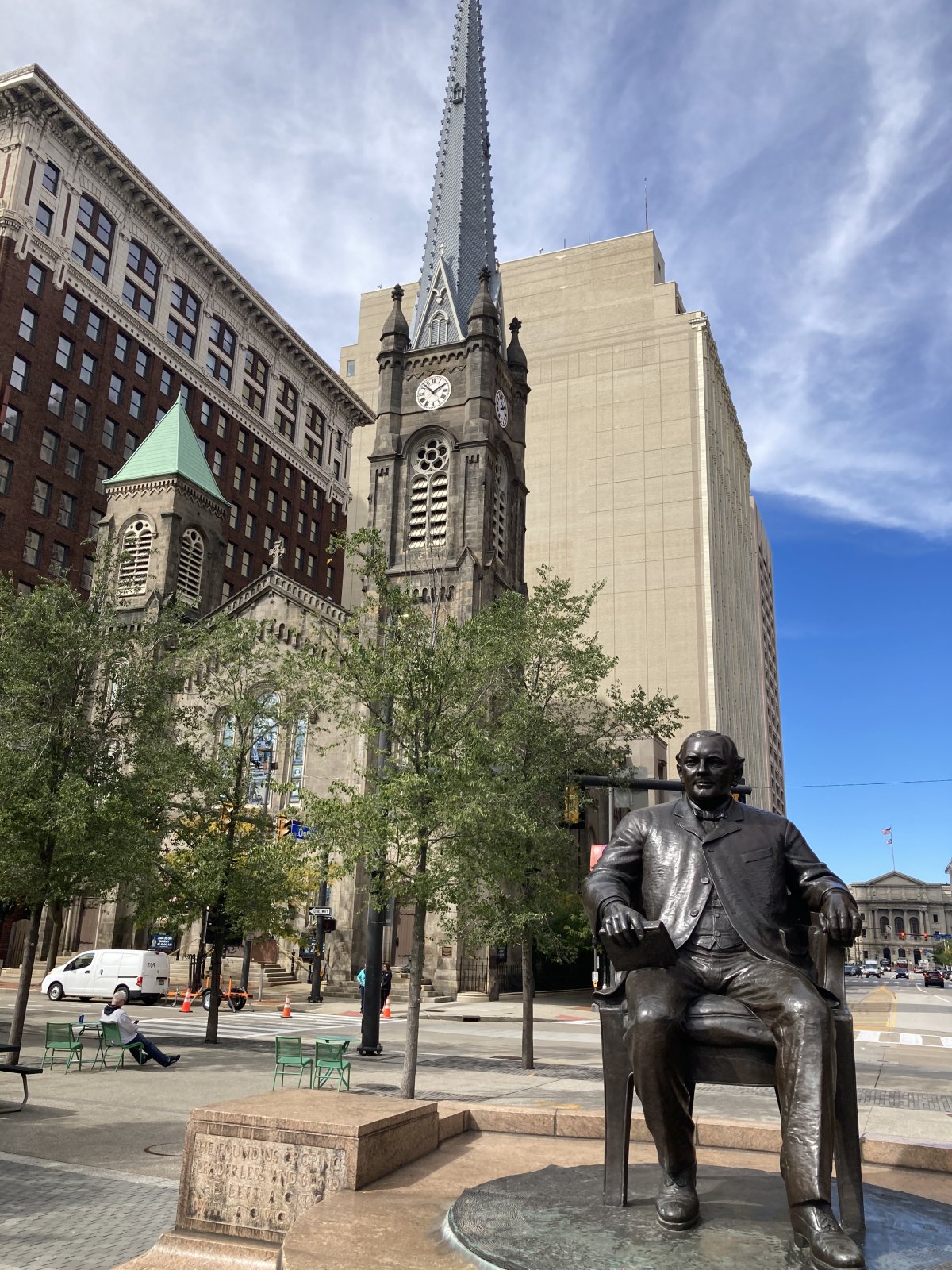 |
|
|
After the Civil war, Cleveland witnessed rapid growth. Its prime geographic location as a transportation hub between the East Coast and the Midwest played an important role in its development as a commercial center. The city served as a destination for iron ore shipped from Minnesota, along with coal transported by rail. In 1870, John D. Rockefeller founded Standard Oil in Cleveland.
By 1910, Cleveland had become known as the "Sixth City" due to its position as the sixth largest U.S. city at the time. Its businesses included automotive companies such as Peerless, People's, Jordan, Chandler, and Winton, maker of the first car driven across the U.S. Other manufacturers in Cleveland produced steam-powered cars, which included those by White and Gaeth, and electric cars produced by Baker. The era of the City Beautiful movement in Cleveland architecture, this period also saw wealthy patrons support the establishment of the city's major cultural institutions. The most prominent among them were the Cleveland Museum of Art, which opened in 1916, and the Cleveland Orchestra, established in 1918.
By 1920, the year in which the Cleveland Indians won their first World Series championship, Cleveland had grown into a densely-populated metropolis of 796,841, making it the fifth largest city in the nation. The Roaring Twenties also saw the establishment of Cleveland's Playhouse Square. In 1929, the city hosted the first of many National Air Races. This was the golden age in Downtown Cleveland retail, centered on major department stores Higbee's, Bailey's, the May Company, Taylor's, Halle's, and Sterling Lindner Davis, which collectively represented one of the largest and most fashionable shopping districts in the country, often compared to New York's Fifth Avenue.
After World War II, Cleveland initially experienced an economic boom, and businesses declared the city to be the "best location in the nation". In 1949, the city was named an All-America City for the first time and, in 1950, its population reached 914,808. In sports, the Indians won the 1948 World Series, the hockey team, the Barons, became champions of the American Hockey League, and the Browns dominated professional football in the 1950s. As a result, along with track and boxing champions produced, Cleveland was declared the "City of Champions" in sports at this time. The 1950s also saw the rising popularity of a new music genre that local WJW (AM) disc jockey Alan Freed dubbed "rock and roll".
However, by the 1960s, Cleveland's economy began to slow down, and residents increasingly sought new housing in the suburbs, reflecting the national trends of suburban growth following federally subsidized highways. Industrial restructuring, particularly in the railroad and steel industries, resulted in the loss of numerous jobs in Cleveland and the region, and the city suffered economically. The burning of the Cuyahoga River in June 1969 brought national attention to the issue of industrial pollution in Cleveland and served as a catalyst for the American environmental movement.
In December 1978, during the turbulent tenure of Dennis Kucinich as mayor, Cleveland became the first major American city since the Great Depression to enter into a financial default on federal loans.
The city began a gradual economic recovery under Mayor George V. Voinovich in the 1980s. The downtown area saw the construction of the Key Tower and 200 Public Square skyscrapers, as well as the development of the Gateway Sports and Entertainment Complex—consisting of Progressive Field and Rocket Mortgage FieldHouse—and the North Coast Harbor, including the Rock and Roll Hall of Fame, FirstEnergy Stadium, and the Great Lakes Science Center. The city emerged from default in 1987.
By the turn of the 21st century, Cleveland succeeded in developing a more diversified economy and gained a national reputation as a center for healthcare and the arts. Additionally, it has become a national leader in environmental protection, with its successful cleanup of the Cuyahoga River. The city's downtown and several neighborhoods have experienced significant population growth since 2010, despite the fact that the overall population -- now 372,624 -- has continued to decline.
Here is another building on the Town Square that has been around for awhile. Our guide knew all the buildings and architecture history; he was very interesting. Unfortunately, I can't remember the story on this building. I need to bring a tape recorder on the tour, so I can remember.
|
| |
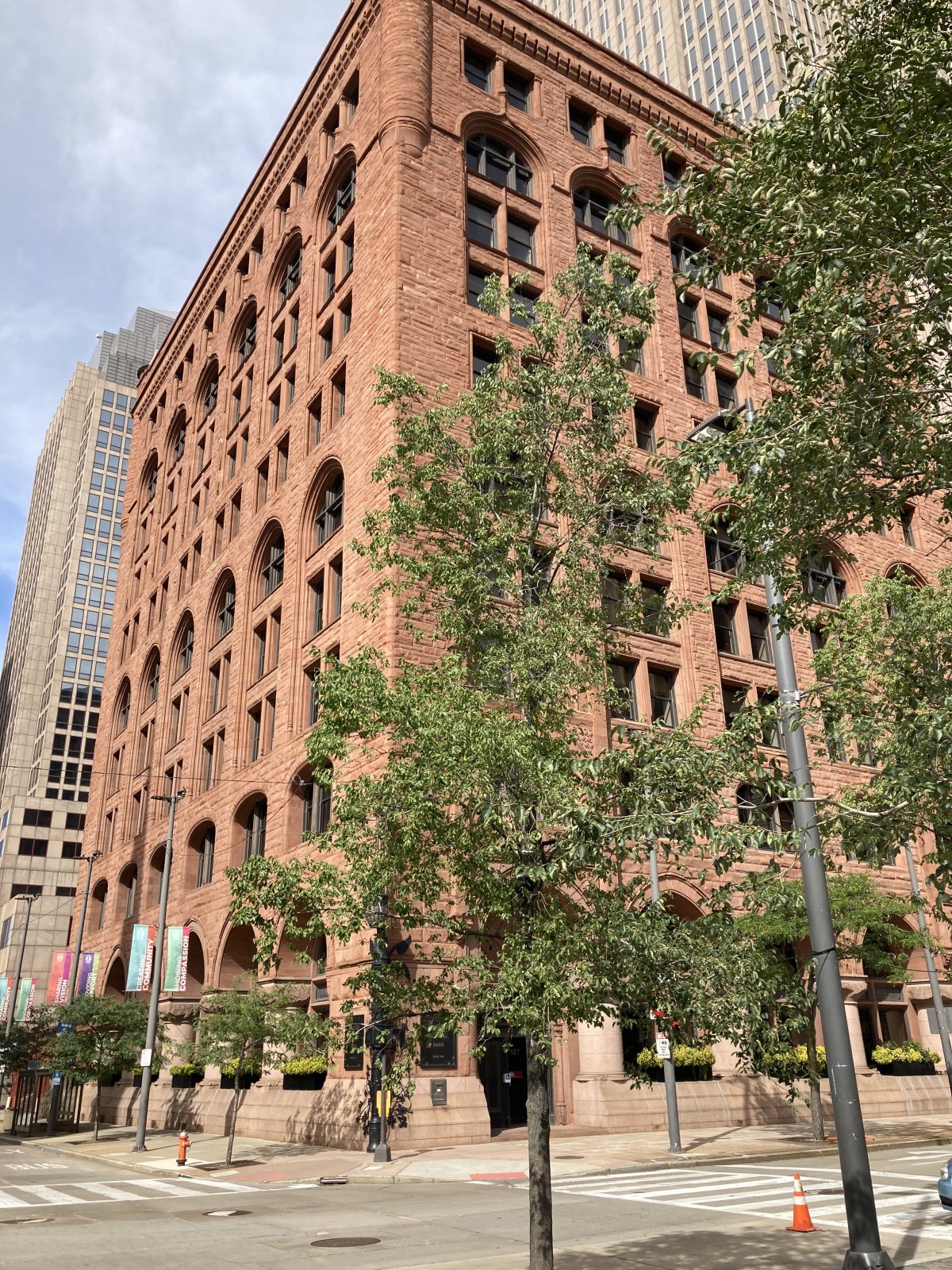 |
|
|
On the other side of the square is Cleveland's iconic "Terminal Tower". The Van Sweringen brothers commenced construction of the Terminal Tower skyscraper in 1926; it was dedicated in 1930. It was the second-tallest building in the world when it was completed. Terminal Tower stood as the tallest building in North America outside of New York City from its completion in 1927 until 1964. Initially, it was to serve as an office building atop the city's new rail station, the Cleveland Union Terminal.
Today, the tower's external lights include 508 LEDs that can be configured into various color schemes, such as red and green during the Christmas season and red, white, and blue for various federal holidays, the Cleveland sports teams colors, or various social groups.
Now, many of the tower's floors have been converted into apartments. Our guide said many of the other historic downtown buildings -- in fact, most of the buildings -- are now used for residential purposes.
|
| |
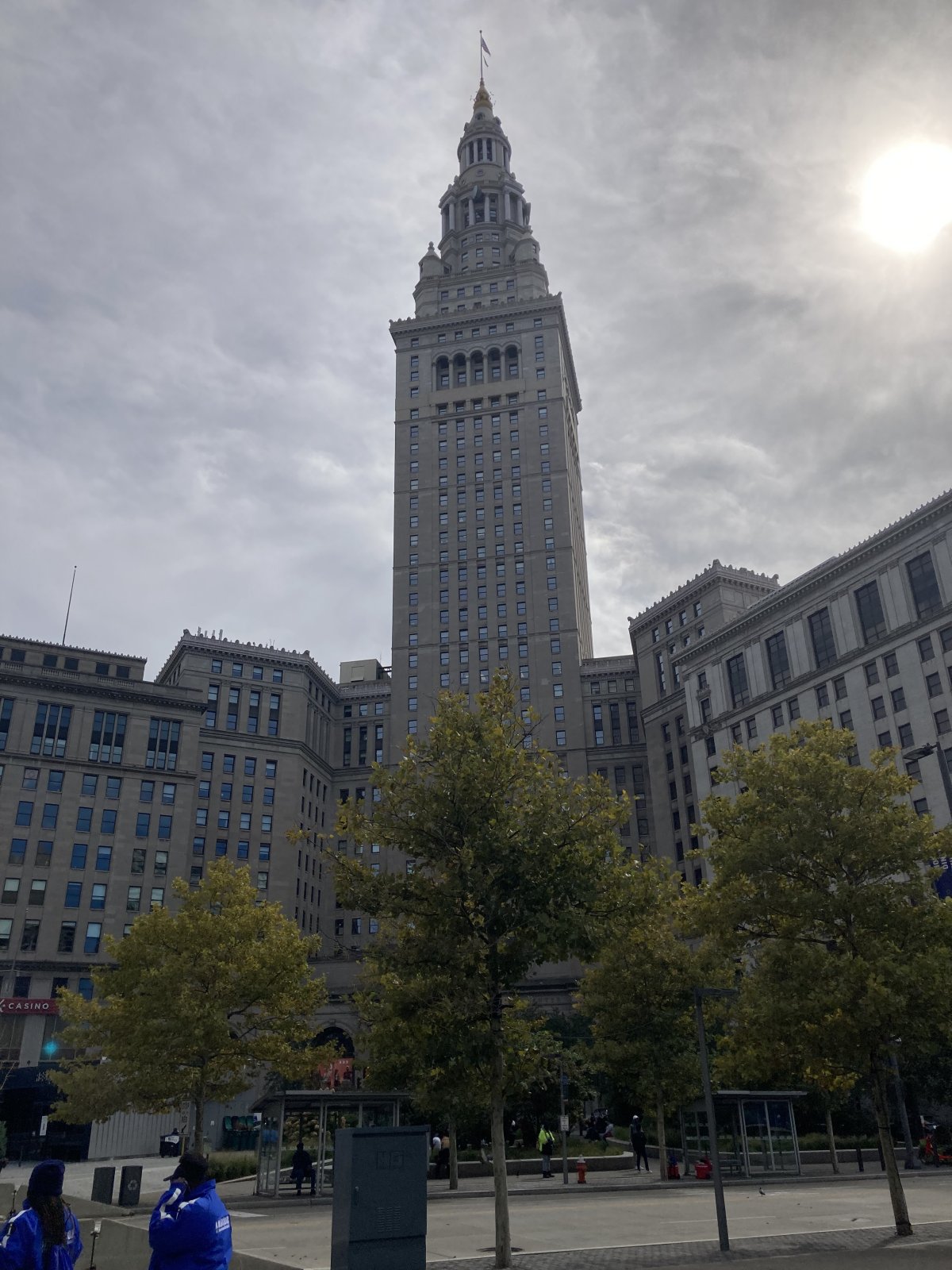 |
|
| The Fountain of Eternal Life that honors Cleveland's casualties of war, on "The Mall". |
| |
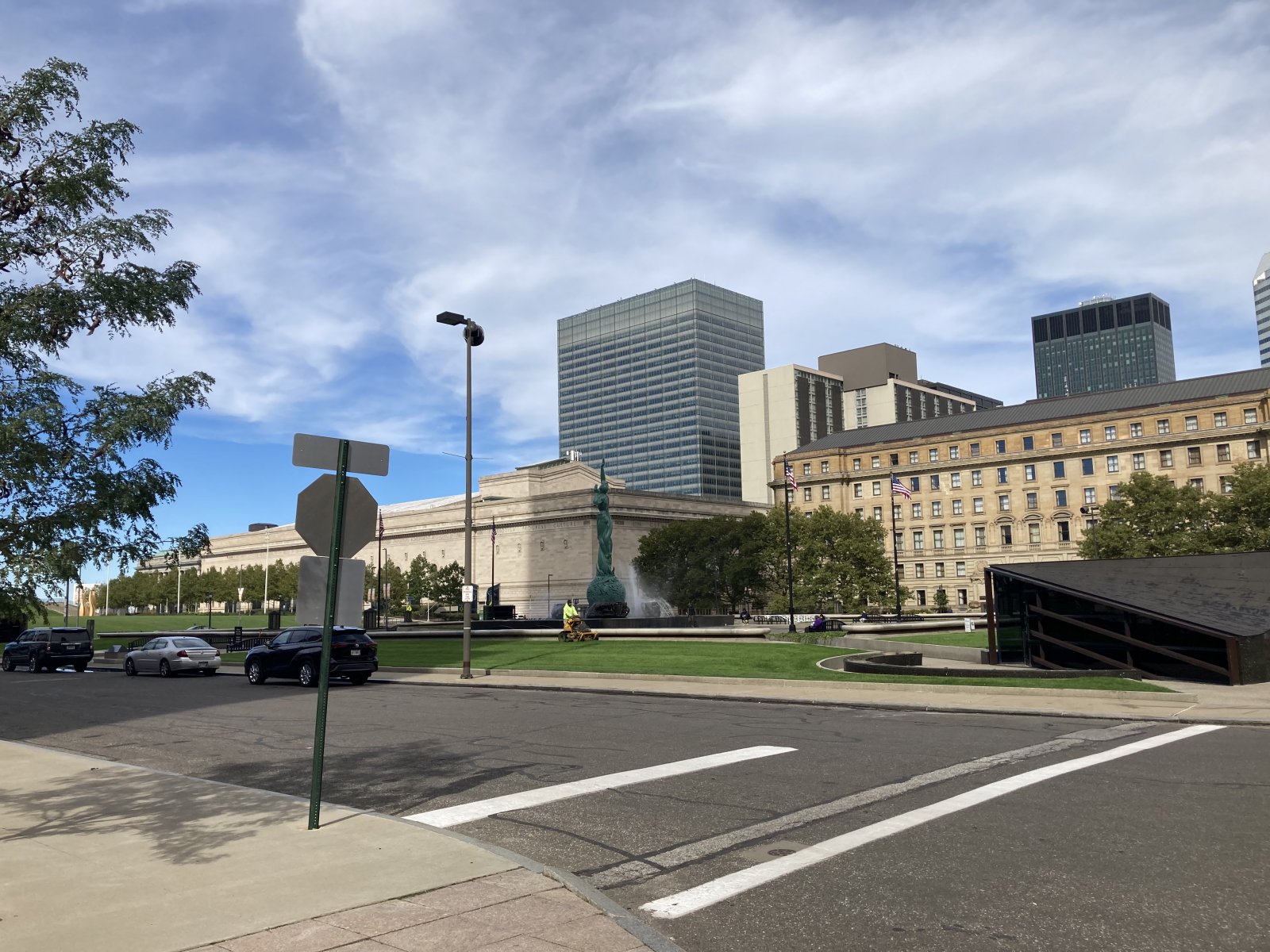 |
|
|
Looking down Rockwell Avenue with the U.S. Courthouse at far right, then the Cleveland Public Library.
|
| |
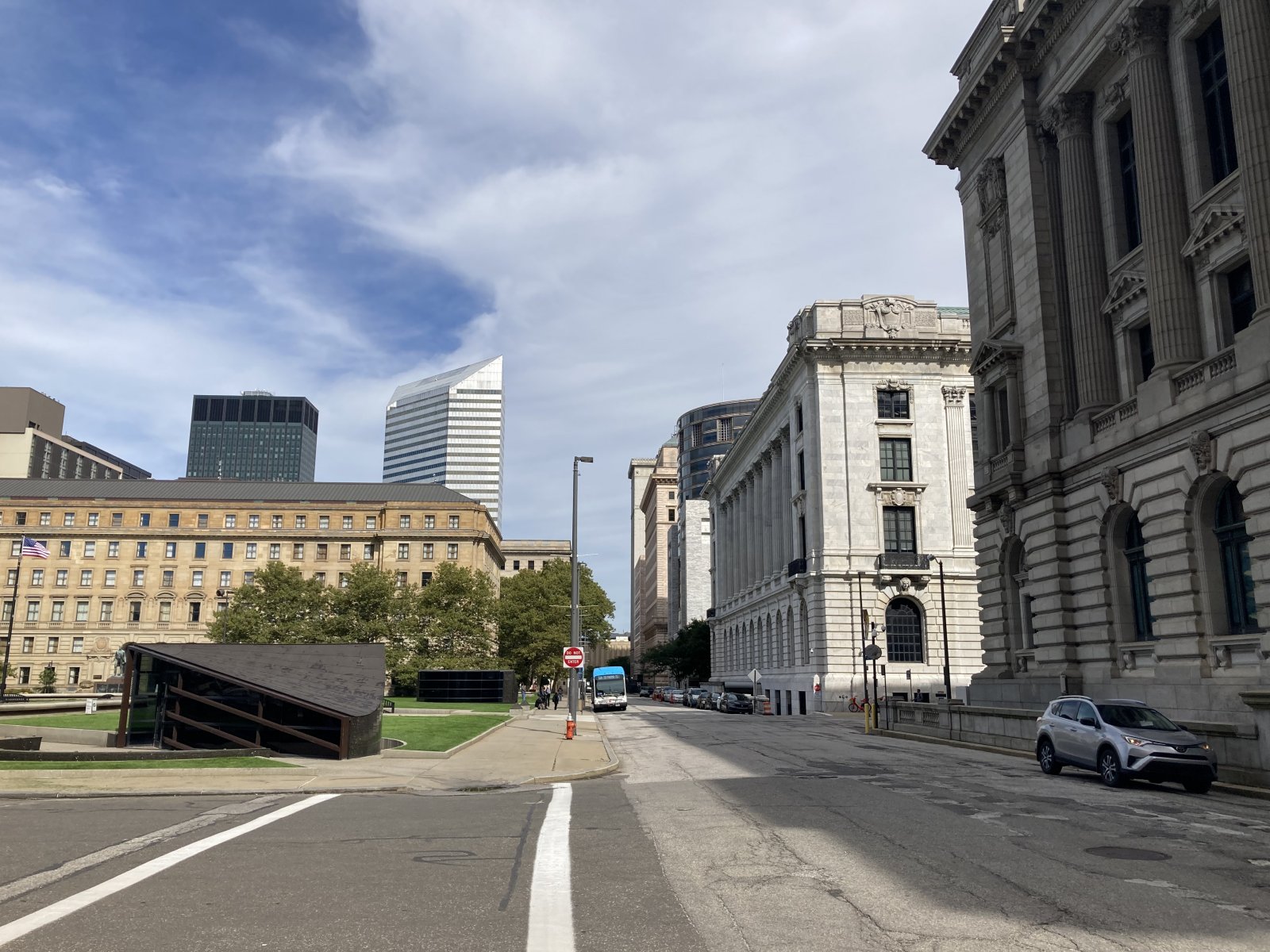 |
|
| Looking down the Mall towards Lake Erie. At center is the futuristic looking Cleveland Hilton. |
| |
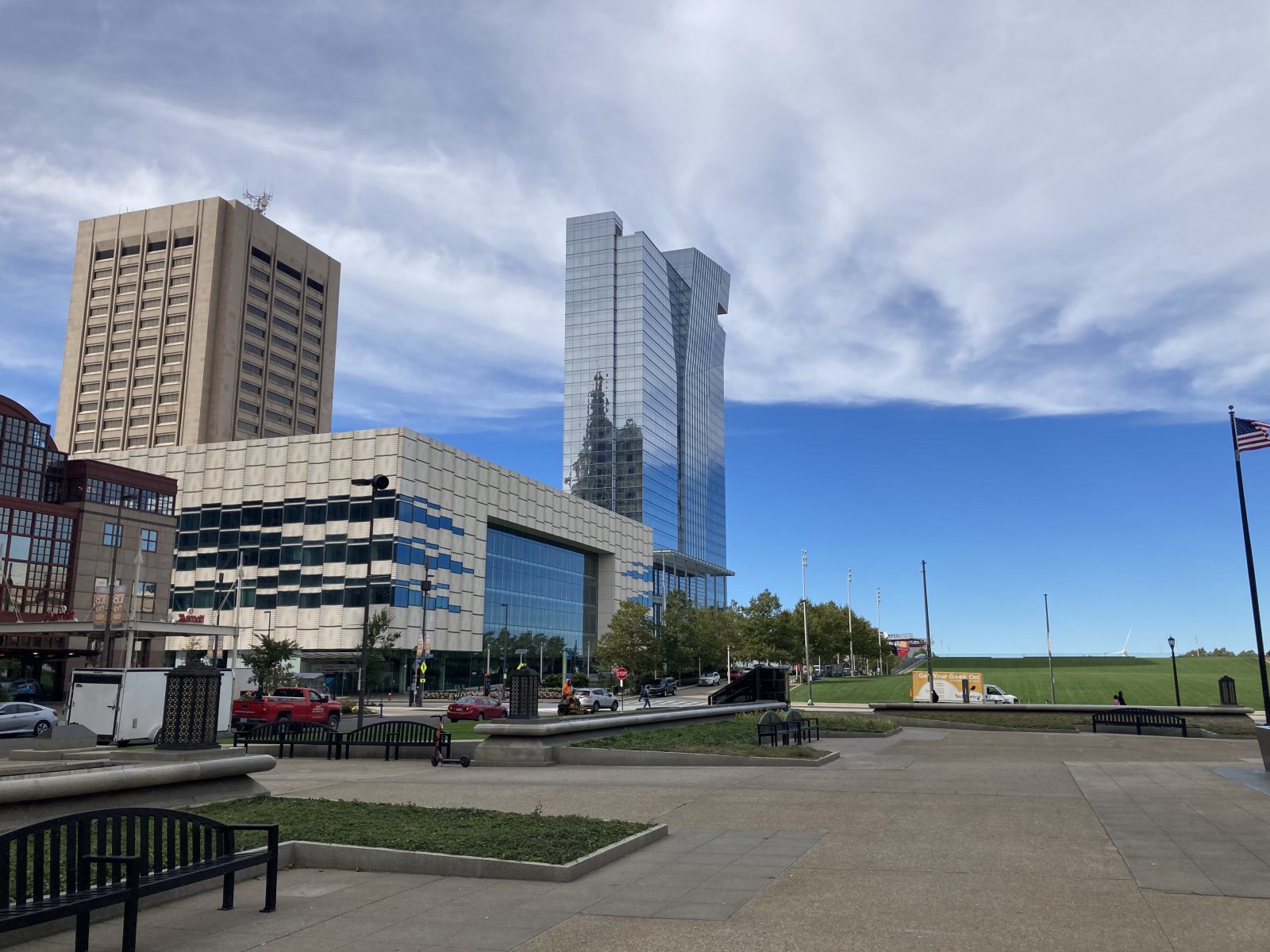 |
|
|
Now looking directly at the Cleveland Public Library. I wouldn't have like to go inside and check it out. Some other time. That circular-looking building to the left is also part of the Cleveland Public Library.
|
| |
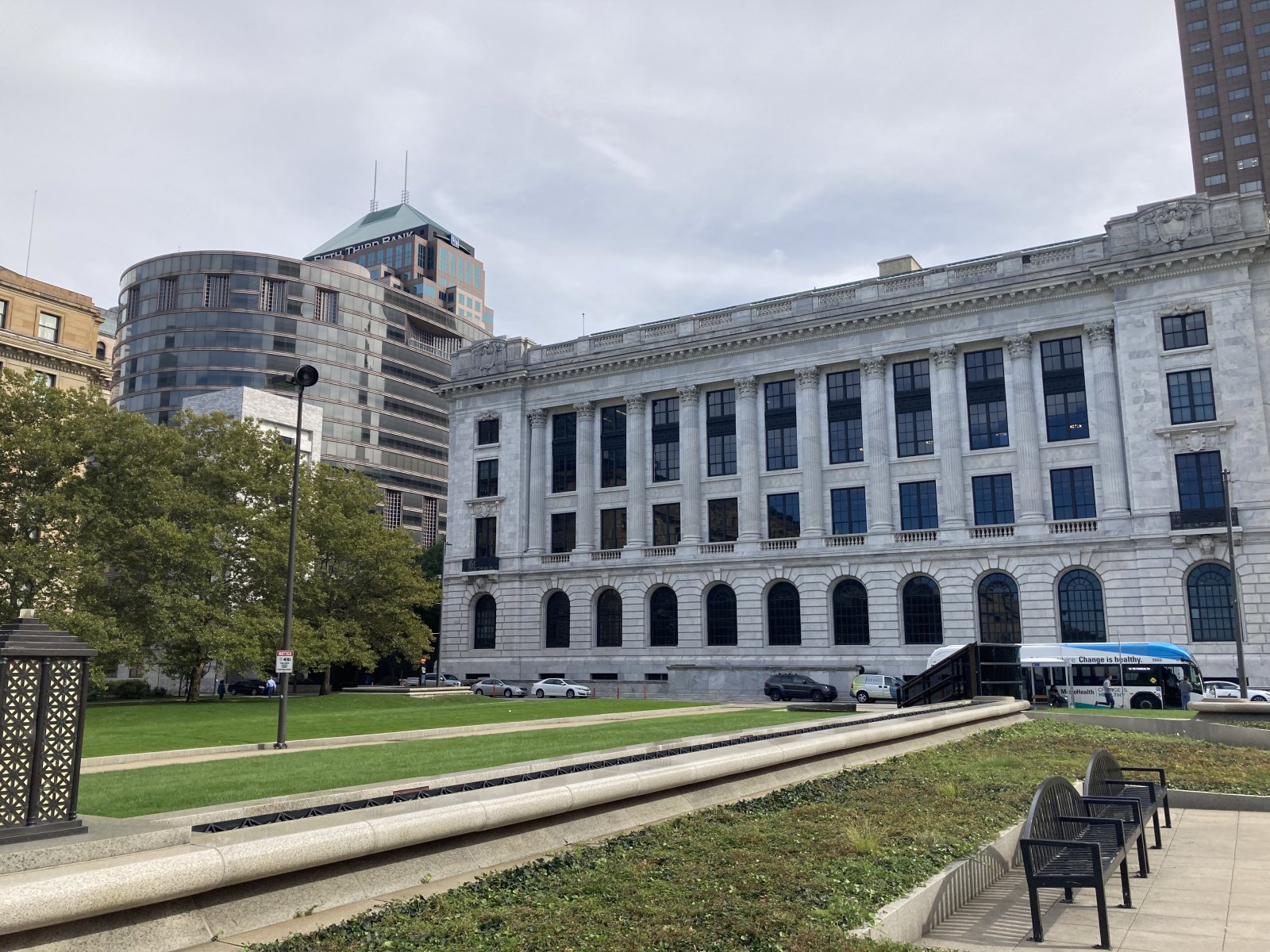 |
|
| Another look at the HIlton with Cleveland's football stadium to its right. |
| |
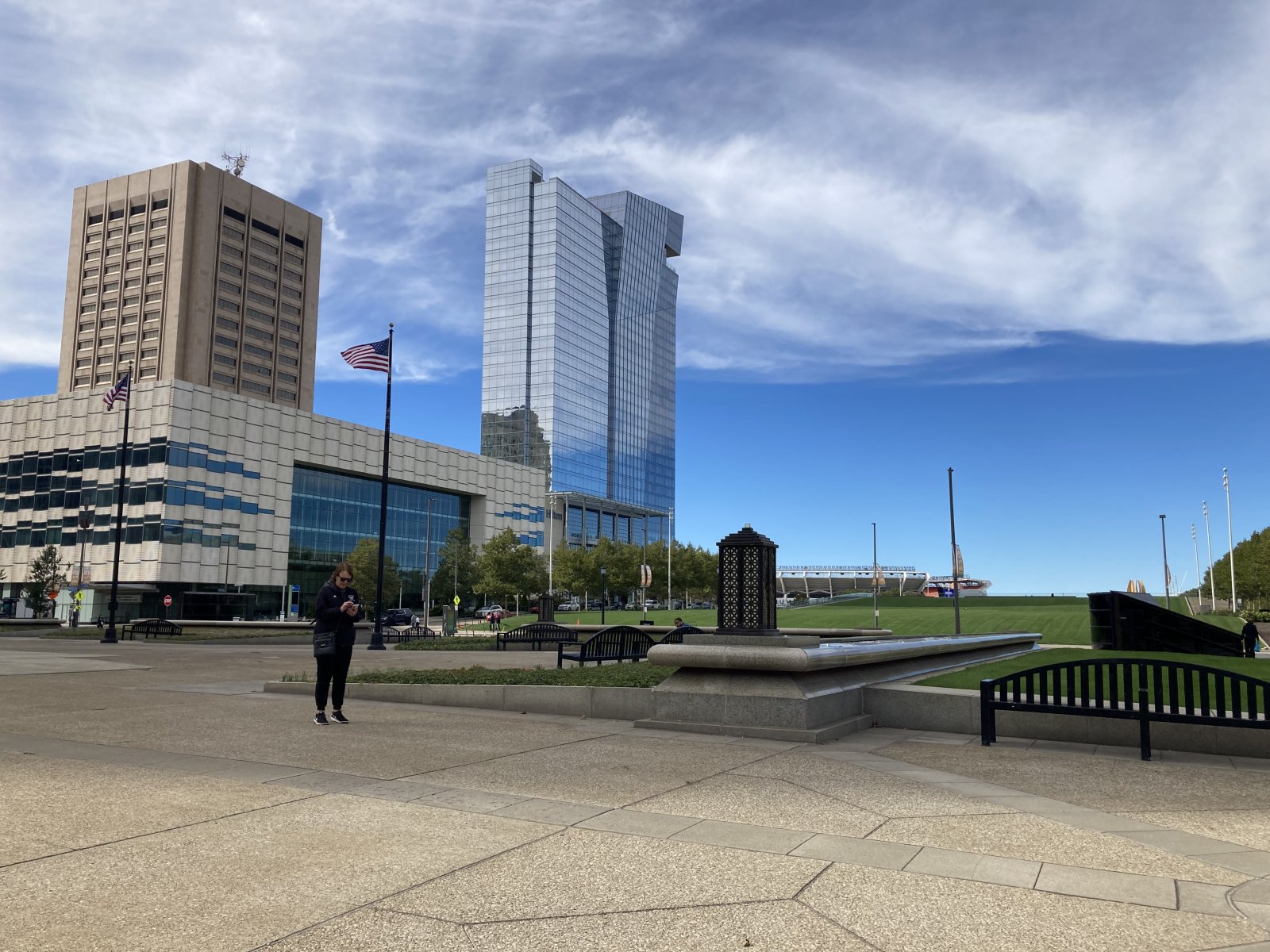 |
|
|
This 1930's-era building used to be the Board of Education building but now it is a Drury Plaza Hotel.
Out in front is the Abraham Lincoln statue.
Lincoln visited Cleveland only twice: once in life and once in death. There are no extant photos of his first visit, which occurred on February 15, 1861, when Lincoln was on his way from Illinois to his inauguration in Washington D.C. Contemporary newspaper accounts captured the excitement as crowds gathered at the elegant Weddell house on the corner of Bank (West 6th) Street and Superior Avenue to hear Lincoln speak from the balcony. The staunchly Democrat Cleveland Plain Dealer briefly put aside its political bias to celebrate the historic occasion.
The Plain Dealer spent much of the next four years criticizing the president and his policies, but it once again put politics aside to mourn Lincoln’s death in April, 1865. The slain president's funeral train arrived in Cleveland on the morning of April 28. The casket was then drawn by horse and carriage to Monument Park (Public Square) followed by a procession of dignitaries and veterans. Thousands of Cleveland area residents gathered in the rain to file past the open casket.
The statue was unveiled with great ceremony on Lincoln's birthday in 1932.
|
| |
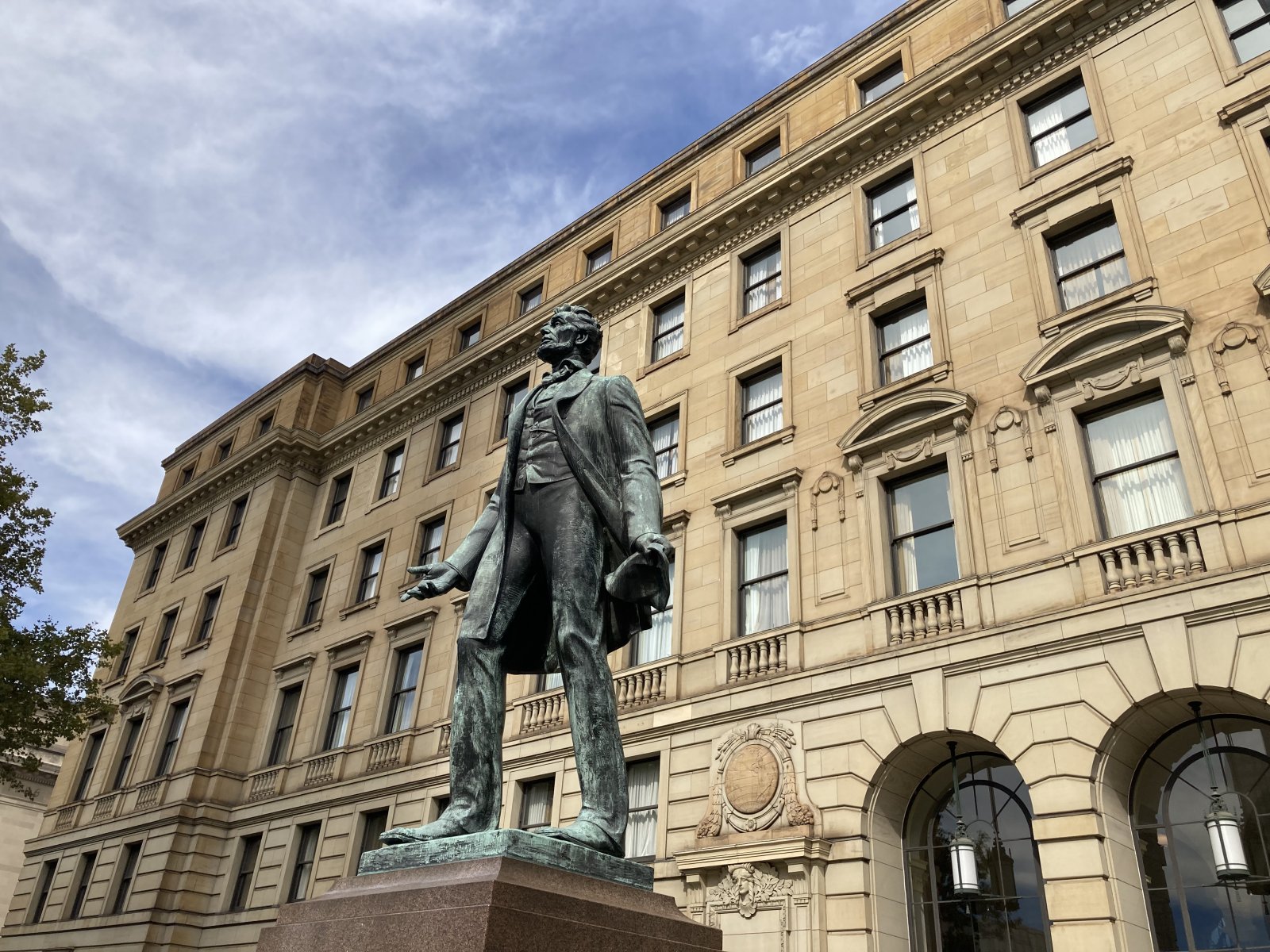 |
|
| The Federal Reserve Bank of Cleveland. The Cleveland Fed is part of the Federal Reserve, the central bank of the United States. |
| |
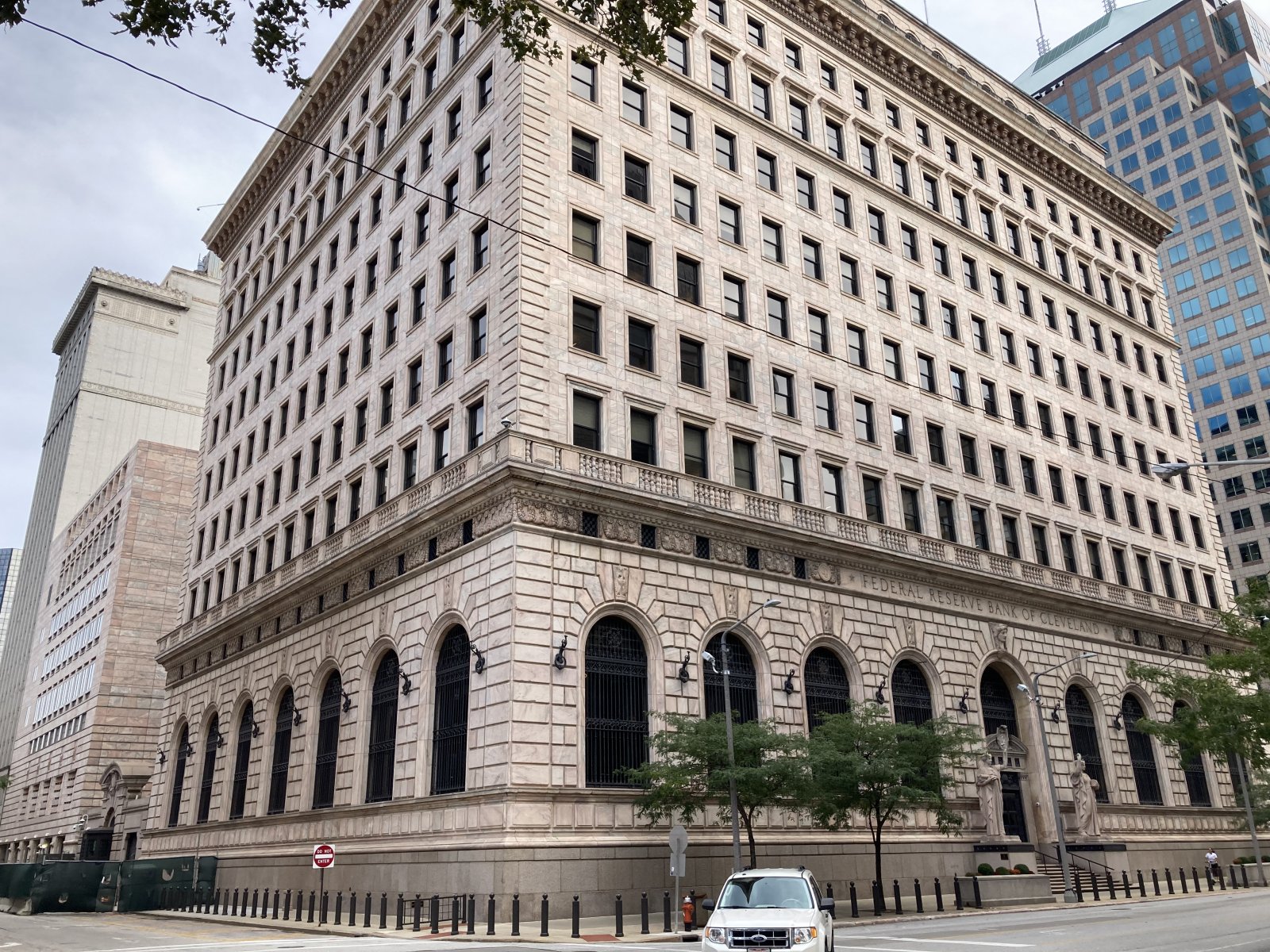 |
|
Sorry, but yet another shot of the Cleveland Public Library. But the real reason for this picture is that it shows the Key Tower in the background, tallest building in Cleveland.
Key Tower was originally built as the Society Center and was the headquarters for Cleveland-based Society Corporation. Society had recently acquired Cleveland Trust and canceled Cleveland Trust's plans for an even taller building on Public Square. Its opening ended the Terminal Tower's 60-year reign as the tallest building in Ohio. When Society Center was completed in 1991 by Turner Construction, it became the tallest building between Chicago and New York City.
|
| |
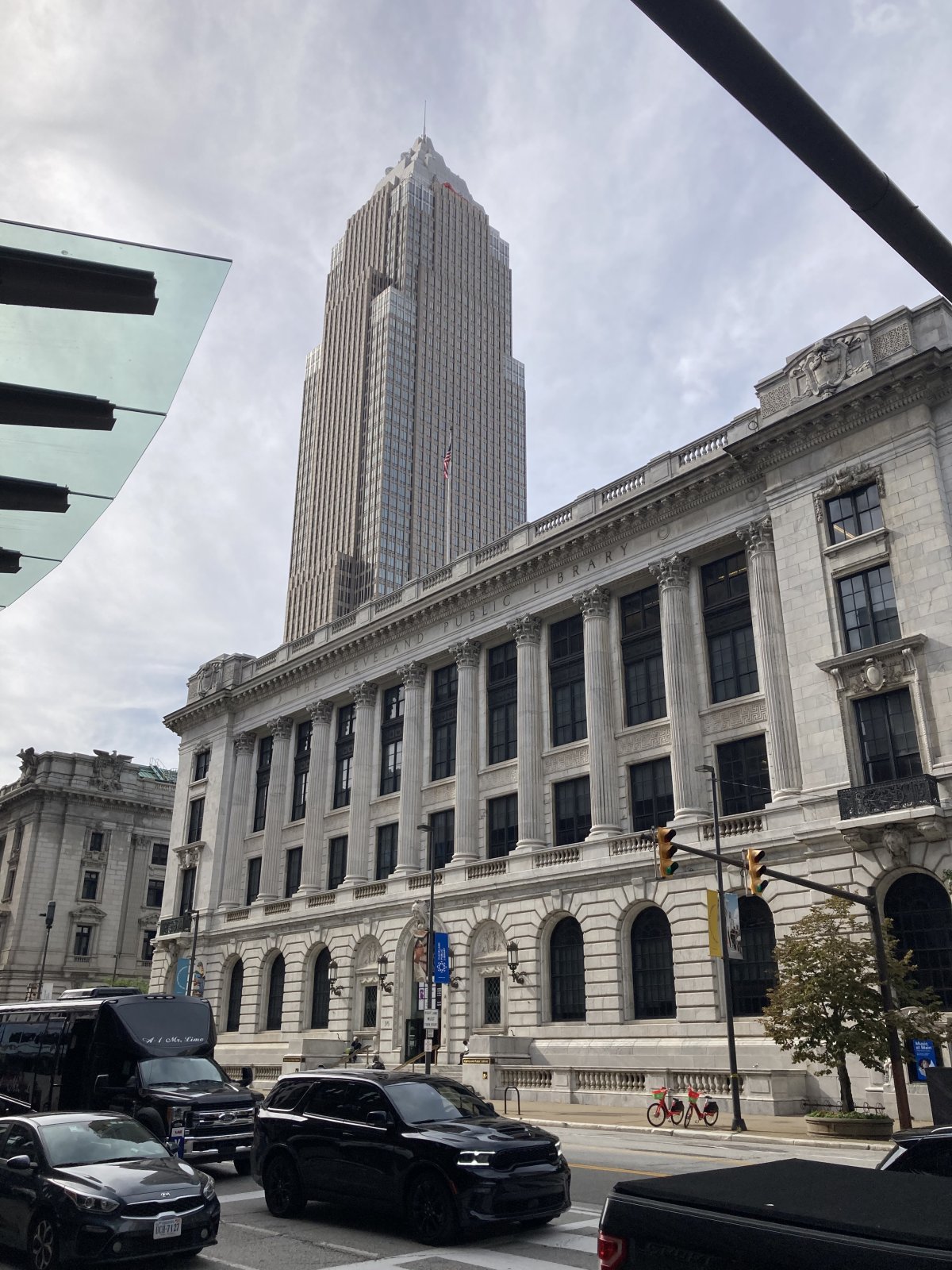 |
|
| One of Cleveland's must-see sights in "The Arcade". A soaring, ornate indoor mall, opened in 1890, it today houses the Hyatt hotel, shops & restaurants. |
| |
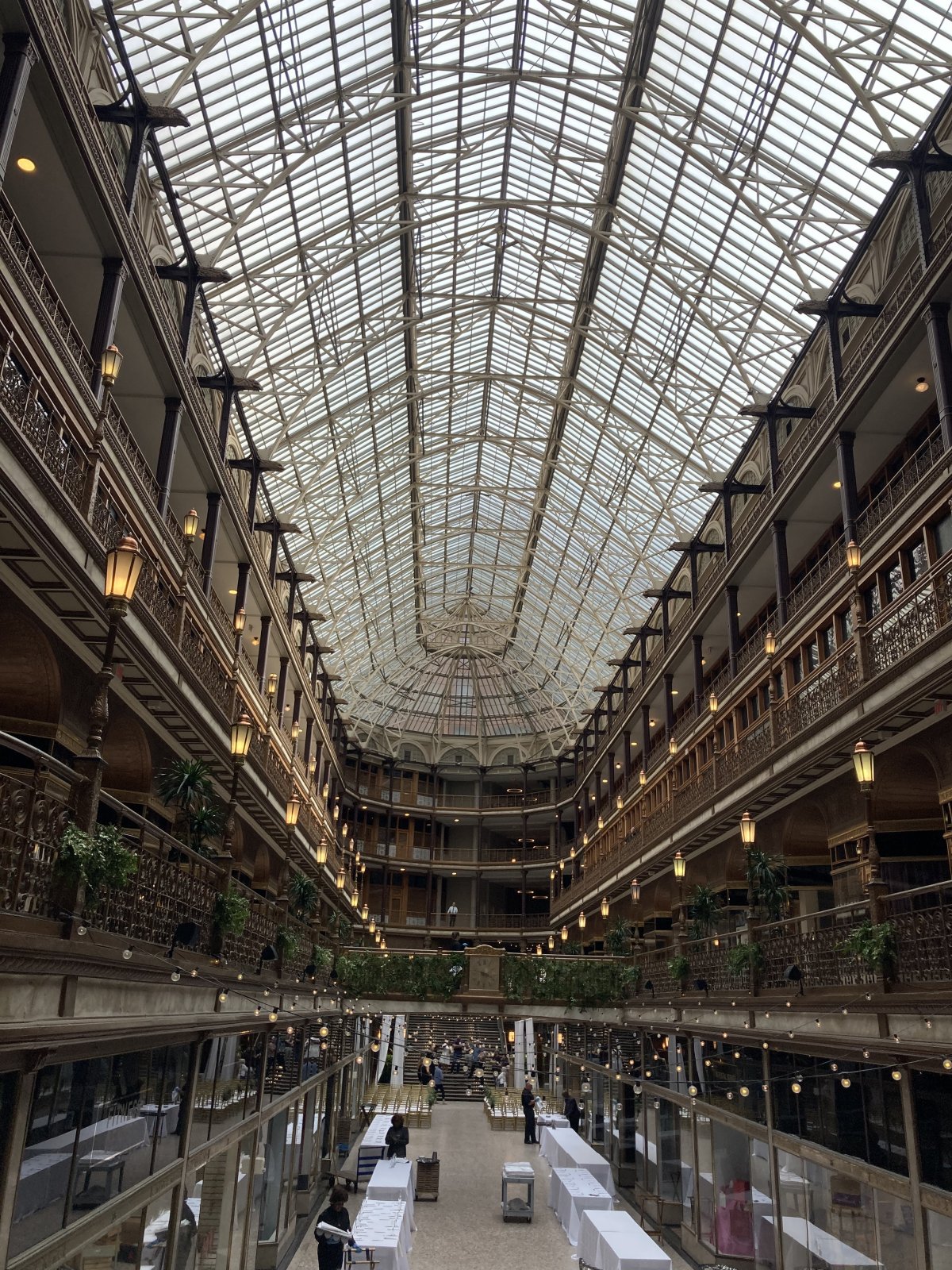 |
|
|
Opened in 1890 at a cost of $875,000, The Arcade Cleveland was America’s inaugural indoor shopping center. “Cleveland’s Crystal Palace,” as it was known then
|
| |
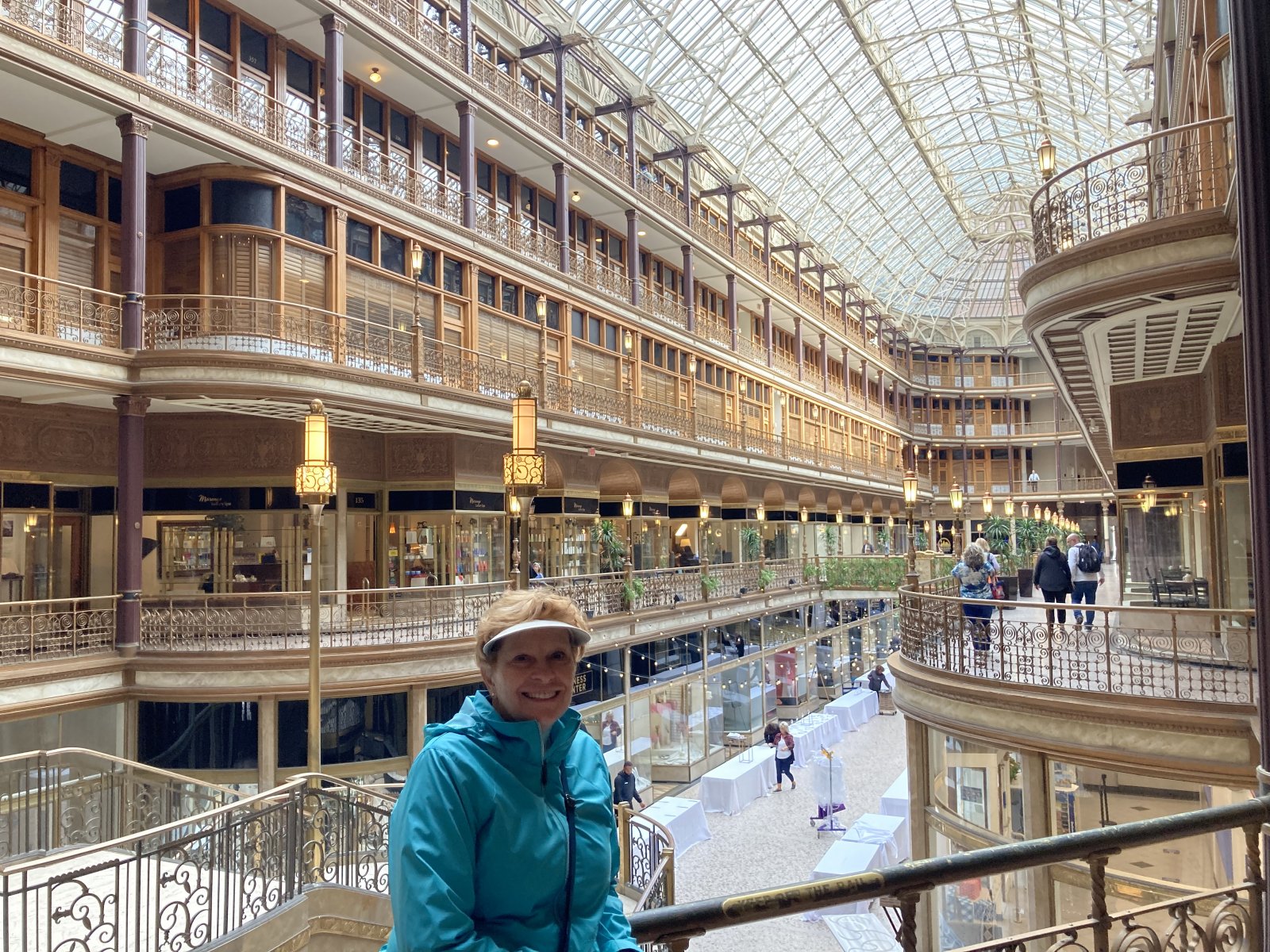 |
|
| The Arcade is used as a Venue for events like weddings, receptions, special dinners, etc. |
| |
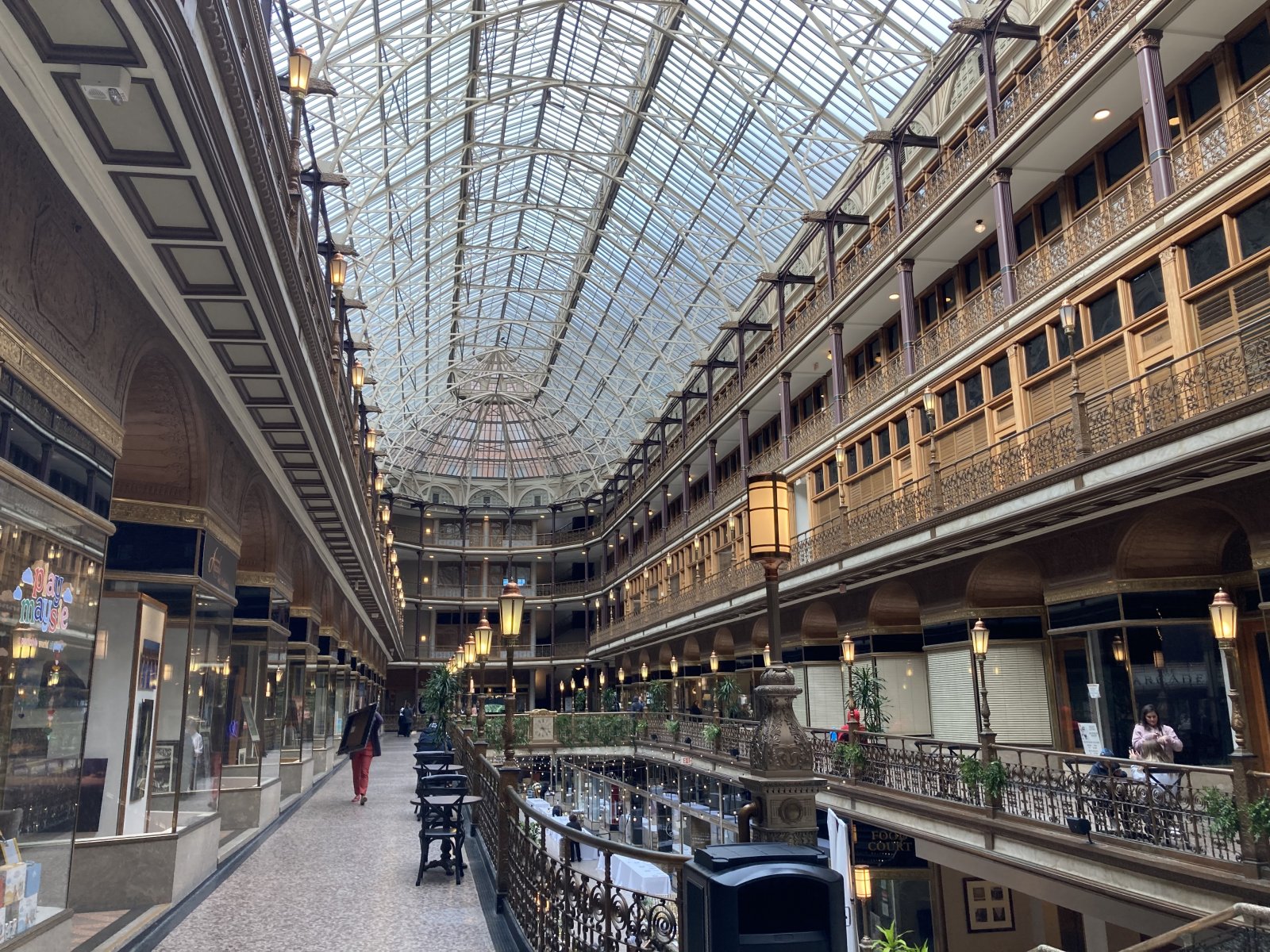 |
|
|
Believe it or not, that building with the rounded dome at the corner of Euclid Avenue and E. 9th. Street is a Grocery Store. It used to be a bank, but now it is Heinen's, an upscale grocery store, with wine-tasting on the second floor.
|
| |
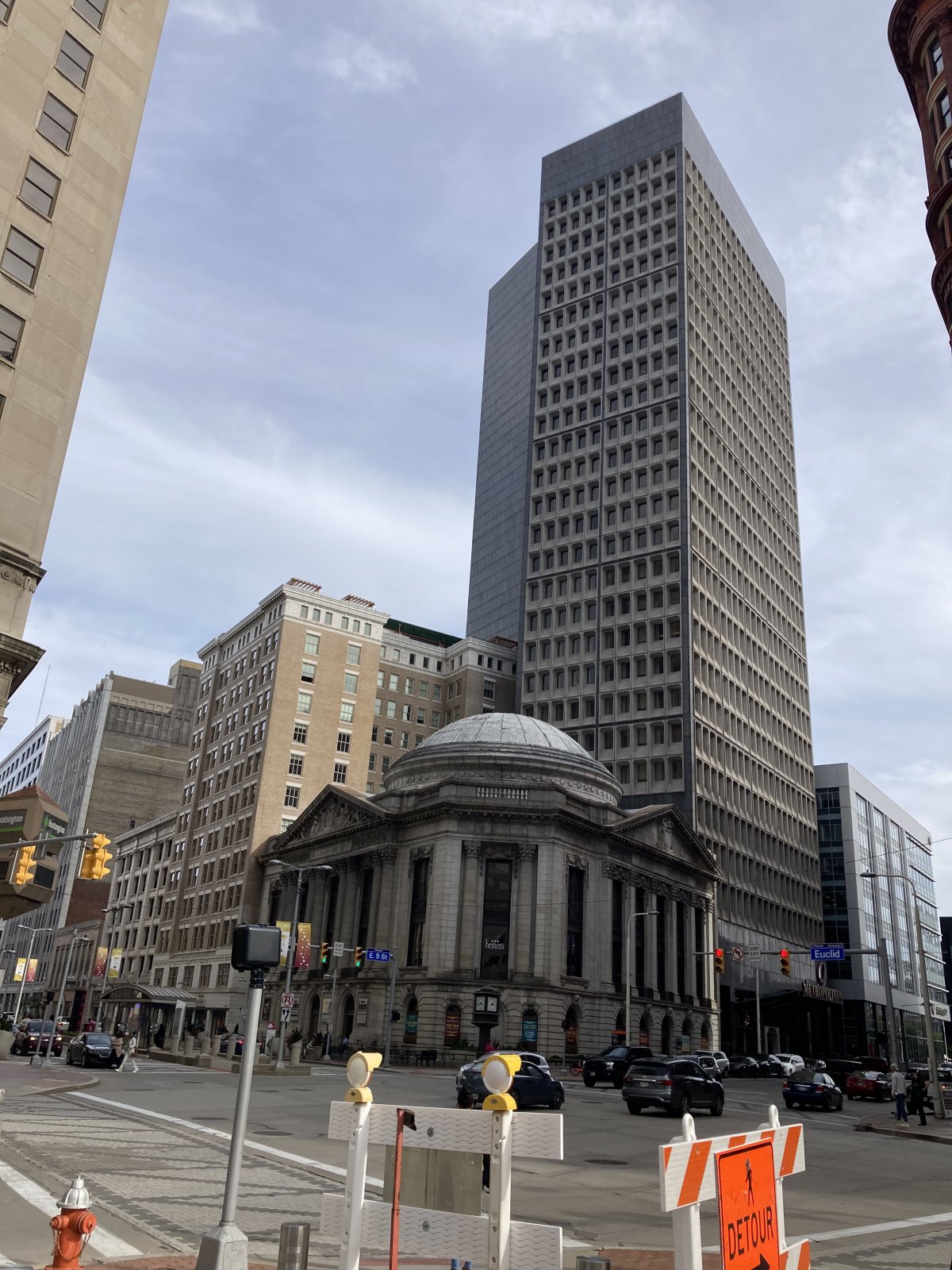 |
|
| Heinen's is listed on one of the top 10 things to do in Cleveland so why not? It's in a stately former bank building, and quite unique. |
| |
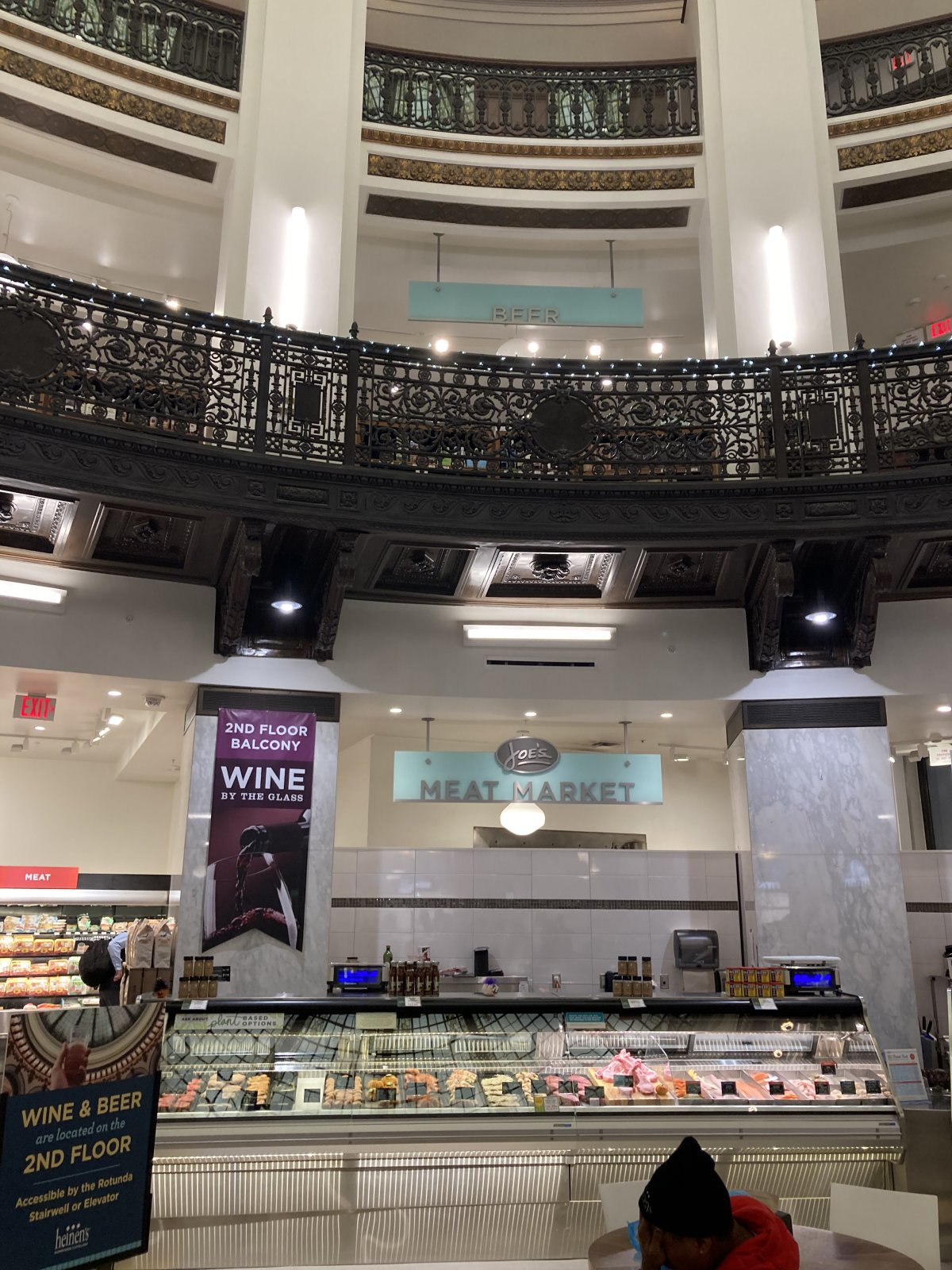 |
|
|
I must say this is the coolest grocery store I've ever seen.
|
| |
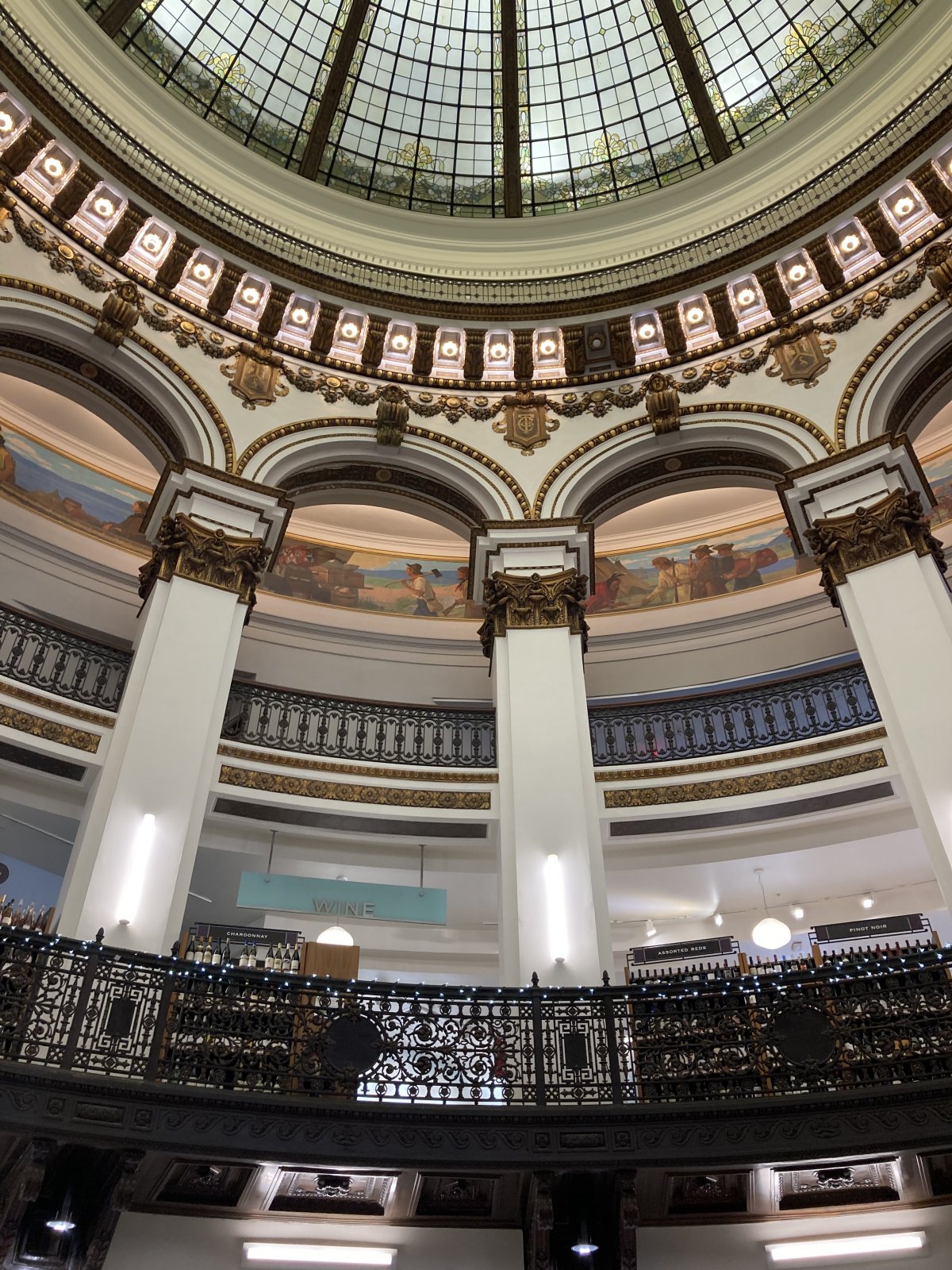 |
|
| Not something you usually see in a grocery store! |
| |
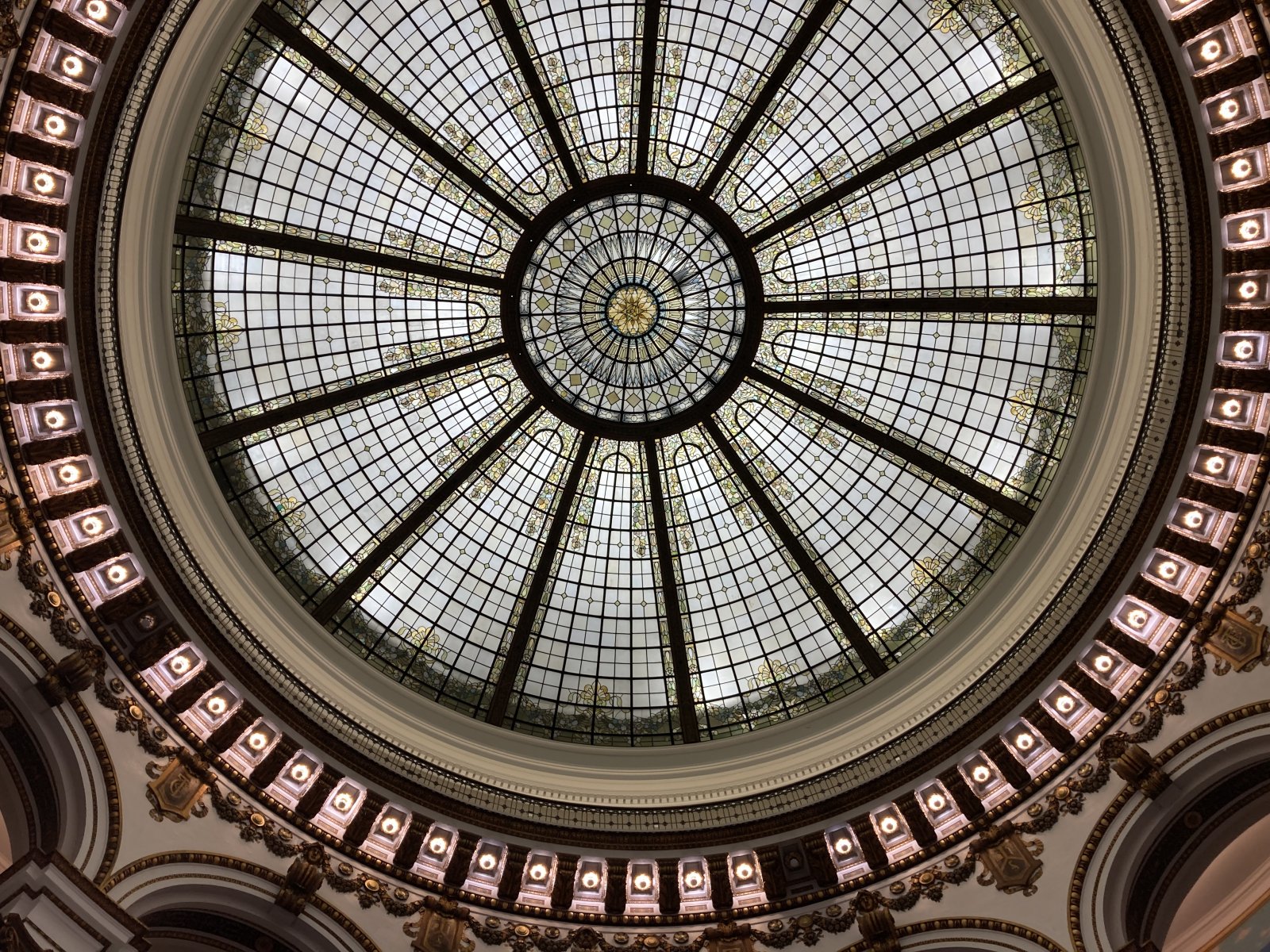 |
|
|
Looking down from the second floor. We enjoyed an ice cream cone here.
|
| |
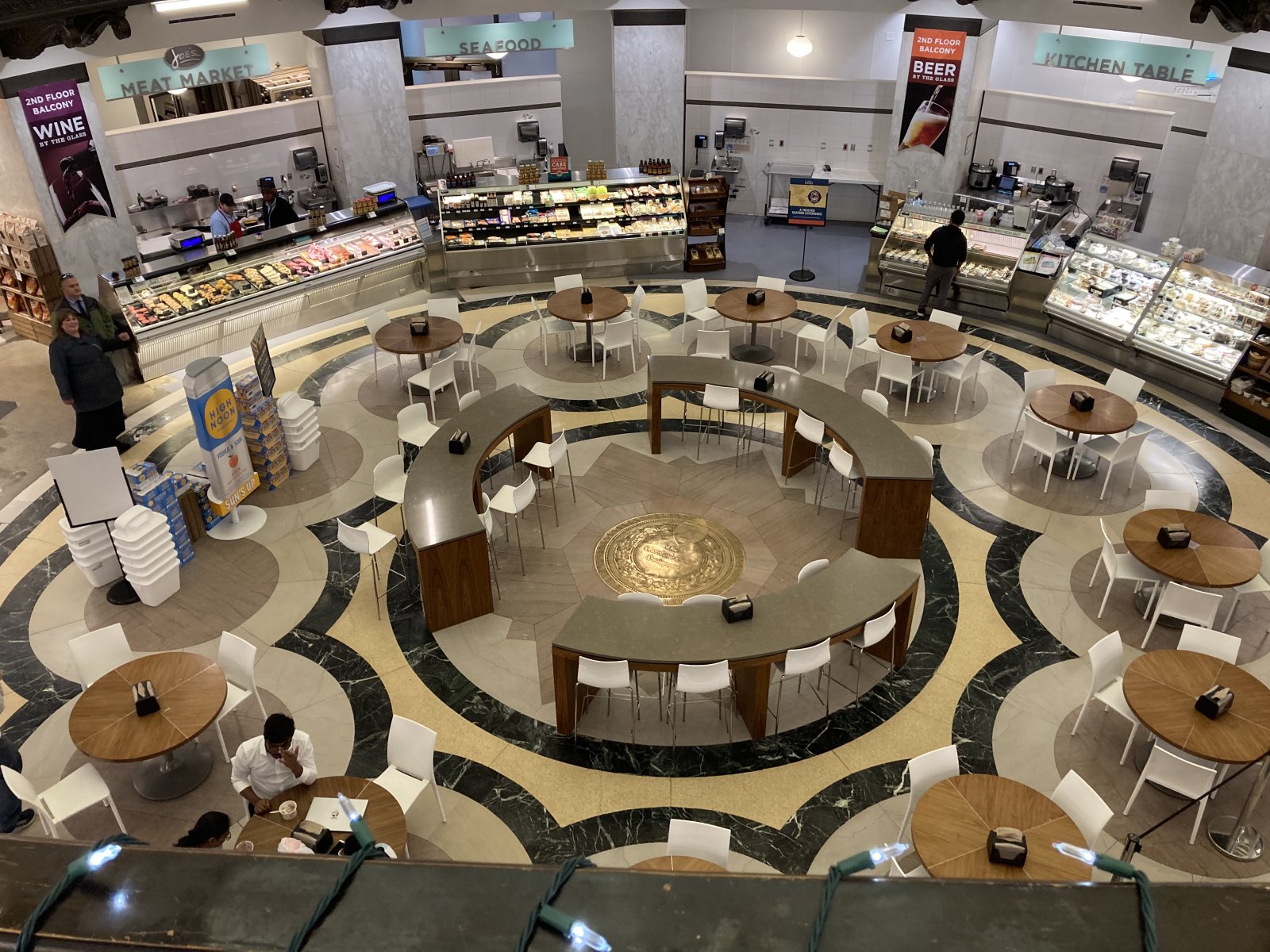 |
|
I was surprised to learn that Cleveland has a large and thriving theater district -- called Playhouse Square -- second only to New York's Broadway.
|
| |
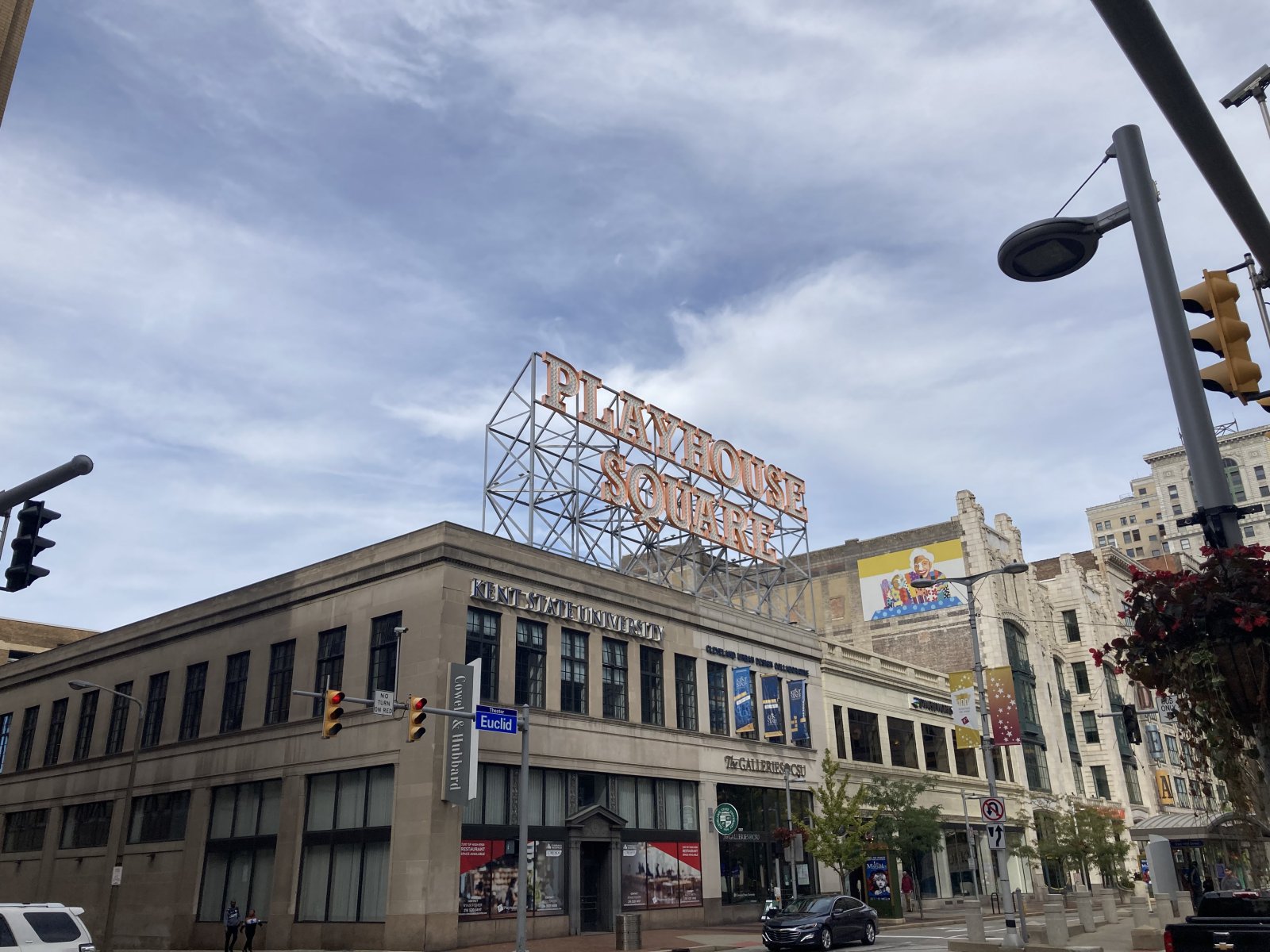 |
|
|
Constructed in a span of 19 months in the early 1920s, the theaters were subsequently closed down, but were revived through a grassroots effort. Their renovation and reopening helped usher in a new era of downtown revitalization in Cleveland, and was called "one of the top ten successes in Cleveland history." There are currently ten theaters and six theater companies.
The Walking Tour ended here in Playhouse Square.
|
| |
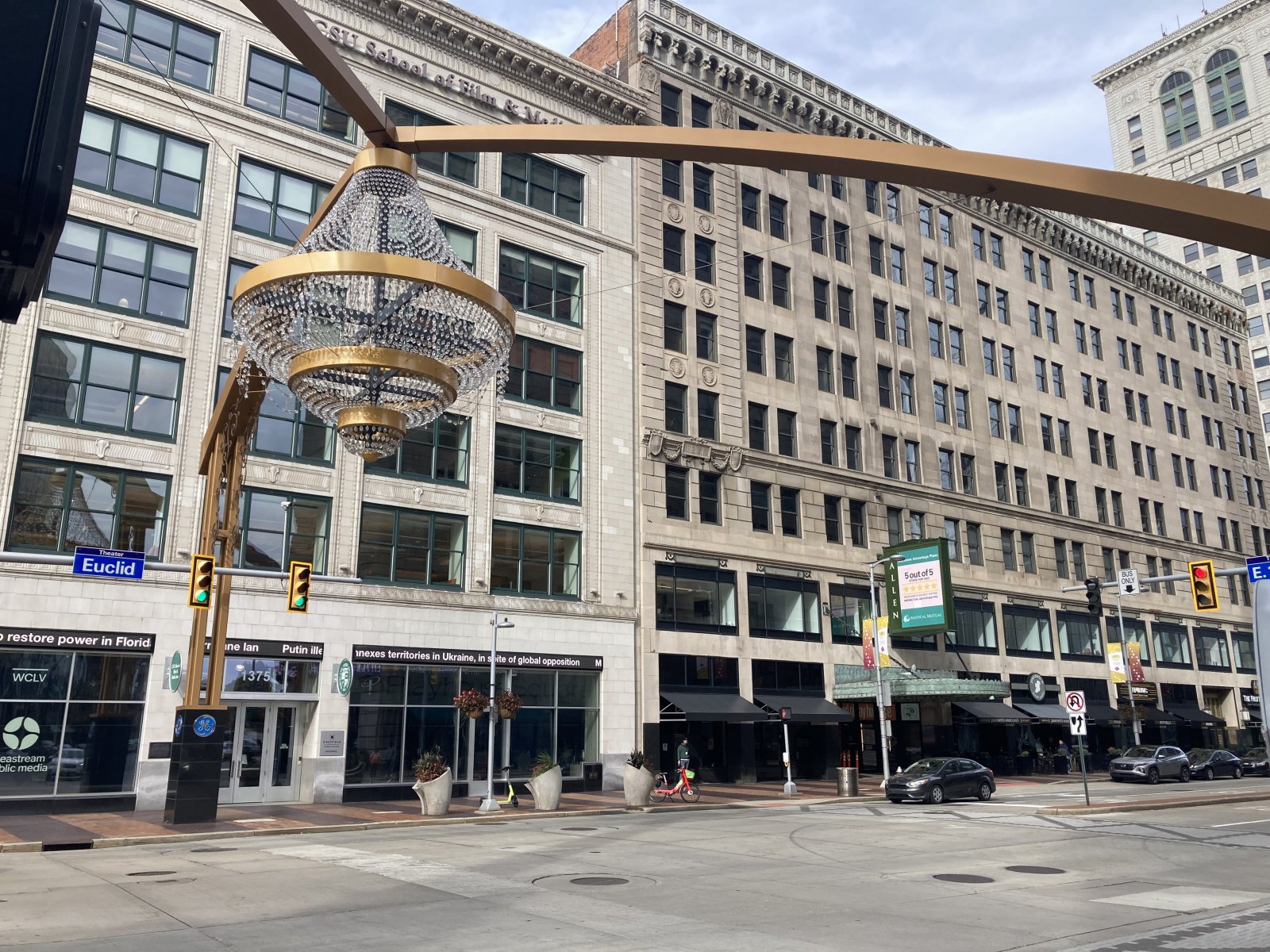 |
|
|
On the way back, we checked out the Civil War Soldiers and Sailors Monument, also on the town square. The monument honors the more than 9,000 individuals from Cuyahoga County who served the Union throughout the war. It was dedicated on July 4, 1894.
On April 28, 1865, the casket of President Abraham Lincoln was on public view in Public Square during his body's trip back to Illinois.
|
| |
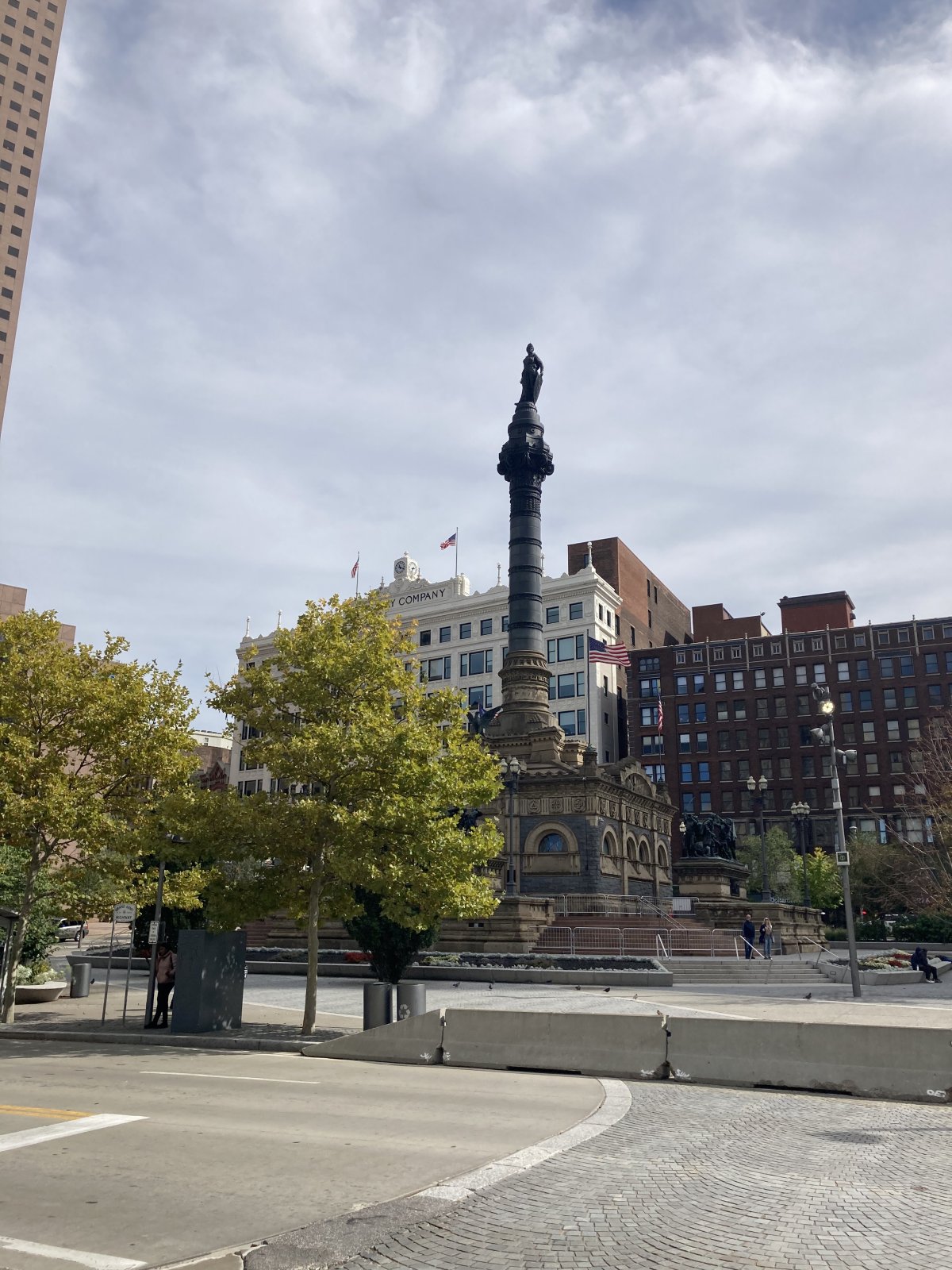 |
|
|
Inside the memorial are interesting four large bronze panels on the inner walls. The bronze panels include life-size depictions of allegorical scenes relating to the Civil War.
This panel is called "The Peace-Makers at City Point" which depicts an allegorical meeting between Abraham Lincoln and his generals and admirals discussing how the war would be brought to an end. Although not all of the men depicted in this panel were in the same place at the same time, the depiction was inspired by an actual council of war that occurred in March 1865 between President Lincoln, General Ulysses Grant, General William Sherman, and Admiral David Porter abroad the steamship called the River Queen near City Point, Virginia. At this meeting that Lincoln expressed his desire for a swift end to the war and magnanimous treatment of the rebels thereafter. General Sherman's aggressive posture in this panel represents his opposition to Lincoln's desires, favoring a much more aggressive strategy. Lincoln stands calmly, contrasting Sherman's stance while Grant stands off to the side.
The panel mirrors the well-known 1868 painting called The Peacemakers by George P. A. Healy.
Individuals Depicted: George A. Custer, Phillip H. Sheridan, George Crook, Ulysses S. Grant, John A. Rawlins, Abraham Lincoln, Robert T. Lincoln, Mortimer D. Leggett, Wm.T. Sherman, G.K. Warren, George G. Meade, E.O.C. Ord, David D. Porter, A.A. Humphreys
|
| |
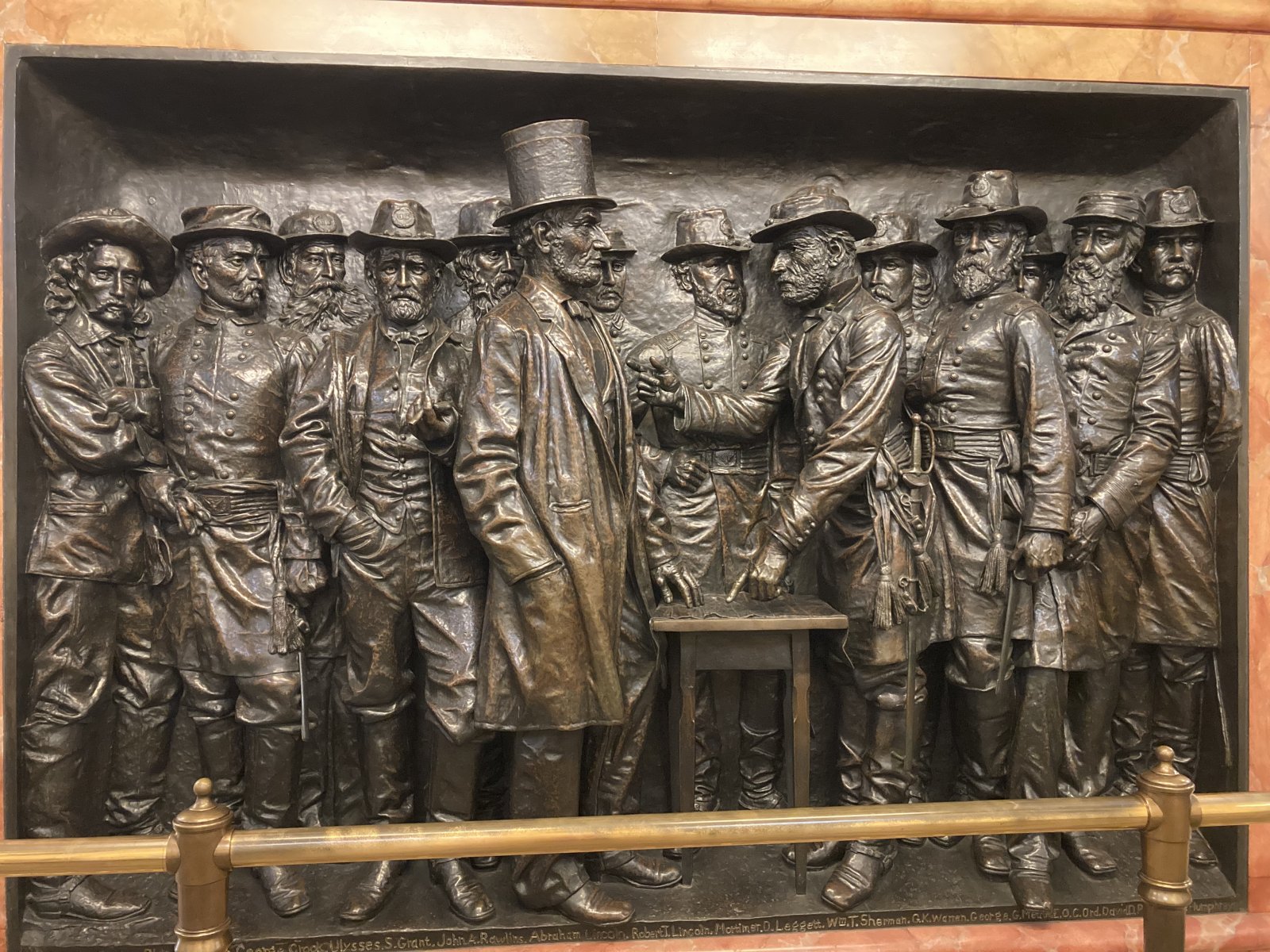 |
|
The Emancipation Panel represents two important pieces of federal legislation: the Emancipation Proclamation and the creation of the United States Colored Troops. Behind Abraham Lincoln stand four major figures from Ohio who fought for emancipation: Joshua R. Giddings, Benjamin Wade, Salmon P. Chase, and John Sherman. Abraham Lincoln, who stands at the center, is seen handing a union rifle to an African-American man named Dan R. Field who is seen being sworn into the Army. The panel faces North.
Individuals Depicted: John Sherman, Salmon P. Chase, Dan R. Field, Abraham Lincoln, Benjamin F. Wade, Joshua R. Giddings.
|
| |
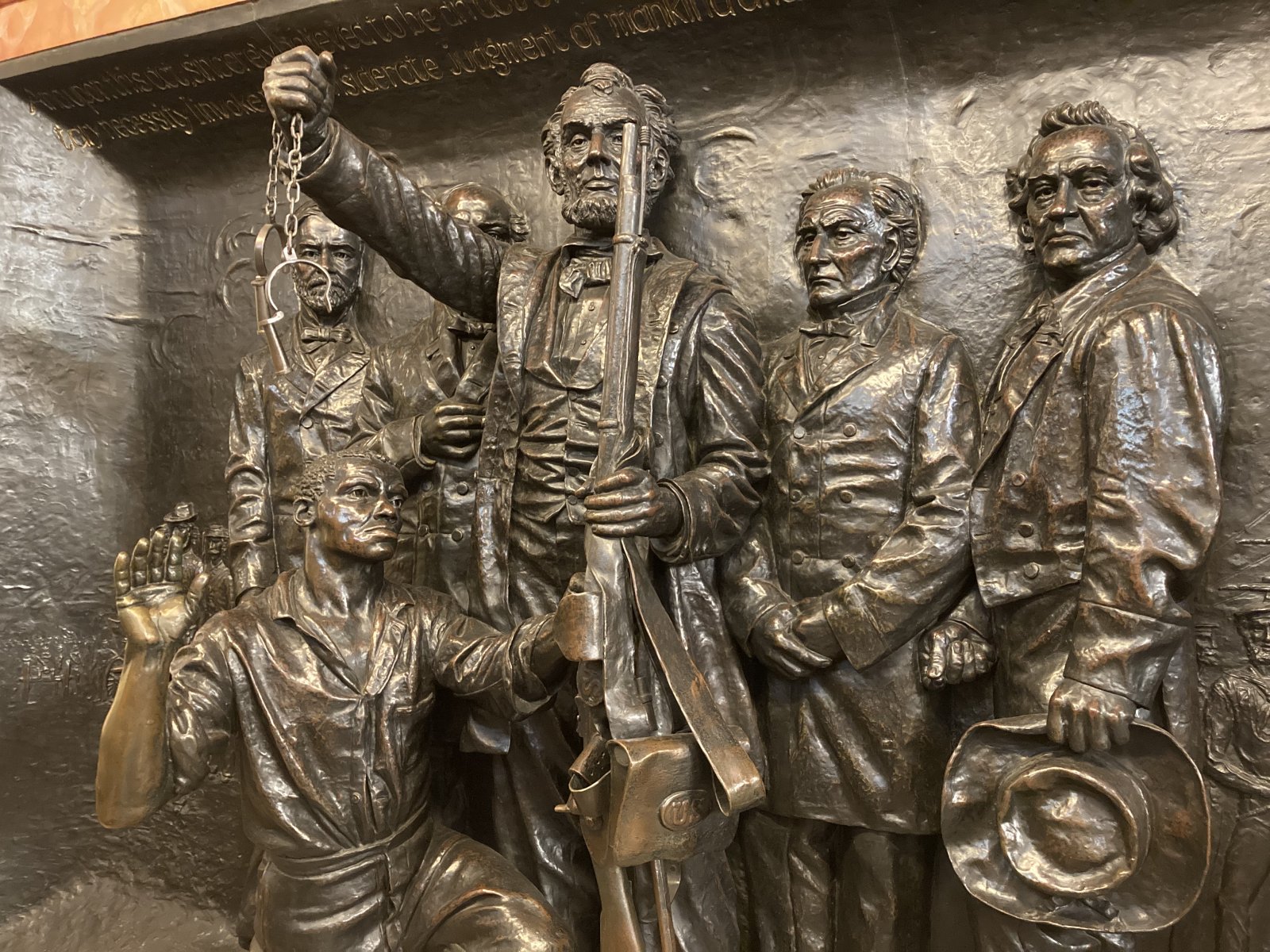 |
|
|
There were some artifacts on display including this original letter from Abraham Lincoln to the Senate nominating U.S. Grant to be a Lieutenant General giving him command of all Union Armies. Grant's new rank had only previously been held by George Washington.
|
| |
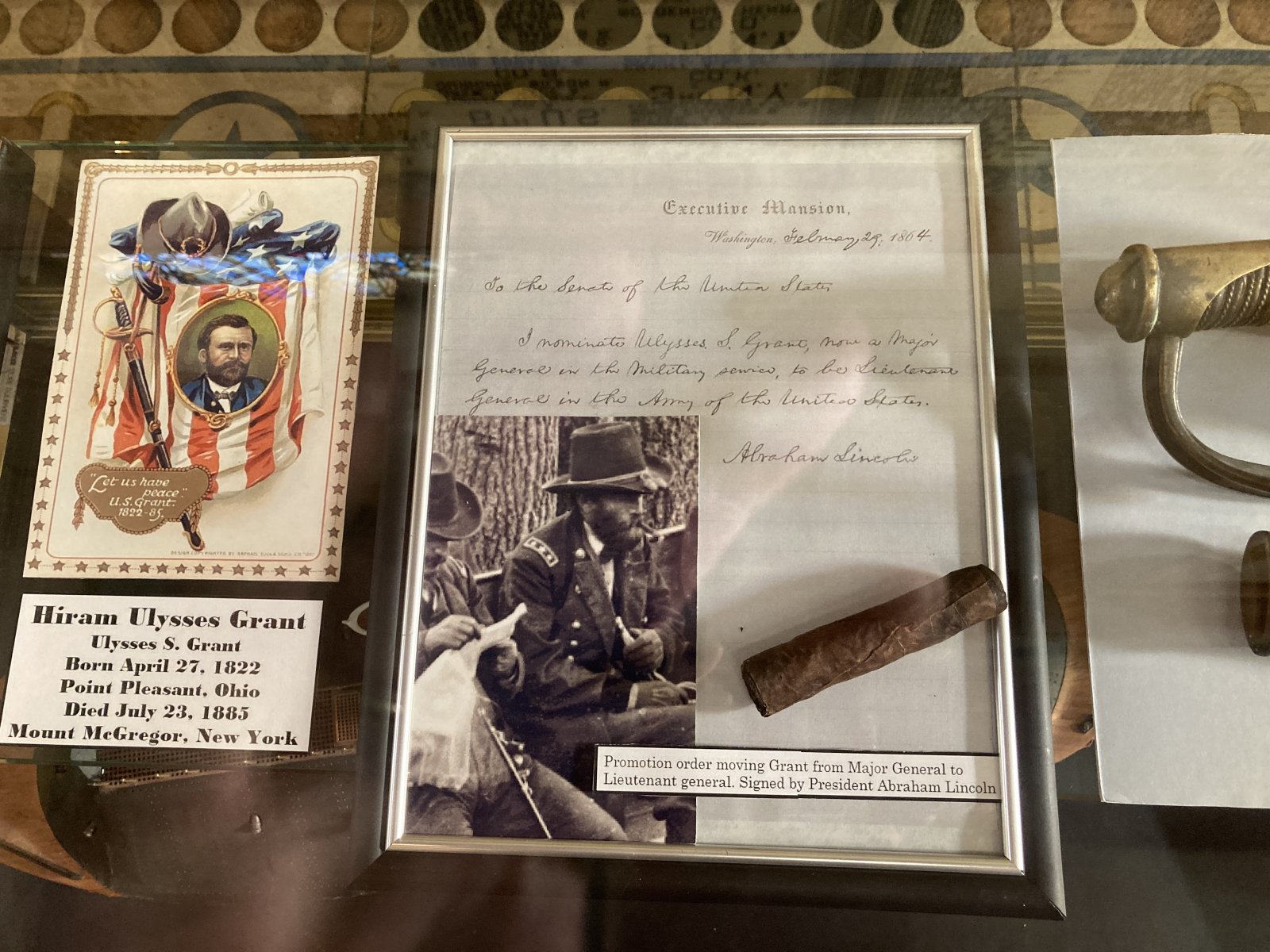 |
|
|
Surrounding the Monument outside are four large bronze statuary groupings: Mortar Practice, At Short Range, The Color Guard, and the Advanced Guard. The bronze statuary groupings stand atop Berea sandstone pedestals and depict scenes featuring the four branches of the armed forces at the time of the Civil War.
This is the Advanced Guard statue which honors the Cavalry. It depicts a Union detachment that has encountered enemy troops. A Union trooper, still astride his injured horse, is seen firing his pistol at an enemy soldier at point blank range. Another Union soldier is seen aiming his carbine southward. A bugler stands at the edge of the scene, summoning help for the embattled Union soldiers.
|
| |
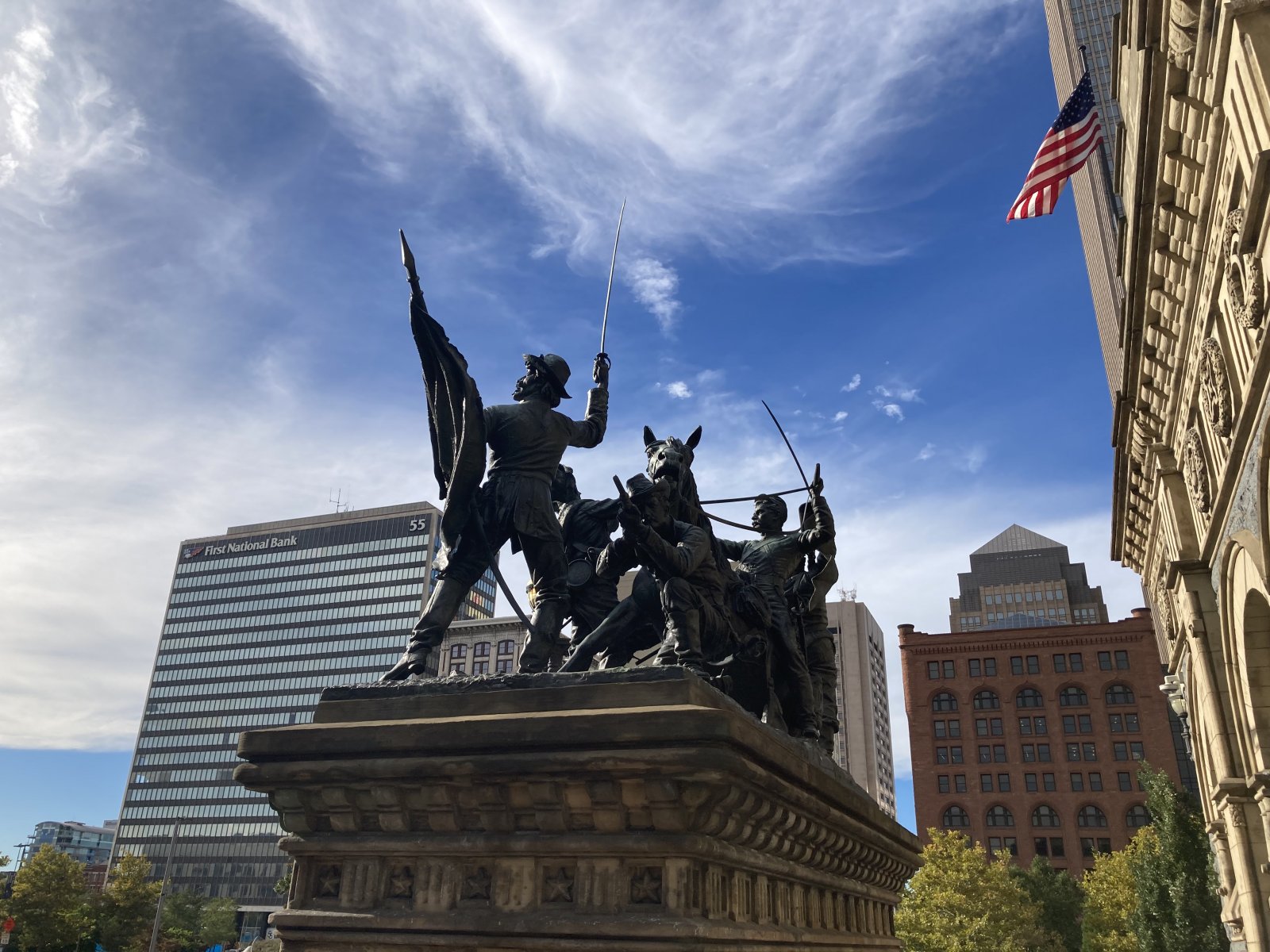 |
|
|
Also on the Public Square, a statue of General Moses Cleaveland, founder of Cleveland.
Moses Cleaveland (January 29, 1754 – November 16, 1806) was an American lawyer, politician, soldier, and surveyor from Connecticut who founded the city of Cleveland, Ohio, while surveying the Connecticut Western Reserve in 1796. During the American Revolution, Cleaveland was the brigadier general of the Connecticut militia.
You are probably wondering why the settlement of "Cleaveland" is now called "Cleveland". One theory is that Cleaveland's surveying party misspelled the name on their original map. More than likely though, the story goes back to the Cleveland Advertiser, a local paper in the early 1800s. They could not fit the words “Cleaveland Advertiser” on their masthead, so they dropped the extra “a” to make room and the name stuck.
|
| |
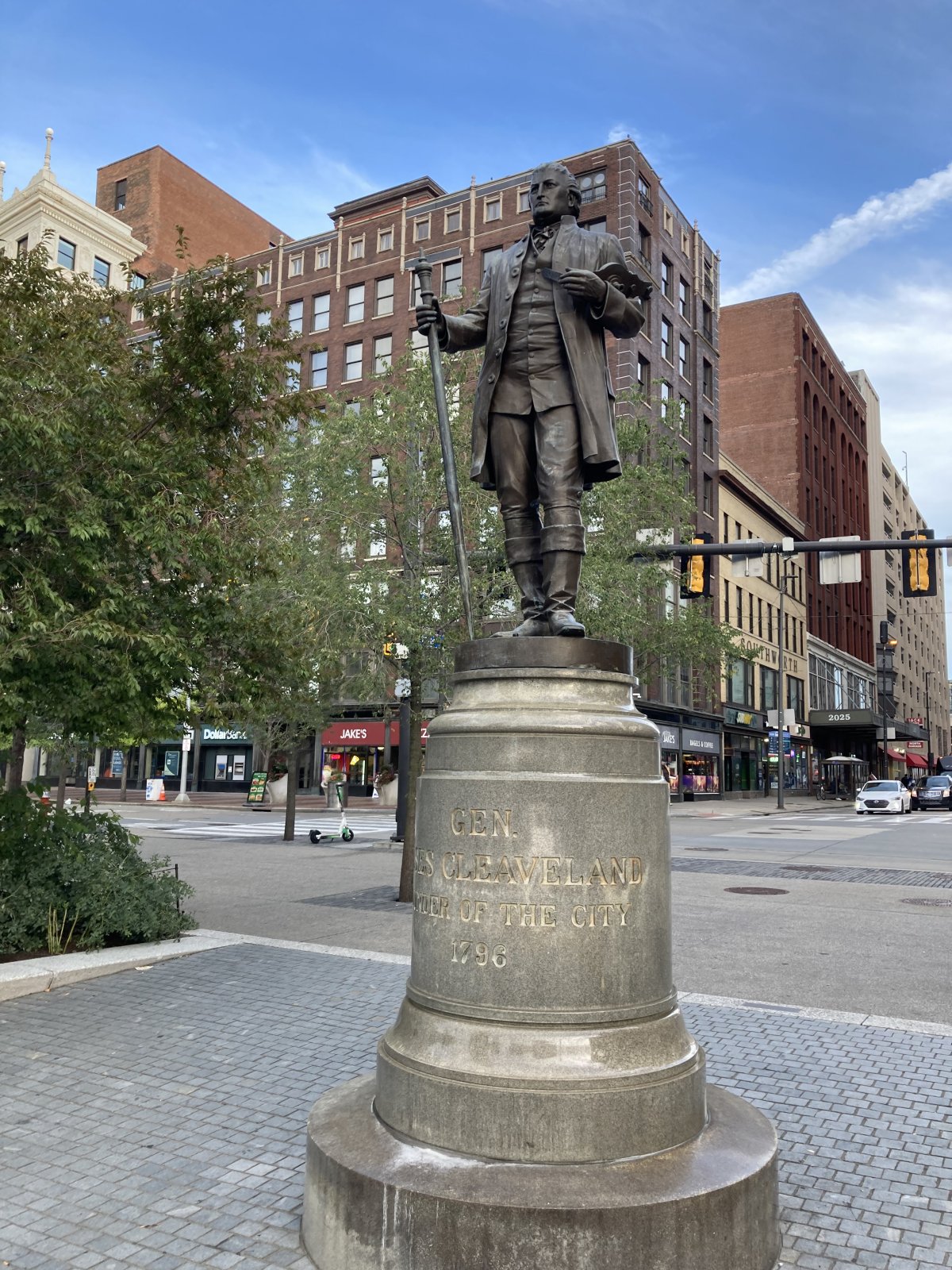 |
|
|
Our last night, we were in our AirBnb apartment when we heard massive fireworks going off. For at least ten minutes! We wondered what was going on, and went to the roof of the building. There was no official fireworks event going off; somebody just decided to blow off hundreds of bucks worthof fireworks. But we we stunned to discover what a pretty view of the city was to be had from the roof of our building. This picture is blurry but you can see Key Tower at center and the Terminal Tower lighted up in Cleveland Guardian colors at right.
|
| |
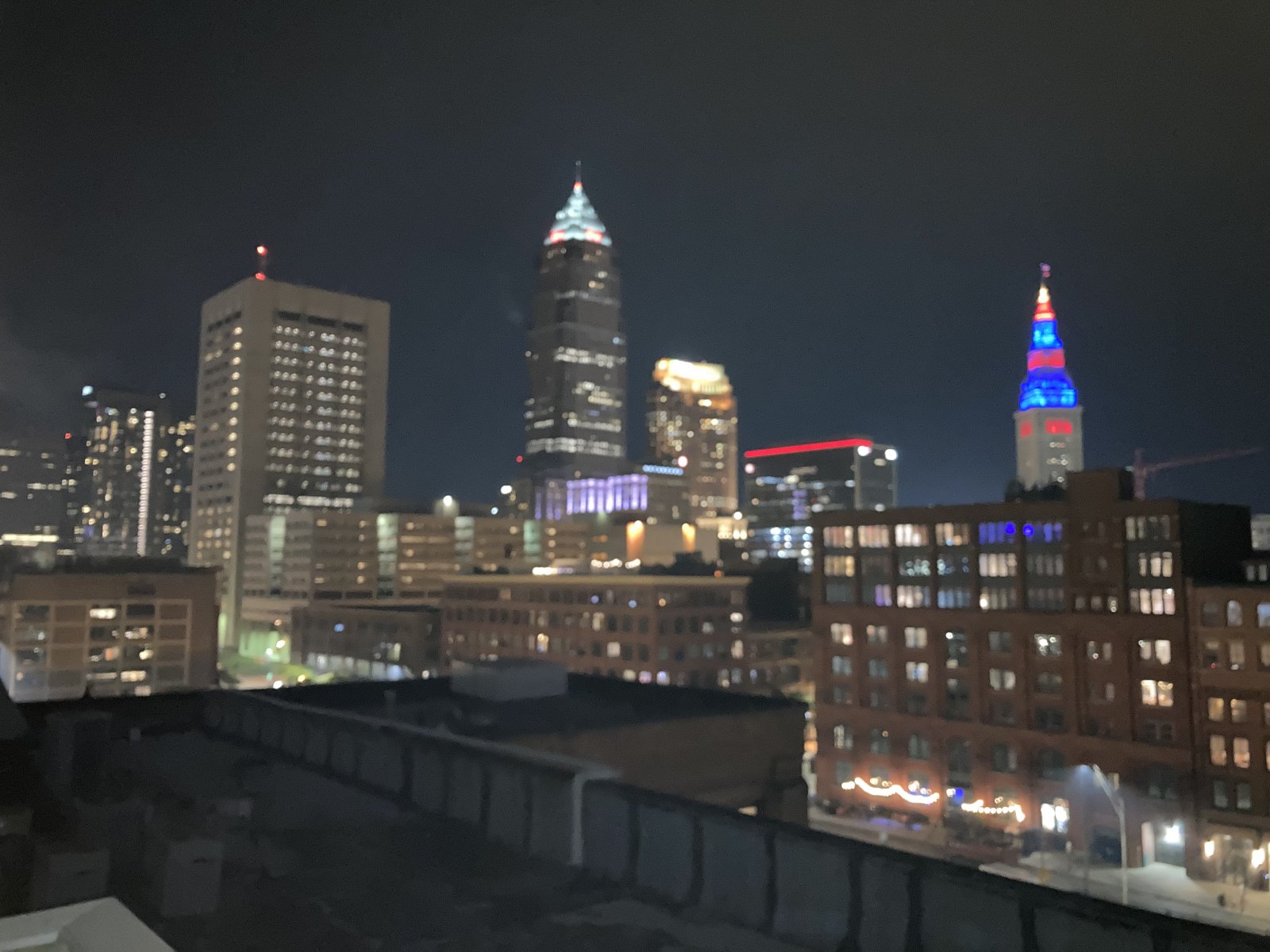 |
|
| |
| |
|
|
|
|
|
|
























































